It’s time to appreciate the Lancia Thesis
Forgive us, Lancia Thesis, for the world was never meant for one as beautiful as you.
In the decade since its demise, the Lancia Thesis has been propping up lazy ‘ugly car‘ lists across the internet, deemed worthy of little more than the merest mention in the context of its jaw-droppingly elegant rear lights. The wood enthusiasts in Malvern saw enough beauty in the Thesis to borrow the ‘microbulb’ lights for the Aeromax.
For sure, the Lancia Thesis looks a little weird, certainly in the context of its contemporary German rivals. But looking slightly odd has never hampered Martin Clunes, so why did the world fail to embrace the Thesis?
British buyers didn’t have a choice. The Thesis never made it to these shores, Lancia only returning to the UK under the cover of Chrysler.
It wouldn’t have stood a chance. Faced by the collective might of the 5 Series, E-Class and A6, the elegant Lancia would have been lost beneath a deluge of faeces-related quips.
“The time is ripe for Thesis,” said Lancia in 2001, in a statement unrelated to faecal matter.
The Thesis was borne out of the Dialogos concept of 1998 , a car with swivelling armchairs rather than seats, an absence of door handles, pillar-less entry, suicide rear doors, and an ability to switch between left- and right-hand-drive.


You're really spoiling us
It allowed Lancia to “conceive the idea of stress-free driving and envisage the passenger compartment as both ideal microclimate and living room,” said the company.
What’s remarkable is how much of the Dialogos styling made it into production. The front and rear are straight outta concept, but Lancia lost its nerve when building the bit in the middle. With the B-pillar in place, door handles in situ, standard rear doors, and Vanden Plas-style chrome strip along the side, the Thesis looked more like a low-rent Korean rental car in profile.
In fairness, the Thesis did a fine job of hiding its size. At 4.88 metres in length, this Italian saloon is knocking on the door of Range Rover territory, but while SUVs are aggressive and crude machines, the Thesis puts on a display of restraint and splendour. This is a car for arriving at ambassadorial receptions, not in the car park of a Premier League football ground.
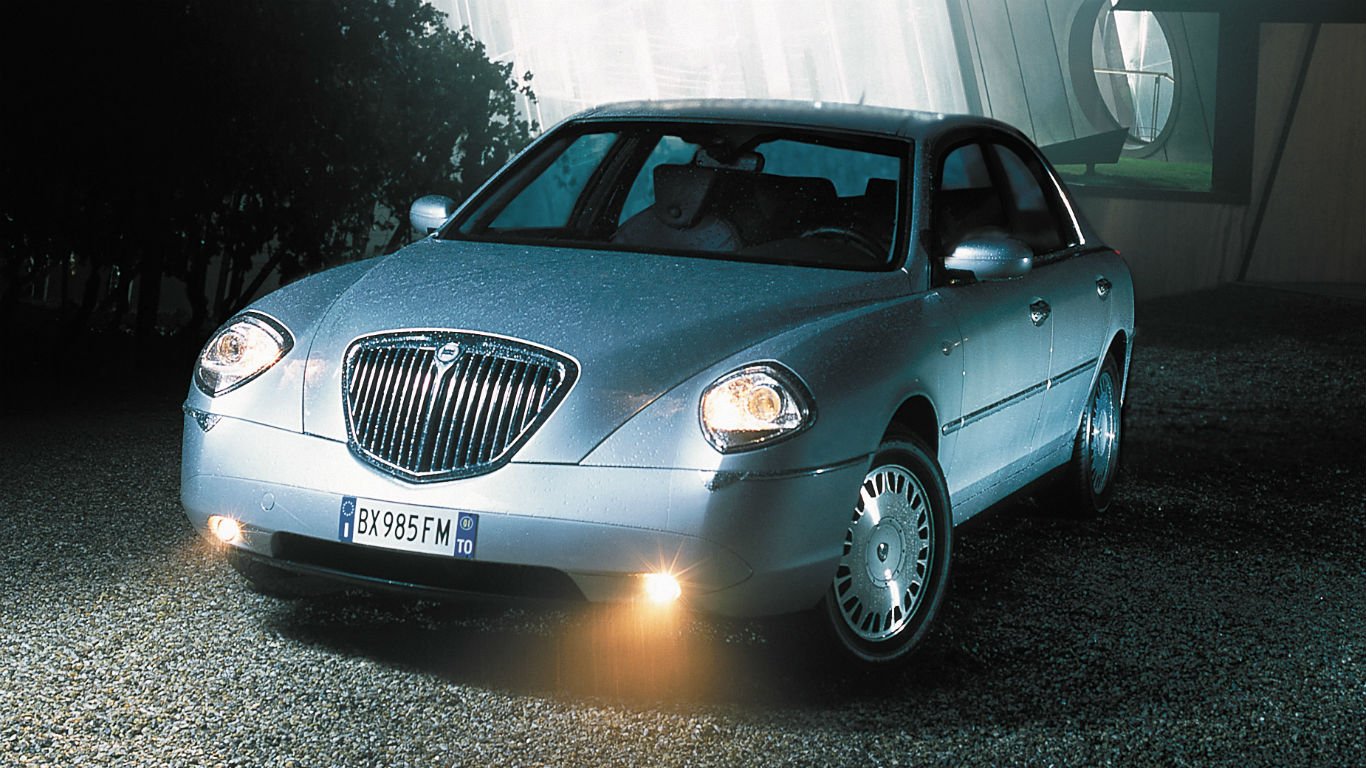
The Italian Scorpio?
Which is the point of the Lancia Thesis. If you’ve ever seen a Thesis at night, you will have admired the diamond-shaped xenon headlights and the almost surreal beauty of the LED rear lights. There are just two 1cm wide strips: one red and one orange. Pure class.
If the jury is out on the interior styling – did somebody say ‘Italian Ford Scorpio ’? – there’s little to debate when it comes to the cabin. The dials were a welcome nod to the Aurelia and Flaminia, with the instruments set off against a soft blue background. Meanwhile, wood, leather, Alcantara and magnesium combined to create an interior that looked and felt a class above the ‘premium’ execs jostling for position on the Autostrade.
Naturally, you’d want the Alfa-sourced 3.0-litre V6 combined with the Comfortronic transmission for maximum waft, but don’t discount the 2.4-litre five-cylinder for aural pleasure. The 2.0-litre turbo was the quickest to 60 and delivered more torque than the 2.4-litre JTD. A diesel in a Thesis? No thanks.

Lancia spent big bucks on the Thesis, resisting the temptation to base the car on a stretched Alfa Romeo 166 platform. The result was a car that rode as well as any luxury car, helped in no small part by the so-called ‘Skyhook’ semi-active damping system. It used sensors to select the optimum damping force required by each shock absorber, to deliver a soft and controlled ride.
Poltrona Frau soft leather was an option, with heated front seats standard on the top-spec models. Tick the right box and your Thesis could leave the back passage of the showroom with ventilated massage seats in the front, and heated massage seats in the back. Thanks to its long wheelbase, the Thesis offered a huge amount of rear legroom. This was a car to drive and to be driven in.
A seven-inch display, voice control, Bose sound system, adaptive cruise control, eight airbags, front and rear parking sensors, and keyless entry wouldn’t look out of place on a spec list today.
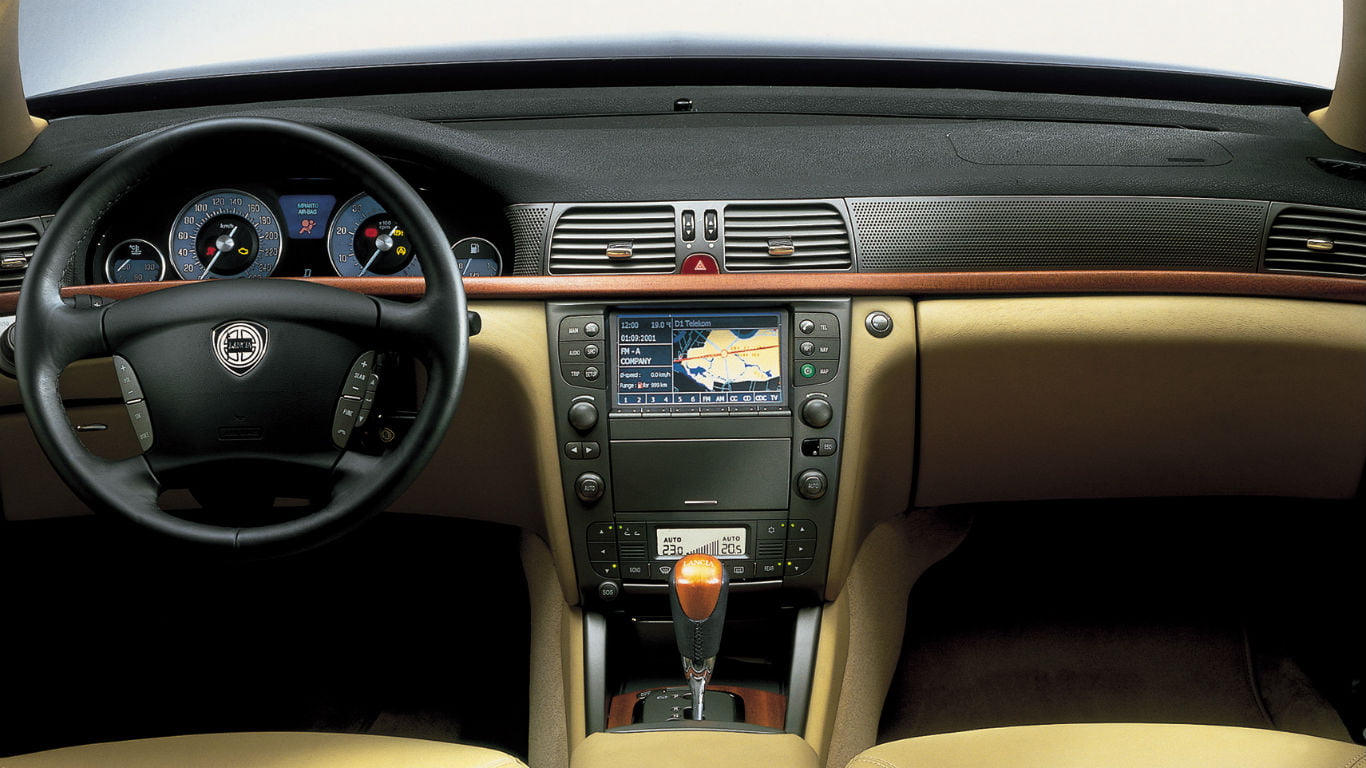
Home delivery
Lancia also knew how to make a customer feel special. Cars were delivered to the doors of potential clients for a test drive, while showroom staff were trained solely to deal with the Thesis. Once purchased, the car would be delivered to the customer’s home or office by the salesperson who sold the car. A few days later, the dealer principal would call to ensure that everything is in order.
The company promises lifetime ‘Home Service‘ cover, which included collection within 48 hours following a report of any faults, a loan car while the Thesis was in for repair, and a dedicated freephone number. Could any lucky Thesis owners could report on the effectiveness of this service?
Maybe it’s the passing of time or simply the increasing number of over-styled SUVs on our roads, but the Lancia Thesis appears to be ageing like a fine Italian wine. Those front and rear bumpers, free of clutter, look delightful, while the overall design, which might have looked out of place at the turn of the millennium, is most welcome in 2019.
Everything in context. Picture yourself driving home from the opera in a Thesis; the world is monochrome as your tyres roll across the gravel outside your immaculate Italianate townhouse. The sound of Puccini is heard from inside as your Monica Bellucci lookalike wife greets you at the door. Life is good.
The Lancia Thesis slots into this vision in a way that a contemporary German exec can only imagine. If only the world had been kinder to the misunderstood Italian. They would not listen, they did not know how. Perhaps they’ll listen now.
Related Waffle
Was the daewoo kalos blue the worst 'hot' hatch of the noughties, i love my e36 bmw compact – but it needs to go, idle fancy: citroën xsara enterprise, berlin or bust: the unmistakeably german ad campaign, petrolblog looks at bridgestone potenza sport tyres, can you make my proton impian dreams come true.

Curbside Classic: 2007 Lancia Thesis – PhD In Deadly Sin

Finally found one! Had to go all the way to bloody Japan, but there it is, in front of me, glaring at me with its sad eyes. I hadn’t seen one in probably ten years, but then that’s how long I’ve been out of Europe. Some call this the last Lancia and in many ways, it is. It was also a major bomb that precipitated the marque’s downfall. A true blue Deadly Sin – perfect CC fodder.

It wasn’t possible to get a rear end shot of the Thesis, so here’s a period pic (and a pretty colour!)
It was already evident, by the late ‘90s, that Lancia’s future appeared a lot darker than its past. Ever since Fiat had taken the firm over in 1969, the marque’s essence seemed to have gradually evaporated. Lancias, once known for their workmanship and engineering prowess, were now known for their glitches and rampant rust. Fiat decided to pair Lancia and Autobianchi together, muddying the marque’s image by associating it with city cars. The larger Lancias of the ‘80s and ‘90s were hit-and-miss, sometimes bland and often badge-engineered versions of cheaper Fiats and more interesting Alfa Romeos, always playing second fiddle to someone else.

Yet the Lancia shield still had mystique. Within the Fiat group, some saw how wasteful the conglomerate had been with the marque and sought to revive it. After all, this was the peak retro era. VW were recreating the Beetle as a chic FWD quasi-luxury car, so anything must have seemed possible. Mike Robinson, head of Fiat Centro Stile’s Lancia office, had just designed the Lybra (above) , which was about to go into production on the Alfa 156 platform and usher in the look of big Lancias for the next decade – chromed retro grille, round headlamps, conservative three-box shape (albeit with very rounded edges), simple flanks, thin C-pillar, vertical taillamps.

Just as the Lybra was going into production, Lancia surprised the cognoscenti by unveiling the Dialogos at the 1998 Turin Motor Show. This was a clear foreshadowing of the new big Lancia, though it remained a show car. Several features never made it to the final Thesis, such as the swiveling front seats, wood-panelled doors and floors, or the clamshell doors sans B-pillar (an old Lancia tradition) or door handles. The Dialogos was never equipped with an engine, so it was really a pure styling and packaging exercise, but it definitely pointed its sharp grille towards the future of Lancia.

In the year 2000, even before the launch of the Thesis, Lancia made a Thesis-based special for the Vatican. The Lancia Giubileo, a 5.5m long armoured landaulet, reminded most observers of the Dialogos, but this one obviously had an engine (an Alfa 3-litre V6) and generally looked a bit different – the grille was a bit less imposing, the rear end less abrupt. The end of production of the Lancia Kappa, in the summer of 2000, made it even clearer that the time was coming for a new executive Lancia.

The Thesis was finally unveiled at the 2001 Geneva Motor Show, but it took about a year for the cars to actually get to the showrooms. Petrol engine choices included a 2.0 Turbo (185hp) and a 2.4 litre (170hp) 5-cyl., as well as Alfa’s 3-litre (215hp) “Busso” V6, augmented to 3.2 litres and 230hp from 2005. Diesel-wise, the initial proposal was the 2.4 litre JTD 5-cyl. – only good for 150hp, but that was superseded by a 20-valve multijet design that ended up providing 185hp. These drove the front wheels via a either a 6-speed manual or a 5-speed auto.

The Lancia Thesis was never going to have a bespoke engine, of course. And you could be forgiven for thinking the same of the rest of the car, but you’d be wrong. The platform and its sophisticated all-independent multilink suspension, made of aluminium and steel, were all designed and used solely for the Lancia flagship. Fiat invested over €400 million in this titanic enterprise and they were sure it would pay off.

Going by the Kappa’s modest numbers – just over 100,000 units made in eight years – and adding a dollop of optimism, Lancia figured they should be able to shift 13,000 cars per year initially and might need to increase production to 25,000 if sales really took off. After all, the Thesis’ rivals, such as the BMW 5-Series, the Jaguar S-Type or the Mercedes-Benz E-Class, were selling quite briskly in those days. Suffice to say they kind of missed the mark: just under 16,000 Thesis were made from 2002 to 2009. Reality bit, and it bit hard.

So what happened? There are several factors, it seems. One was that the Thesis’ fierce competitors were present in a number of European markets that Lancia had forgone, such as the UK, so Lancia’s flagship was not as widely offered as some. The styling, despite the Italian reputation for elegance and beauty in all things, was not to everyone’s taste either. It seems only the Italians got the point of it – foreign sales were abysmal.

Perhaps a variant or two might have helped, too. Sure, it hardly moved the needle for the Kappa – the K coupé and wagon were for connoisseurs only, in a way – but you never know, sometimes you get luckier with the derivative than the main. It happened before. The sole attempt at a special Thesis was coachbuilder Stola’s limousine, which is not exactly a recipe for volume production. Three limos were made and that was that.

Our feature car, by the way, is a late model Thesis, as evidenced by this “1∞ th ” symbol on the B-pillar. This series was originally launched as a limited edition in 2006 for the 100 th anniversary of Lancia and as a way to peddle the latest amelioration of the Thesis, i.e. the 185hp Diesel coupled with the 5-speed sequential autobox. The only available colours were black and gray – joyful hues perfectly suited to celebrate a birthday.

Above: 1∞th edition (2006) interior; below: 2002 Emblema trim dash

Actually, the fun was all inside. I did not manage to take a photo of our feature car, but here’s what it should look like in these. The red leather coupled with the deletion of the wood veneer gives this interior a bit of a zing that might not be present in the “regular” Thesis.

For whatever reason, the leather in the Thesis I caught was black. The package also included model-specific 18’’ alloys and was available until the end of production, in 2009. It seems the last cars made in 2008-09 were all Diesels, probably because that’s what the Italian markets craved.

I’m guessing that this Thesis might be a 2007 model because I found one for sale in Japan on the web – just the one, which is saying something! – wearing the same colour and from this vintage, but with a petrol engine and no 1∞th package. It’s a shame so few of these were imported here: given how retro-obsessed Japanese car-buyers can be, the Thesis could have made a real splash here if Lancia had given it a go. But I guess this all took place before Fiat renewed their efforts at conquering Japan, after the formation of FCA: Jeeps, Fiat 500s, Maseratis and Alfas are pretty common in Tokyo traffic. Lancias are definitely not, though I have seen older ones on occasion.

As we all know, the death knell of Lancia in general and of the Thesis in particular was the aforementioned Chrysler deal. Fiat found themselves with a surfeit of platforms and bodies to amortize, so they just slapped Lancia shields on various Chryslers. For good measure, FCA also did the opposite, i.e. rebadging Lancia Ypsilons as Chryslers, for certain markets.

Whatever brand equity was still present in the Lancia name evaporated by the early 2010s. Which leaves us with the Thesis as the last big Lancia worthy of the name, a gloriously wasteful and, in the metal, not inelegant executive saloon — in the best and worst tradition of its storied maker, may it rest in peace (is it dead yet?).
28 Comments
Always loved the front and rear end on these cars – shame about the overall proportions though. if they could have just gone a bit more jag XJ on the proportions it could have been a real stunner, and less like a rover 75 with a fancy face on it.
Very nice, specially the ones with with the V6 engines. These are very underrated, uniquely styled cars and personally I have never understood why they sold as badly as they did. I’m seriously considering picking one up. A good, low mileage Thesis can be had here for next to nothing and it’s a bona fide future classic.
Looks very similar to a Kia Amanti
https://en.wikipedia.org/wiki/Kia_Opirus
The headlight shape – subtly imitating the grill – has unfortunate echoes of the Docker Daimlers….
That’s true!
Yes, the Thesis must have inspired its Korean cousin… the stubbier, uglier Kia Amanti.
You would almost be tempted to buy this for the interior alone, but then, that front end….yuck. Even the engine choices sound interesting and with an available 6 speed manual transmission, what a car.
Agree. That front end kills it for me.
They got the proportioning right on the Dialogos; what a shame the Thesis didn’t look more like that. Or the Papal Giubileo.
But then, would it have mattered what the car looked like? Did people trust the Lancia brand any more?
If only it had rwd proportions, and maybe weren’t quite as tall. More like an Acura Legend.
An unfortunately styled but interesting car nonetheless, at least it can’t be accused of just blending in with everything else. That gray color with red leather? Yes, that’s a winner. Or even the tan or perhaps a shade darker like the shade Ferrari seems to prefer works too. Black interior seems a waste though, so no loss on you not getting pix of that.
Anyway, all the blather we hear periodically about how Japan is a “closed market” seems to be just that, you’ve demonstrated yet again that even when it comes to fairly late model vehicles, Japan seems to be extremely accommodating and its buyers seem to seek out interesting models from the world over, even some American ones such as Jeeps. Just not large pickups or other stuff that the US otherwise seems to specialize in.
A nicely done 1/43 scale promotional model of the Thesis ended up in my collection after a short trip by my wife to Italy. Of course I’d never seen a real one in my part of the American west so an odd, four door sedan Lancia does stand out a bit among models of more common subjects on an office shelf. I’m glad I have the model.
It does rather look like a bit like a conventional sedan done up by one of the Japanese retro houses.
I remember well when it came out. I liked it, for being refreshingly different. I suspect it may well have been influenced by the Rover 75, although I’m not sure if the timelines would have allowed that. It must have been in the air at the time. Sleek retro.
The styling of the Rover 75 was a development of the ideas in the earlier (1993) 600, especially if looking at Richard Woolley’s concept sketches. By coincidence that has numberplates with ‘Thesix Hundred’ on.
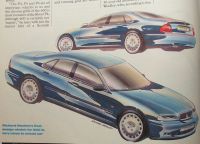
I think it’s actually a shame the Lancia didn’t follow the Dialogos concept more closely for the Thesis; definitely more distinctive, especially the treatment of the flanks and they way the waistline resolves at the rear. Even that rear pillar works with the other shapes.
I had actually seen a Thesis once, in 2014, parked at the Serbian Embassy in Washington, DC. I found it rather odd looking in person, and at first didn’t have the foggiest idea what it was. I haven’t thought about the Thesis much since then, so it’s good to read about its full story here. I will say this: That interior is awfully nice-looking.
Paul’s right. Especially from the side it is a conventional-looking generic sedan. The rear is trimmed nicely but that front and especially those headlights! It looks like they took the styling of the Lybra, which is itself quite generic looking, and made it different for the sake of making it different. Never mind style to match its intended market…just different. It didn’t take much effort, but by then it seemed that whatever was happening at Lancia was “phoned in.” The next step was rebadging the Chrysler 300, a car with an entirely different personality than what Lancia represented. That wasn’t even phoned in…it was texted.
The last relaunch of the brand Maybach , owned by Mercedes Benz , didn’t get lucky numbers either and the marque was dropped. With all the prejudices for Lancia’s parenthood with Fiat, no prejudice can shadow the evidence that this rare Lancia Thesis is an exquisite piece of art design.
That limo has a Maybach look about it, to me.
I always enjoy your writing – clever and fun. This title is one of many great puns from your hand. Maybe the best. I like the Thesis and other oddballs like the C6. I’d be happy to snag one up now, but honestly I would not have considered one when new – that free-falling depreciation trumps adorable quirkiness.
So glad you found one. These are fascinating and I had no idea they had their own bespoke platform. What a boondoggle.
Love the wheels on this one. This is a modern car that can actually pull off two-tone too.
I have a soft spot for these, even if I accept they’re everyone’s taste. A sort of Rover 95, if you like, with some of the kitsch retro Britishness replaced with a softer more contemporary style. That interior is actually pretty neat to me, and probably more to my taste than the Rover.
But isn’t the last real Lancia the Gamma? Maybe? Only Fiat’s money in that one.
I never understood the front of this car, I once read an article it was supposed to be an hommage to the Aurelia B 20 Coupe but I guess they got very, very drunk. There was one burgundy Thesis around where I live, but I have not seen it around for a long time now. The interiors of these cars are fantastic, in a way that nobody can make such a fine interior like an Italian can with smashing finishing, I like these cars better then a Maserati Quattroporte, the Thesis interior bears an air of understated chique. I drove a Diesel and a petrol, I had to bring these to another dealer for my friend who is a Fiat, Alfa, Lancia dealer, they drive ok, handling is as you expect from an Italian car , the blue dials reminded me of my 75 Alfa Giulia Nuova. Thesis is now slowly getting appreciated, like the C6 from Citroën, prices are going up but these two cars are mainly victims of the way large cars are being offered in Europe today, namely by leasing companies and these companies dominate the market and are in love with the German three, simply for reasons of accounting. And that is probably the main reason why the French and Italian limousines have disappeared, lease companies rule the world!
Seems one was a tad previous with one’s appellation, Dr T, but still now, you’ve got your Thesis and as they say, that’s a better fate than never, so one’s congrats to one and all that, what.
400 million smackers for its own bespokery seems all a bit foolhardy. Presumably the consultants who told them the numbers were ticketty-boo graduated to doing US polling now.
“Not inelegant”, you say. Now of course, I’m not about to suggest you have just effused, but you haven’t exactly nose-wrinkled either, as the combination of snoozy blanderry and startling oddity in the pictures might suggest is necessary. Is it one of those things that is not the same when seen in the real world?
Reminds me of an International Lonestar truck.

An interesting read. I had the good fortune to test drive one of these about ten years ago. It was the petrol V6. Looking back I can´t recall anything about the car that would hint at its poor sales. While I reckon the car could have been a little lower, it is an excellent package for driver and passengers so you can see why it is tall. It drives beautifully – you can waft along if you like but if you want to press on the car handles with aplomb. The two problems with the car are that it was too big and costly – it was up against intensely well-developed rivals in the 5 and the E. And Lancia had a reputation as cars that offered sensitive and feelsome controls so you were involved in the driving. The Thesis was too reserved – ideal as a limousine but not as interesting as cars like the Mondeo Mk2 and Peugeot 406 which had well tuned controls. What Lancia needed was a Mondeo/Passat/406 sized car and not something from the D class. And they needed driver apeal rather than well executed anasthæsia. I think it´s a wonderful car for what it is but it was the wrong product for Lancia.
If the moderators don´t mind, here is a link to my wordy test drive article: https://driventowrite.com/2014/05/12/2002-lancia-thesis-3-0-v6-review/
“A very fine job of making the wrong car” – very nice.
For all the great effort, it seems that every single element misses – the beautiful glove box that holds just a ciggy pack – and in any case should have been used in other combinations across other models (or more coherently combined in the one).
As noted above though, it must make them a killer buy presently. Old BM’s and Mercs aren’t going to be any less trouble-prone or costly by now, and freed of its competitive new-car role, it’s got to be far more interesting than them.
One other thing, I also test drove a Lancia Kappa which preceded the Thesis. Though not as finely made (it´s not bad, and it is comfy and distinctive) it is a very convincing balance of ride and handling. It is also handily sized – spacious inside but not bulky. If you don´t mind the fake wood trim and odd plastics it is in many ways a much more convincing car than the Thesis. It also looks incredibly distinctive despite its restrained looks (you´d never mistake it for anything else).
FCA also did the opposite, i.e. rebadging Lancia Ypsilons as Chryslers, for certain markets.
Especially in the United Kingdom and Ireland where Lancia was forever doomed in the 1980s for the prodigious rust manifestation. So, Lancia never recovered from the bad publicity there.
Living in Germany, it was weird seeing second-generation Chrysler 300 rebadged as Thema Executive (with better looking grille), Chrysler Town and Country as Voyager, and Chrylser 200 as Flavia.
Lancia model range has been dwindled to single model and limited to a single market today: Italy-only Ypsilon based on Fiat 500.
Leave a Reply Cancel reply
Your email address will not be published. Required fields are marked *
Notify me of new posts by email.
This site uses Akismet to reduce spam. Learn how your comment data is processed .

Click for CC’s Privacy Policy
Curbside Classics Archives

Recent Comments
- Charles on COAL Update (Part 1): 2007 Honda Fit – Out With The Old
- Jose Delgadillo on COAL Update (Part 1): 2007 Honda Fit – Out With The Old
- Jose Delgadillo on QOTD – What Auto-Related Parts or Supplies Have Become Crazy Expensive As of Late?
- VanillaDude on Vintage Review: 1969 Chrysler Newport – “Quite A Lot Of Car”
- J P Cavanaugh on COAL Update (Part 1): 2007 Honda Fit – Out With The Old
- Fred on Vintage Snapshots: Cities And Towns Across America In The ’50s-’60s
- Phil Henning on Vintage Snapshots: Cities And Towns Across America In The ’50s-’60s
Copyright 2011 - 2024 Curbside Classics. All Rights Reserved.
Driven To Write
Still The World's Least Influential Motoring Site

2002 Lancia Thesis 3.0 V6 Review

When the Thesis was launched in 2002, Lancia wanted a flagship to re-position the brand as a maker of convincing luxury cars, an Italian Mercedes if you like. The Thesis’ predecessor, the Kappa, had been less successful than the Thema, despite receiving plaudits for its refinement, packaging and capable chassis. The Thesis was supposed to recover ground lost during the Kappa’s production run and also to re-affirm the company´s tradition of top-drawer refinement and visual elegance.
To this end, Lancia threw enormous resources at the Thesis such that it had its own unique platform and shared no pressings or interior parts with any other Fiat group product. As quoted in CAR magazine in 2002, the designer Mike Robinson said “People will be looking for reasons not to buy this car. We don’t want to give them any.”
Not so much has been written about the Thesis so I decided to see for myself what the car was really like and to find out why only 16,000 were sold during a seven year production run.
Technicalities: The construction of the Thesis was fairly conventional: a transversely mounted engine driving the front wheels. Given that the Thesis was intended more for comfort than handling the selected arrangement is, objectively, a rational one. Lancia’s reasoning was probably the same as Rover’s: most people are indifferent as to which axle is receiving the power.
A 2 litre soft turbo, a 2.4 litre 20 valver and a 3.0 V6 24 valve engine made up the petrol burning range. A 2.4 JTD diesel was also available. The suspension design was a mix of the ordinary and the clever. The routine elements consisted of independent five-link suspension with coil springs. The intention behind this set up was to minimise the distance between the wheel centre and the virtual steering axle to the advantage of accuracy and crispness. At the rear were installed multiple-arm suspension elements, designed to provide a good capacity to absorb impacts. In essence, these were just incremental improvements on the theme of multi-link suspension.
All the same, I do like the idea of bringing the wheel centre and steering axle together as these kind of refinements were what made Lancias steer so well in the ’70s. The clever part was the use of telescopic Skyhook adaptive dampers. These gadgets allow semi-active suspension in that the damper rates can be varied by computer management to suit the driving conditions and driving style. All this was done with microchips smaller than your thumbnail. A similar system is used on the Maserati Spyder.
These specifications were class competitive but don’t compare to the originality of Lancia’s 1963 Flavia: transverse leaf springs and double wishbones at the front and dead axle and transverse leaf springs at the rear, supporting a front-wheel drive four-cylinder boxer engine. The Flavia’s peers were at that time using straight sixes and eights sending power to the rear. The point here is that the differences between the Thesis and its peers are not insignificant but not very great either, and the chassis design was nothing like as ingenious as its ’60s ancestor.
The Thesis weighed from 1600 kilos for smaller engined versions to 1800 kilos, as in the 3.0 V6 tested here. By way of comparison, the 1999 Mercedes S-320 weighed less, having 30 kilos fewer to drag along. Given that the Thesis is smaller in most dimensions than an S, it was thus a conspicuously dense machine. Being 4888 mm long and having a front drive format meant the passenger compartment was spacious, with plenty of room in every direction. The boot holds a competitive 480 litres.
Whilst the chassis and power train of the Thesis were quite conventional, Lancia was in some sense leading the way by encrusting the mechanicals with a dizzying superabundance of extra equipment, digital trinkets and electric novelties, more than one could list fully in the space allowed.
The 3.0 litre tested was equipped with integrated satellite navigation (a novelty in 2002), an automatic gearbox, electrically-powered automatic parking brakes and four-way adjustable climate control. This can send chilled air through lushly damped louvres on the elegantly sculpted dashboard and through vents in the b-pillars. In addition, subtle perforations in a metal strip across the dash allow draught free ventilation.
Almost everything is powered apart from the front sun visors and the minuscule front ashtray. The multi-adjustable seats could be set to memorise the driver’s postural preferences. Servos even operate the front head restraints. This in itself is a wonderfully unnecessary refinement and speaks volumes about the painstaking efforts to create a truly luxurious saloon. The glove box opens with the push of a daintily chromed button (but amusingly, the glove box itself won’t hold more than a few packs of cigarettes).
A power operated sunblind performs impressive acrobatics: simply dab a switch on the rosewood veneered centre console. It’s worth pausing here to consider that engineering that sunblind probably involved a team of six engineers at a cost of several hundred thousand euros. Naturally, the boot lid is power operated, requiring merely nudge of a button to open and a slight push to close.
Exterior: The vehicle exterior is dominated by the gloriously confident Lancia grille, evoking the firm’s past triumphs. The diamond shaped headlamps are powerful Xenon units. Both the grille and the headlamps are set amidst quite large expanses of unadorned metal work. The intention, according to Lancia’s designer, was to create the impression of glittering jewellery.
The rear lamps – striking vertical slashes- are painfully intense and are simultaneously nostalgically chrome edged and ultra-modern with the LED technology. The theme then was of evocative classicism underpinned by the latest in automotive technology. All the panels were joined tightly and the vehicle was well surfaced, apart from an odd depression where the wing to bonnet valley fades into the plastic bumper.
Interior: I’ve mentioned the features but I haven’t described how they all work together. It’s no use loading a car with toys if they are not well assembled or made of the best materials. Are they? The Lancia’s interior uses leather, metal, wood and the finest plastic. And they are handled well. The interior is well sculpted and classic without being too retro.
The wood strip gracing the dashboard and doors is thick and very evidently real tree. It’s the kind of substantial slab of wood not seen since the solid door capping on 1970’s Ford Granada Ghia’s. All this adds up to lashings of comfort, warmth and quality. It is an effect very, very different from the cold, hardness achieved by Mercedes and Lexus. Even a Jaguar XJ seems a bit glacial in comparison while the similarly priced S-type is embarrassingly Crown Victoria.
The driver’s seat – hand stitched parchment hide- is beautifully supportive without being too firm. The Thesis passes the door slam test, by a factor of five. Pulling the door shut required a well-judged degree of effort, just enough to make you notice the heft. When the door clunked home it felt as if each element of the closure was machined to a fine tolerance. It made me think of a Mercedes 300 SEL 6.3, in fact.
In front of the driver is a classically styled instrument pack. The lettering is redolent of the labelling on a bottle of fine Italian wine and indeed it’s all in Italian. Rather surprisingly, there is an analogue gauge to display fuel consumption, scaled from 6 litres per 100 km to 20 litres per 100 kilometres. It isn’t more readable or effective than a digital LCD display but it is incredibly amusing as it sweeps from left to right like a deranged pendulum.
The rear of the car is a similarly fine place to reside. The legroom is plentiful, more than enough to sprawl out during a long trip from Rome to Cap Ferrat. The centre console features the display and buttons for the climate control so while the driver might require 17 degrees, passengers can opt for more or fewer independently. The stereo system can be operated by a remote control unit. Each of the finely trimmed doors has an ashtray of pretty respectable size and the door cards are unusually handsome, made of precisely the same high quality materials as those at the front.
In short, whether you’re up front twirling the steering wheel or being cossetted in the back, the Thesis is a terribly agreeable place to find oneself.
In motion: We’re 1200 words into this review at which point it really does become very necessary to start revealing what the Thesis is like to drive. Putting it very bluntly, the Thesis is singularly unobtrusive, resembling nothing so much as a really talented butler. I drove the car in a variety of different modes, ranging from tasteless dashing along narrow country lanes at one extreme and, at the other, driving like I had a hung-over primo ministro slumping in the back. Whatever it is asked, the Thesis does what it is told.
If you stamp on the accelerator pedal, the vehicle takes a tiny pause and then leaps forward. Very little vibration is felt and little noise heard. The Skyhook suspension coupled with the sheer weight of the car do a remarkable job at smothering bumps and potholes. The ride is impressively smooth without being floaty. Bad surfaces are simply ignored by the Thesis while changes in direction do not provoke annoying body roll. This is comfort-orientated suspension that respects the needs of handling to a commendable degree. Presumably the benchmark for Lancia was Jaguar not BMW.
With an automatic transmission, there was little to do but steer and brake. And the steering is pleasantly light, quite direct but not nervous and the car had a crisp bite to the turn-in. Of torque steer there was no sign. At the same time, the steering had no positive character either, being more a collection of elegant neutralities. I wanted to notice the steering character rather than to notice I could not detect anything either way. That’s my problem though, not Lancia’s. Like the good butler, it is keeping its personality, its means of operation, completely hidden.
When confronted with a sharp corner, it was best to brake, turn and accelerate again. The Thesis is not a go-kart. But the Thesis felt controllable and if you really had to cover 100 kilometres using b-roads, the car would do it without complaint. But at no point would you feel as if you were in physical contact with the car’s mechanical core.
That kind of road testing is, in the end, rather pointless except to say that the Thesis, could in extremis, make a good fist of getting you from Zurich to Lausanne decisively ahead of schedule, even if you avoided the motorways. But if driven as intended, the Thesis as a car simply disappears for both driver and passenger and instead the wealth of creature comforts come to the fore. In the end, the Thesis is a means not an end in itself. I’ve always said that if Vincenzo Lancia was still around he’d be making Lexuses (or do I mean Lexi?). These too, in their larger manifestations, are smooth and compliant servants rather than machines with which to take on 120 kilometres of coast road for the fun of it.
Sobering Thought: At 20 miles per gallon, the Thesis has a touring range of 333 miles. From Rome to Cap Ferrat would require a stop for fuel after 5 hours.
Concluding ruminations: Mr Robinson’s determination to avoid offering hostages to fortune failed at the first hurdle. By aiming for classicism the Thesis was immediately marked down as retro-design as were Rover’s 75 and Geoff Lawson’s Jaguars. I mentioned that the car was slightly smaller in most dimensions when compared to the 1999 Mercedes S-class. The Lancia is unfortunately taller, to the benefit of headroom but to the detriment of appearance.
The car looks slightly too short which is a huge pity as the car is in fact, actually very big indeed. The very plain side elevations (the c-pillar is the weak link) and the odd proportions evoke the 1960s Flavia but this is such an odd reference. I doubt it was intentional. When shaping the bodysides I presume the designers were hoping for cool restraint but instead achieved banality.
How you feel about the car’s appearance depends on which angle you view it from and whether you are sitting inside it or outside it. From the inside it’s simply lovely and says ‘Latin luxury’ without making you think of 1980s Maseratis or the Renault Safrane Baccara. But to get inside the car you have to get past the exterior, which presumably many people failed to do, even if they were only shown the front, its best aspect.
It’s the inconsistencies that puzzle: the striking front and rear contrasting with the Hyundai body side; the cast magnesium cover for the CD loading slot, not four centimetres above the fiddly flimsy lid of the tiny ashtray; incredible thought was put into the lovely details like the rear lamps and grille but the car’s proportions are just noticeably wrong. Perhaps this is because as a statesman’s car the need for maximum interior space trumped the requirement for supreme elegance. But if it was packaged as a statesman’s limousine why are there are no reading lights in the rear c-pillars and why is there not one single cigar lighter for the rear passengers?
Dynamically, the Thesis offers very good refinement and a generous turn of speed. And thus it lands between a few stools. It’s not as refined as a Mercedes E-class. It’s not as sporting as Jaguar S-type. Volvo’s S80 catered very well to the driver unconcerned with dynamics. For Lancia enthusiasts expecting sportiness, the Thesis is too smooth and aloof and not fast enough. For Lancia enthusiasts expecting the cerebral satisfaction of a car with palpable mechanical character the Thesis is too distant and inscrutable.
And finally: Perhaps it would have been better if the Thesis had been a car in the Mondeo class, rather than trying to offer S-class size for a less than E-class price. Think of it like this: if you want a better class of Mondeo, you are forced to choose a sporty German saloon. But what if Lancia had offered a more comfortable, more pleasant alternative? For the Mondeo driver, half the refinements of the Thesis would have been enough, so long as the car was at least as good to drive. And taking five percent of the C/D market might have been a lot easier than trying to take sales from the sector dedicated to serving Europe’s richest, least imaginative and least interesting people.
Considering the car as it is, rather than what else it could have been, it is a fine thing: well made, extremely comfortable and very well equipped indeed. It is even charming in many of its details. It’s when you triangulate the car against its peers and betters you realise that Lancia simply did a very fine job of making the wrong car.
Facts: Horsepower 215. Compression ratio 10:1. Maximum torque 263Nm at 5000 rpm. 5 speed automatic gearbox standard. Standard wheels were 215/60 R16 95W. Steering rack and pinion with variable rate power assistance. Front: Independent multilink suspension, coil springs with telescopic Skyhook adaptive damping, torsion bar. Rear: multilink with anti-roll bar. Ventilated disc brakes
Length: 4888 (Merc S-class: 5220 mm);
Height: 1470 (Mercedes S.-class 1444 mm)
Wheelbase: 2803 mm.
Rear track: 1541 mm; front track: 1569 mm.
Luggage room: 480 litres.
Weight: 1895 kg in 3.0 litre trim (Mercedes S-320: 1770 kg)
Fuel tank capacity: 75 litres.
How fast? How thirsty?
O – 60: 9,2 seconds
A kilometre in 29,8 seconds
Fuel consumption, claimed 31 mpg on tour, combined 20 mpg.
Tested Feb 6th 2011. Conditions: dry, windless, 2-4 degrees.
Ergonomics: test driver is 5´ 9″, 70 kilos, 50th percentile male (height).
Note: If you like this article, please feel free to post a comment below. Have you driven a Thesis? Did you find out what you wanted to know? Or just say what´s on your mind concerning Lancia´s sad demise…. You are one of a constant stream of daily visitors to this page so share your views with your fellow Lancia enthusiasts. Thanks for calling by!
Share this:
Author: richard herriott
I like anchovies. I dislike post-war town planning. View all posts by richard herriott
Is the car conservative? It is retro but the styling was not reserved. Since there are so many saloons with sporting pretensions the decision to provide something different was to be applauded. The car had plenty of muscle to do some asphalt ripping which is great if you really have to press on. However, the demeanour of the car is more about comfort and refinement. The more I think about it, the more puzzled I am that it didn´t get at least sales of 50,000 units worldwide. There just isn´t that much that is so wrong with it. Some of the reasons for failure are not intrinsic to the car but reside in Lancia´s marketing strategy and perhaps their dealer network. If someone can tell me how well the Citroen C6 sold I´d be pleased to hear, the C6 being at least as outré as the Lancia and not too different in pricing. We can conclude that the market is very intolerant of what are, to be objective, very small variations from the norm.
I must say that I could have written something slightly different a week ago and I could write a review with another angle next week. To attack myself, I have conflated judgments of the car from a marketing point of view with judgments of the car as a thing in its own right. The reasons for its market failure (it was the wrong car) are not reasons to criticise the car as an ownership proposition. The idiosyncratic styling could be seen as a plus and they are certainly not so odd to permit one to say the car is objectively bad. Objectively, the worst things about the car were trivial: small ashtray, absent reading light, slightly severe fuel consumption (but it was the V6). The build quality was fine and the seats comfortable and the ride quality superb. Was it a driver´s car? No. Did it have a “personality”? No, it had features and competence. So, perhaps I should rewrite the review and leave out all the marketing philosophy. The aftermarket wheels were horrible but the ride was still good. I imagine running on Lancia footwear the car would be even nicer.
Stephen Bayley wrote this a long time ago: http://www.telegraph.co.uk/motoring/2724085/Car-culture-Decline-and-fall.html
And a few years later the Fabrica Italiana Automobili Torino has turned into Fabrica Americana-Europea Automobili Londra. I’m rather certain Stephen Bayley isn’t all that proud that his observations have proven to be quite so prescient.
I’m baffled, and not just regarding the automotive sector, how as resourceful a country as Italy could end up on the receiving end of the effects of globalisation.
I don’t quite grasp the chief designer’s strangely negative statement at the launch “People will be looking for excuses not to buy this car. So, we wanted to be damn sure we didn´t give them anything to hook onto.” Unless Mr Robinson was speaking in Italian and suffered a poor translation, did he not realise that many people would still have been looking for excuses to buy a Lancia, being frustrated that Fiat hadn’t given them any for many years? Actually, Lancia gave them a pretty decent excuse to buy, and 16,000 sales must have been a great disappointment.
Whereas it reflects more on my terminally immature personality than the efforts of Mr Robinson’s colleagues that, whilst still conceding that the Thesis is by far the better car, I’d rather take a Thema 8.32 over this, what I don’t understand is the many people who are more mature, disciplined and responsible than me who were too brainwashed to realise that this, and not a hard riding BMW or S-Line Audi, is what they would have been be happiest driving.
I would rather take “Ferrari” Thema myself:) And yes, for those looking for ultimate confort, choosing Thesis over S-line Audi or sports suspension BMW would have been wise decision…
I’ll write a more thoughtful response to this excellent piece of writing later, but in response to the question re C6 sales, the answer is 34,592 according to Citroenet – which is quite a few more than I had thought. Nevertheless, it’s a dismal sales performance over almost 7 years, and, even though the retail price of the car was high, every car must have cost PSA a significant loss. It is not a surprise to me, being an owner: it’s just so left-field for today’s market/ consumer, and inferior in many ways to the more mainstream (mainly German) competition, but full of “character”. Car actually put it well – maybe a little generously – in the GBU – like a French Blue Cheese – repels and attracts in equal amounts.
SV. If you consider that the SM, generally seen as a commercial failure, sold over 13,000 units in less than 5 years, despite being comfortably over twice the price of the most expensive DS, the C6 figures are very disappointing. I do like the C6 and, in part, I’d say the poor sales reflect as badly on the unimaginative, pack-like behaviour of punters as on any shortcomings of the car. However, the suspension of relatively recent hydractive Citroens is confusing. You would think it would be far more feasible to sensitively control a wide range of ride and handling set-ups using hydraulic valves, sensors and electronics, than it would on conventionally sprung cars. Yet the results don’t seem to bear that out. I’m sure Citroen’s current engineers are skilled, but they need a brief from people who have some passion or insight in the field, which I suspect has been long lacking at PSA. Both the modern Citroen and the modern Lancia seem like fuzzy interpretations of their forebears, created from a third generation template where essential details have been lost in each transcription. A bit like Liam Gallagher thinking he was John Lennon.
As a long-term fan of Lancia ( some of my first toy cars were Stratos and lovely safari-type Fulvia ), and other quirky and unusual cars, I was rather surprised to get a chance to use a Thesis 2.4 petrol manual for a month. It did 25,000km in five years, as a fifth car in a family, and still had that new car smell. I did 600km during that month, mostly on highway and I must admit my impressions are somewhat mixed. Considering that it came in same body colour-interior colour/material combination as our Peugeot 406 SVDT 2.1, a comparison was almost inevitable. For starters, engine somewhat lacked low-down torque to move such a heavy car, front seats didn’t suit me at all (but, I do have strange proportions and rarely find a car seat that fits me…) and it didn’t really feel more luxurious than 406. (disclaimer: I do hate modern interiors, that try to look upmarket with fake aluminum, fake wood, fake carbon…I prefer old Jag interiors. In fact, I actually made a wood veneer inserts for my Yugo, however pointless that may seem 🙂 ) Back to Thesis…it felt slightly cumbersome, perhaps even too large (and I used to drive Sprinter van, so big vehicles don’t scare me!), never really feeling any benefit of that famous Skyhook suspension.(wasn’t even sure if it had been there at all!?!). It had standard wheels (could have been 16′, don’t really remember…but sidewalls were tall than car in this test:) ) Again, 406 felt light, darty, compliant, much smaller by comparison. Bells and whistles were there, and worked fine, but novelty worn off after first 200km. After that, I was mostly focused on 6-speed gearbox (first time I used it,… so after first downshift from sixth to third, luckily at really low speed, I took extra precaution not to repeat same mistake again! ) and just taking extra care not to put a scratch on it. Funny coincidence – this car came to me as I was considering my next car purchase, so by using top-spec Thesis (are there any other!?!:) ), I was actually able to learn what gadgets and options I could live without 🙂 But every one that took a ride with me was very impressed, in fact so much that few people said it would be perfect wedding limo! And that about sums it up – it’s great car for passengers (without low profile tyres, of course:) ), but driver may feel somewhat dissapointed. After 406, it didn’t feel nothing special to drive…
The 406 is a hard car to beat. I know it well. The size is perfect and it is remarkably smooth. The seating for the driver and passengers is superb. Following that, the Thesis is bulky and remote. My feeling is that Lancia should have made a smaller, C-D class car like the 406 and matched its driving character. It would have been more affordable and a novelty in a less status-conscious sector. A V6 406 does everything a Thesis does but is more wieldy.
We do agree! Except I didn’t like 406 leather seats at all and that famous electronic gas pedal…but other than that, it was excellent (ok, reliability of our particular version notwithstanding…) However, having been invited as a long-term 406 owner to the test of facelifted, 2.0 HDI model, I was quite surprised its controls felt quite heavy comparing to our car. Like they tried to make it more sporty, tighter, harder…really, I believe it was unnecessary.
Hello to Pistonheads visitors- March 15th
I have no experience of the Thesis short of seeing one parked in Florence one time. My initial thoughts were that it certainly was more impressive in the flesh than in any photographs. Having owned and driven a Trevi and a Thema I am well accustomed to Lancia’s engineering foibles and understated elegance. It has always been my opinion that to buy a Lancia one must first be willing and capable of thinking outside the box. The Thesis has refinements that go unnoticed by the vast majority of the public. I would be happy to own one but for it’s non availability in right hand drive. It’s a pity that car design has slowly followed the white goods route where cost and performance greatly overshadow individuality. The Thesis should be applauded for what it is, a unmistakably uncompromisingly overly designed car.
Thanks for stopping by Fintan. It has occurred to me that (as far as I can recall) I have never seen a Thesis in the wild. I suspect they look a good deal more imposing than they do in static photography. Nevertheless, it remains a car I’d like to drive (or travel in) more than admire from afar.
A question: As a (former?) Trevi and Thema owner, are you inclined to view the Thesis as less or more of a Lancia than the duo you have owned – or is that an unfair question?
I enjoyed your review. Yes, there’s something wrong with the Thesis.
You miss out the Kappa, two of which I’ve had so far. Utterly reliable — unlike all French cars — ask your friendly breakdown wagon driver, he knows. And I have memory heated seats, and a C-post reading light and fag lighter terminal accessible for rear passengers. And rear screen sunblinds but you have to fiddle them up manually. The boot’s 500 litres, in a car appreciably shorter and narrower than Thesis. I grant we have plastic wood. Hardly marketed, as Fiat “luxed up” Alfa’s bigger model, whose 3.0 V6 is much the same as mine. Kappa has smoothish ride, but many are as good or better. Would love Skyhook, which works on the Maserati. The Kappa estate has self-levelling rear suspension, at £400 a pop to replace, and clever storage layout in the back.
And as for the Kappa coupé, that’s a superior car with its SWB still allowing the 500L boot, and prices hold up — I can get a cheaper Thesis. The 2.0L turbo engine is still the fastest regular production Lancia ever, in either 12v or 24v. And the window comes down a bit for opening/closing the doors. But now I’ve seen a BMW X-whatever number which opens your door a couple of inches on remote unlocking.
In the flesh Thesis looks a lot better, maybe because you can’t easily take in all its ungainly bulk in one view. And have chatted to owners, who do huge mileages happily. Doesn’t self-park, like some Deltas –which has been another expensive mistake with a disproportionately long wheebase. The only success they’ve had is little Elefantino, nice at a price.
Part of the problem is political: Italian statesmen must have an Italian conveyance, so it’s longer inside than it would otherwise need to be. And they rarely need to go fast, so it doesn’t matter that Thesis is woefully under-engined for actual owner drivers. The lack of ostentation has often been a Lancia feature: remember the lovely 2000, a miniature Rolls of its time.
Now all surpassed by the XF, beating all the pretentious characterless Germans.
Don’t knock the Safrane Baccara, a gem. But then I thought Vel Satis was fun too.
Thanks for dropping by. We have a few Kappa articles here plus a Trevi test drive. I had a look at the Kappa as a used car but they are too old (my wife wants hundreds of airbags) and the three on sale here are a bit leggy. I have my eye on a Delta: it’s the right size and has a decent boot.
What’s wrong with the Delta’s wheelbase? It’s exactly what makes this car unique and gives it very elegant proportions. Not your everyday Golf-clone hatchback. The only thing you could criticize is that it’s placed right between the usual car segments which might have contributed to the difficulty of selling it. But as Richard says, for people who don’t need a saloon and want something slightly bigger it’s perfect.
The Delta is only 10 cm shorter than the Peugeot 406 and has the same luggage capacity. Cars after the 406/Laguna2/Mondeo2 got too big. It’s a distinctive car in a market of good but very similar products. The Golf/Focus/Astra trio are all good in (slightly) different ways. There’s no mistaking a Delta for anything else, inside or out.
In many ways I think FCA suffers from Roveritis, which is to say that, while they have people in their ranks who are individually talented and work hard, management is fundamentally an inept cancer that continually enables a deep-seated culture of close-enough-is-good-enough. The truth is that FCA is simply not a serious company in the way that a Toyota or BMW are. The Delta, in fact, is a good case in point. I think the styling has held up well – it was an influential design for its class and considering the constraints put on the design team, that is no mean feat. But the devil is in the detail.
Somewhere on one or another of my hard drives I have a handful of photos that neatly encapsulate the Delta’s fate. They are from the Geneva 2008 launch, which was quite a ritzy affair with, from memory, five Deltas on hand (and nothing else from the range in sight, to fully emphasise the Delta’s importance). Three were decked out in white, two in black. The photos focus on the area just below the tip of the grille’s V. On at least two of the white cars, rivulets caused by running paint are very clearly visible. It’s not very evident in the below photo (the clearest I could find on the web), but you can see, just offset to the left from the ridge that runs down from the bottom of the V, the dried-up ball of paint above the lower intake:
http://images.car.bauercdn.com/upload/8673/images/01lanciadeltapostpone.jpg
This might seem like a small thing. But in fact, it was a big thing, because it speaks to the seriousness of the whole enterprise. If you are that slapdash about the quality of the cars that are supposedly relaunching the brand and being gone over by most of the world’s motoring press, how serious are you going to be about production cars? The Delta was not an especially cheap car at launch, but the detailing simply didn’t support the price point, because the budget was simply not made available for it. It’s one of those cars that looks worse the closer you get, because things like the grille and doorhandles look like the cheaply-made plastic pieces they are. It’s a shame, really, but almost duty-bound to be that way, because it is the inevitable result when management is utterly committed to, and only to, facilitating PowerPoint presentations and balancing account ledgers.
Oh dear. I am considering buying one.
I wouldn’t; still overpriced. I was dead keen on this before launch, but disappointed the more I got to see of the cars. Its best feature seemed to be you could stand up with your head out of the sunroof and let it park itself. But that, and almost everything else you might have wanted rather more, is an expensive option. I think this applied to the sliding rear seats which I’d have found a boon on two-person long tours.
What really got me, apart from cheap materials described by previous poster, was that the wheelbase was too long for decent handling. I kow you can say it was good to get away from the rigid segment definitions, but it doesn’t really work with today’s herd mentality. There was a time when Lancia could go against this with flair — no longer.
But today’s news may mean the Chinese will buy Fiat-Chrysler (will Trump allow?) so I’ll be having to buy spares now in case the supply dries up completely.
Hello Vic: thanks for the insight. The Kappa is one of my preferred choices. However, I am not the only user and have to compromise. The reviewers were happy with the car´s materials. I am not *very* concerned about handling as the car is to be driven in Denmark where it´s all about rigorously enforced speed limits. I drive on cruise control most of the time. I like the long wheelbase in that it affords a lot of rear leg room, something I set a high price on.
Richard, I’ve driven in Denmark too. I’m not really happy recommending a Kappa for you as I don’t think it would be v economical in that environment. (I never drive diesels.) You’d have to fit your own cruise control: I’ve never seen a Kappa with it. Lybra might work, but is rare. Has more modern suspension, probably enough airbags — just maybe enough rear legroom. Boot not vast. Oh, and I always choose a car after ensuring I have a mechanic close enough to service/fix it.
Let me know what you think of Lybra idea — afraid I don’t have time to check now.
Some Kappas have all the airbags, maybe only 2000 year Coupés, which will cost a bit for low mileage — they were so good people did use them a lot. But it’s a bigger car.
I looked into the Lybra. There is a leggy one for sale in Kolding. It’s been on sale for months. The rear legroom is disappointing, I have to say. Otherwise a pretty decent car. There are no saloons – the Kolding car is an estate. Life would be easier if I could buy a car from outside Denmark without the mystery of the import (“registration fee”) tax. With all that in mind, the Delta is available, not too high a mileage, spacious and nigh on unique, airbagged. Bloody expensive too.
Richard, first I don’t understand yr import problem: thought DK in the EU, no? What price and year a possible Lybra in, say, Germany/Poland? And what price and yr DK Delta ? Lybra legroom depends on how far front seats are set back, of course. Most factory pix set them right back to give attractive spacious front cabin look! Best go and play with one.
After looking more into Lybra, I might swap out of my Kappa for one — not too expensive here in France, more manouvrable as I age, and an auto box, but only on 2.0L when 1.8 would probably do me. Saloon far better rigid structure than SW. Has to be LX: base model a bit mean.
The import “problem” is twofold. One, there are hard-to-fathom registration fees when the car arrives in Denmark and secondly, domestically, my Danish wife has a very, very strong preference for a locally bought car as opposed to one from outside Denmark (which is in the EU). The Delta I have my eye on is correctly priced for the local market: a huge, huge sum of money which is €8000 plus the Danish registration “tax”. Seriously, don´t ask. It´s a frightener. I will be looking at the car tomorrow.
By the way, are you part of a Lancia forum as well?
A quick look at Lybras wíth under 70,000 km shows them to be a) marvellous as saloons b) rare and c) all in Italy which is domestically a complete no-go. But €3000 gets one a very tidy dark saloon with a tan hide interior. What a lovely car. Sadly, I think I can write that idea off. I notice low mileage Kappas are still worth a lot. The market has belatedly discovered what excellent cars they are.
While I admire your wife’s preference for supporting local Danish enterprises, I’m not sure you’ll be spending enough for the actual financial benefit to them to be very much. There are probably enough Lybras in nearby Holland and Germany to get an idea if it’s the model for you.
I’m not knowingly on other car forums; used to do Viva Lancia! years ago.
Low mileage Kappas are rare, and usually coupés and as you say, holding or increasing prices; mine is a very rare 6ok km berlina, ordered for an Italian mega corp director. True to tax-avoiding stereotype, they got a base model, then loaded it with nearly every extra to get an LX spec without paying the extra tax for it! So I paid a lot for what was a 15-year-old car that looks like a slug, but has complete and comprehensive history. Probably wouldn’t get now what I paid; don’t mind; does what I got it for. [Those stainless window trims can be carefully moved to the right place wearing thick rubber gloves. I’ve seen them on Passats, too, also out of alignment!]
The auto box is “intelligent” — remembers how you’ve driven and constantly updates to what you’re doing now. Love it. Lybra has that too, but adds another option, switching to fully manual too.
Going back to Thesis, which was where I came into your nice site, if they’d just scaled up Lybra to limo size and added Skyhook it would have done far better. Both used input from the Dialogos concept.
Danes are highly risk averse. Buying “abroad” is seen as risky. That, rather than a concern for the economy, drives the preference. The Lancia range needed a car between the Lybra and Thesis: I suppose Lancia thought an image-building large car was the way to go.
Apropros of nothing, I was recently in Belgrade and Lybras (especially SWs) seem to be popular amongst the taxi brigade there.
On the topic at hand, the thing about the Delta is this. It will fit the ‘modern car’ parameters that satisfy your wife much better than even the Lybra and especially the Kappa – it has cruise, is much safer, and so on. As a modern, practical, conventional car with a lot of legroom and a bit of distinctiveness, it’s a perfectly reasonable choice. But with that said, it won’t feel as distinctive as a Kappa or a Lybra, because the engineering freedoms simply weren’t allowed to drag it too far away from a Bravo. I quite like the Bravo so this isn’t really a criticism from my side of the ledger. But it is something to be aware of nonetheless. In any case, my point about the launch cars was more about highlighting management more than engineering incompetence – it is literally impossible to imagine Piech allowing something like this to occur.
I would note that regarding reviewers’ impressions of materials, you might notice they tended to go out of their way to point out how nice the seats are etc etc, usually adding an addendum like, “which means you don’t notice the dashboard plastics”. In truth, actually, for me it is not really the plastic quality so much as the chosen treatment that I don’t care for – the silver-spray radio/infotainment slab on most models I personally find pretty unsightly. There is a piano black finish on expensive ones that makes a world of difference, but I’m going to guess they sold approximately none of these in Denmark, and any that may exist are prohibitively expensive. The cheap materials on the outside, I would say much the same about. As the reviews of Skodas and Hyundais from the 1980s would say, they get the job done. But they just look and feel cheap, and in that way, they undermine the pleasure I take in the car. If you can live with that, though, it sounds like a good car for your requirements.
Today I viewed the Delta. Report to follow.
You do not have to master marketing to know that the unconventional design of the headlights was reason enough for plenty of potential customers not to buy the car. You simply not succeed in selling this kind of refinement to mass customers. Ask at VW how well they’ve understood this and why the VW Golf is such a success. This said, the beautiful front design would be one of the main reasons I’d buy a car that would set me apart from everything else on the streets. But as we know also most of customers which can afford this sort of car do not want to stand out too much from their peers driving around in boring Mercs and BMs..
For someone with a design background I ought to be able to spot that about the lamps. I don´t see the problem there but in the proportions and the bland centre.
I must say that I find the Thesis fascinating and lovely, in many respects, but I have problems ‘seeing’ the front.
I have to study it each time I see it to work out the angles involved, especially of the area that surrounds the grille. Also, at a glance, it looks as though it doesn’t have a bumper or anything to ‘bring it to a conclusion’ at the front.
Finally, the lights strike me as being relatively small and very much at the edges. All of this might be wrong, but it’s the way I see it and I have similar difficulties with the Ford Scorpio. It’s not an ugly design, exactly, but there’s something disturbing about it.
Am I reading too much into the shape of those headlamps, or are they intended to look a little like the Lancia badge, from a high (standing adult) viewing angle?
Hello Daniel – could be. One would have to look at the blurb for the Thesis / Dialogos concept, possibly. By the way, I came across these concepts – I hadn’t seen them before.
http://www.conceptcar.ee/conceptcars/106-lancia/6264-lancia-thesis-prototypes.html
Those concept pictures are fascinating. I like the one on the left quite a lot. It’s interesting to note that the middle concept has much better flanks than the production car.
Well here i am, replying on an ancient article on a car i intend to buy. Driven by a subconsious alarm that tells me not to. I want the car because it’s lush and luxurious, exotic in a way and it has a V6 engine, enough power and a faint charm about it that is impossible to describe. Also, i set my financial realm to around 3000 euro’s so there is not a whole lot to choose fromin this segment. Apart from it’s debated flaws and quirky looks that should withold me, i’m just wondering whether i am inclined to considder buying this machine. There’s just something that stands out from the other cars that fit this bill..something that lures me in. Maybe this is my car karma, wich has let me down once too often. Somebody: please discourage me (with arguments)!
Good morning Bas and welcome to Driven To Write. I’m afraid you’ve come to the wrong place if you wish to be discouraged from buying a Lancia of any sort! The Thesis would be a lovely modern classic to own, quietly elegant and understated (unlike almost all current cars). Go for it!
Always bear in mind that the cost of keeping such a car on the road is not depending on the purchase price but on the class of car and that Lancias are particularly expensive to maintain because their spare partes are exceptionally expensive if you can get them. The biggest problem with all cars from the Fiat emporium is spare parts availability. For cars like Thesis, 166 or 916 there is literally nothing you can buy at a Fiat dealer. With luck you get wiper blades and brake pads but that’s all. No body parts and only very few mechanical spares are avilable. Last summer I searched five weeks for a used cambelt cover to replace a cracked one on an Alfa 916 and a Thesis surely isn’t any better. The Alfa V6 is an expensive engine to run and to maintain. Driven hard it has a tendency to drink. You probably never will see better than ten litres per 100 km, inner city driving will be between 13 and 16 litres per 100 km and fast autobahn driving will nearly invariably be beyond 20 litres and beyond. It then also consumes some oil. The V6 needs seven litres of fully synthetic 10W-60 oil every 20.000 kms and you should not go for cheap oil if you want your engine to last. Follow the old Alfa buyers’ recommendatoin and let the owner start the test drive – make sure he is warming it up properly for at least 20 kilometres before he uses it hard. If not, walk away. Maintained and driven properly, the engine will last for 250.000 kms and a bit more which is quite respectable regarding the leaden right foot of the majority of Alfa owners. An Alfa engine overhaul is expensive and definitely not a job for the faint hearted or the inexperienced. Cambelt replacement is recommended every 60.000 kms and should not be pushed beyond 80.000 kms and is a more than 1.000 € job. Look at the service bills to check that. A properly maintained Alfa V6 can provide a lot of fun, a badly maintained one can (and will) become a pig.
I’m an old Italian car nut myself but I wouldn’t do it, at least not at the price level you are looking at. The risk is far too high to buy a car with a significant servicing ‘backlog’ that would become an object of endless money spending. The non-availability of any spare parts also would prevent me from buying such a car.
I can only agree with Dave’s comments. Especially his comment about the budget. With a vehicle at this price level, a significant servicing ‘backlog’ is definitely to be expected. Due to the non-availability of spare parts outlined by Dave – and to be a bit flowery, he was only describing the door handle of the “gate to hell” – a expensive car is the better car in any case.
Should you find a vehicle of your choice and all is well, rest assured I am already envious.
Sorry but I can´t discourage you with any factual reasons to avoid the Thesis. It´s comfortable, elegant, pleasant to drive and distinctive. The rear seating will win friends with your family and acquaintances. The only downside is the silly glove compartment and the tiny ash-tray.

Yaroslav Bozhdynsky's Personal Website
Lancia thesis.
2001-2009 Lancia Thesis Designed by: Michael Vernon Robinson at Centro Stile Lancia. Interior design Flavio Manzoni. Tipo 841 Number made: 16,718 approx.
First VIN ZLA84100000000997 Vehicle: 00000015 Prod. date: 20/2/2001
Last VIN ZLA84100000018789 Vehicle: 00016718 Prod. date: 10/3/2009

Concepts and prototypes:
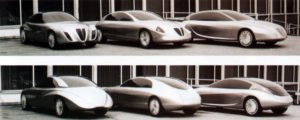
https://www.collectorcarads.com/Lancia-Stola-S85/59164
“only 3 cars built” (One for Pope was the Giubileo not Stola)
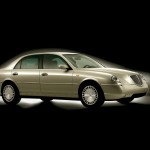
Limited Editions:
‘Bicolore’ or ‘Unique’ 2004.
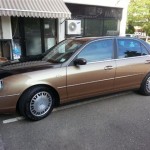
Thesis ‘Bicolore’ for sale on Autoscout24
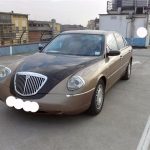
Centenario Elegante ‘Premier’ (2006-2007) For 2006 and 2007 Venice Film Festival. 20-40 made. 115.599.0.0 – 2.4 JTD 20V 175CV 129KW E4 CAE S.S. CENTENARIO ELEGANTE 401 Rosso Vienna Black centre console tunnel sides and carpets 4J1 ‘bicolore’ option code (Grigio Palladio and Grigio Alfieri) flagpoles on front mudguards https://www.thesisclub.it/?page_id=67
Centenario Elegante, 100th anniversary (2006). Silver-grey two tone, red leather or Rossini grey-brown two tone, Cuoio Havana leather 115.599.0.0 – 2.4 JTD 20V 175CV 129KW E4 CAE S.S. CENTENARIO ELEGANTE 401 Rosso Vienna 4J1 ‘bicolore’ option code (Grigio Palladio and Grigio Alfieri) Black centre console tunnel sides and carpets
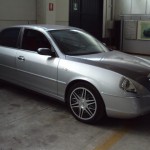
Thesis Centenario Sportiva for sale on Autoscout24
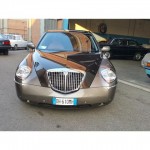
Centenario Sportiva, 100th anniversary (2006). Black or Silver, red leather. 115.499.0.0 – 2.4 JTD 20V 175CV 129KW E4 CAE S.S. CENTENARIO SPORTIVA 401 Rosso Vienna Grigio Palladio or Nero Donatello Black centre console tunnel sides and carpets
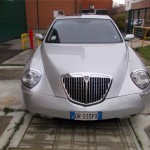
S.T. Dupont , french market (2007). 115.599.0.0 – 2.4 JTD 20V 175CV 129KW E4 CAE S.S. CENTENARIO ELEGANTE 690A Grigio Rossini Met. 495 Cuoio Havana Poltrona Frau Black centre console tunnel sides and carpets
Limited Edition 2007 115.599.0.0 – 2.4 JTD 20V 175CV 129KW E4 CAE S.S. CENTENARIO ELEGANTE 690A Grigio Rossini Met. 495 Cuoio Havana Poltrona Frau Black centre console tunnel sides and carpets
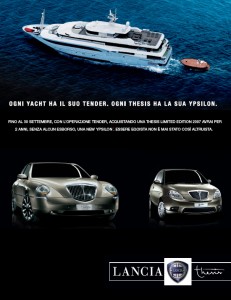
Versions 115.265.0.0 – 2.4 JTD 10V C.M. 6M ALLESTIMENTO AZIENDE 115.363.0.0 – 2.4 JTD 5C 20V 175CV 120KW C.M. F40 EXECUTIVE 115.363.0.1 – 2.4 JTD 5C 20V 163CV 129KW C.M. F40 EX-DEPOTENZIATO 115.364.0.0 – 2.4 BZ. 5C 20V C.M. LS 115.365.0.0 – 2.4 JTD 10V C.M. 6M LS 115.368.0.0 – 2.0 TB.BZ. SOFT 6M LS 115.372.0.0 – 3.2 BZ. V6 24V CAE CF4 LS 115.373.0.0 – 2.4 JTD 20V 175CV 120KW CAE EXECUTIVE 115.373.0.1 – 2.4 JTD 20V 163CV 120KW CAE EXECUTIVE-DEPOTENZIATO 115.374.0.0 – 2.4 BZ 20V C.A. AISIN LS E3 170CV 115.376.0.0 – 3.0 BZ. V6 24V CAE LS 115.379.0.0 – 2.4 JTD 20V 175CV 129KW E4 CAE EXECUTIVE 115.463.0.0 – 2.4 JTD 5C 20V 175CV 120KW C.M. F40 EMBLEMA 115.463.0.1 – 2.4JTD 5C 20V 163CV 120KW C.M. F40 EMBLEMA-DEPOTENZIATO 115.464.0.0 – 2.4 BZ. 5C 20V C.M. LX 115.465.0.0 – 2.4 JTD 10V C.M. 6M LX 115.468.0.0 – 2.0 TB.BZ. SOFT 6M LX 115.472.0.0 – 3.2 BZ V6 24V CAE. CF4 LX 115.473.0.0 – 2.4 JTD 20V 175CV 120KW CAE EMBLEMA 115.473.0.1 – 2.4 JTD 20V 163CV 120KW CAE EMBLEMA-DEPOTENZIATO 115.474.0.0 – 2.4 BZ 20V CA. AISIN LX E3 170CV 115.476.0.0 – 3.0 BZ. V6 24V CAE LX 115.479.0.0 – 2.4 JTD 20V 175CV 129KW E4 CAE EMBLEMA 115.499.0.0 – 2.4 JTD 20V 175CV 129KW E4 CAE S.S. CENTENARIO SPORTIVA 115.599.0.0 – 2.4 JTD 20V 175CV 129KW E4 CAE S.S. CENTENARIO ELEGANTE 115.772.0.0 – 3.2 BZ. V6 24V CAE CF4 BLINDATA B4K – 5POSTI 115.872.0.0 – 3.2 BZ V6 24V CAE CF4 BLINDATA B4-5POSTI 115.876.0.0 – 3.0 BZ. V6 24V CAE BLINDATA B4 115.972.0.0 – 3.2 BZ V6 24V CAE CF4 BLINDATA B6-5POSTI 115.976.0.0 – 3.0 BZ. V6 24V CAE BLINDATA B6
Interior codes:
Exterior colour codes:
Press releases
Lancia at the 67th Turin International Motor Show, 20 April 1998
https://www.lanciapress.com/press/article/2927
Dialogos: see and touch the future Lancia shows us the future of élite motoring at the Turin Motor Show. An imminent future, destined to take shape on the next models produced by the brand. Lancia has decided to show us the future instead of tell us about it: all the innovations can be seen and touched on the stand. They are all packed into a concept car, which has been named the Lancia Dialogos. The name describes a car able to receive signals and decode them. To adapt to changing user characteristics and requirements, to set up a new, different dialogue and relationship between man and machine. This is the philosophy behind the ‘biodynamic car’. Its aim is to update Lancia’s original mission – to build prestigious, distinguished, comfortable cars – for the new millennium. Not merely a vehicle to be driven, but a place to live. A space where material is used to ensure wellbeing and good looks. A passenger compartment conceived as an ideal microclimate and living room where one is free to enjoy stress-free driving. Dialogos is the result of taking Lancia’s extraordinary heritage to the next logical stage. To explore future worlds, where technology makes every dream come true. We chose to limit ourselves to solutions which will really be applied to standard production cars: solutions that meet new yet stringent design criteria. The car admired by visitors to the Lancia stand is a paradox: it takes its inspiration from tradition yet points to the future. The result is a big, five-metre long deluxe car with retro hints: high front, long bonnet, upturned wedge-shaped profile. These hints are immediately denied by an interplay of smooth curves and rounded edges, that speaks a completely new and appealing stylistic language. The Dialogos immediately opens its doors to passengers approaching with their personal Ego Cards in hand. The doors open book-fashion as on the Aurelia and Appia; the technology required to design a car without a central pillar but still able to pass today’s severe crash tests can only be imagined. Through the doors lies a roomy, comfortable and relaxing lounge. After all, the ideal of every journey is to feel at home, surrounded by an environment we like, among things arranged the way we want them. So the front seats turn outward through 90° to allow the driver and passenger to sit down, before returning to their original position. The car recognises people by means of their Ego Card personal keys and adapts to their habits, life styles and driving styles: left hand drive or right hand drive, steering wheel and pedal unit, climate control, light distribution and intensity – and sound. Conventional seats have been replaced by armchairs. These mould themselves around the body. Ventilation and lighting of the preferred colour and intensity are diffused through breathable trim. As we wallow in an environment of wrap-around, continuous forms, our senses are soothed by wood that is soft to the touch, chamois leather, cashmere and relaxing images from three screens on a facia. Yet the facia is not in the normal place, but tucked away at the bottom where it cannot get in the way. Now all we have to do is insert our Ego Card in its slot and press to start the car. The car interior lights up by itself (a little touch of magic). Information on the screens and the cruise control is controlled by a joystick similar to a TV remote control. The car also reacts dynamically according to the preferences of the driver: suspension setting, drive torque distribution over both axles, degree of oversteer etc. An anticollision radar is in operation and hidden TV cameras ensure a perfect 180° rear view with no blind spots. The headlamps automatically adapt light beam intensity to external conditions. When the car stops, the front seats can be turned through 180° so that the passengers can chat or work face to face. Screens and keyboards, minibar, table and document holders can appear at will from the clean, uncluttered lines of the interior. All this and more make up the Dialogos. Before we go on, it is worth considering the principles that inspired the designers responsible for Lancia’s concept car.
A new relationship with the car This élite car for the third millennium will overturn a commonly held misconception: that wealth means owning flashy, costly items. In today’s society (and this will be even more true in tomorrow’s world), true luxury means no obstacles to the satisfaction of one’s desires and needs. This means doors swinging open at our approach and nothing standing in the way of our communication with technology. Be it navigator, radio, climate control system or screen, we should not have to adapt to the way it works. Instead the instrument interface should adapt to us. This also means being able to live in an environment attuned to our current mood, that allows us to experience a new type of comfort. Wellbeing based on sensory oneness, perceived in an environment where objects have not been designed for appearance alone, but also for the way they feel, sound, smell and – naturally – the way they look. The Lancia designers undertook the far from easy task of designing something intangible: i.e. the quality of the relationship between man and car, the sensation of motoring and the aesthetics of sound, smell and touch. This new soft revolution is not based on hard technology as in the past (a case in point was the 1922 Lambda with its impressive total of seven world patents) but still radically changes our experience of the car. The result is the Dialogos, a car capable of discreetly serving its user and re-interpreting age-old Lancia precepts for a new age: dynamic design, advanced technology, the quest for absolutely élite comfort and sophisticated solutions. The thing that counts on Lancia’s concept car is the new relationship offered by a ‘biodynamic car’. The opportunity to live in an environment that is simultaneously ideal microclimate and living room while also offering a stress-free drive. The body that the Lancia Style Centre has dreamed up for this paragon contains frequent references to the past and pointers to the future. It embodies the concept of an evolving tradition.
A timeless sculpture The external styling of the Dialogos speaks for itself. It is patently the result of a profound rethinking of Lancia traditions to cater for the future tastes and needs of the most sophisticated and demanding customers. The mighty yet fluid and stylish front end draws inspiration from classic themes. As on the Lambda, its flat straight grille is a true radiator. The styling rejects the idea of a wedge attacking the asphalt in favour of an upturned wedge shape. The front box, with its long high bonnet, draws the rest of the car behind it and the passenger compartment is shifted backward with the boot almost an appendage. The body lines are long: soft lines swoop and turn without apparent effort. The shape is square, but this is no soap-dish. A careful use of rounded edges mixed with smoother sections produces a stylistic language that is unusual, but also well-proportioned and continuous. Shield-shaped rims (19″) and tyres with a specially-designed tread ensure style and practicality. Adaptive headlamps lit indirectly from a concealed source look like diamonds. They seem so clear and bright, then suddenly break down into a myriad of facets. This magical lighting system is repeated by the rear neon lights. All exterior elements that could make the car look too visually busy (handles, door mirrors, wipers and aerials) have disappeared. The Dialogos looks for all the world like a sculpture. This impression is accentuated by the fact that divisions between panels have been minimised and the central pillar is apparently missing. The colour of the windows (there is apparently only one) is very similar to the incredible blue of the body. Yet this impenetrable object suddenly opens out into a roomy lounge with linear, simple lines, based on classic international furnishing standards. The front armchairs are supported by a sturdy central mount but look as though they are hanging in the air. Their head-restraints and armrests look like cushions thrown artfully onto a sofa at home. The extended, continuous interior surfaces disseminate air, light and sound. Compartments and spaces are present, but hidden, waiting to open when needed. Your trip into the conveniences of the third millennium begins here. Lancia’s concept car is designed in accordance with three main guiding principles: the car as ideal microclimate, the car as living room and stress-free driving.
Life in an ideal microclimate Imagine an ideal microclimate where all climatic, acoustic, visual and even olfactory conditions transmit pleasant, protective, healthy and relaxing sensations. This is the Dialogos’s passenger compartment. Air quality and distribution, lighting, protection and ergonomic comfort are all finely tuned to produce non-aggressive, silent climate control. These results have been achieved by doing away with all intrusive or bulky items and the Top Climate System has been created. This system considers all aspects of the on-board climate. It controls the temperature of all breathable interior walls and also cleanses and deodorises the air by means of regenerable active carbon filters. Air does not circulate in this system. Instead, an atmosphere diffuses through extensive breathable surfaces such as the walls and roof panel. Air is finely distributed through micropores in the trim materials to keep passenger compartment temperature constant. Because there are no outlets, fan speed and noise is reduced for an overall increase in efficiency. The system also allows passengers to adjust heating to their own requirements. Four customised microclimates are created by measuring perceived heat by means of detectors fitted in the seats. The system also measures external temperature, humidity and pollution conditions. Once all data have been processed, ideal conditions can be created. Passengers use their own joysticks to adjust their microclimates to individual taste. The on-board computer stores the data, which may then be called up quickly when required. In a word, the Top Climate System can pick up on the current mood and use its many sensors to envelop each passenger in a beneficial, healthy cocoon at just the right temperature. These conditions can be customised and memorised. The diffuse lighting inside the ideal microclimate is made up of different shades. All of these are warm and designed to reflect a home-like atmosphere. They offer the colour and brightness best suited to different situations and occasions. The materials and components inside the passenger compartment have been chosen to meet the needs of superior quality of life on board. They are good to look at and good to touch. The seats are trimmed with nabuk, a soft, fluffed leather similar to chamois. The roof is trimmed with a wool blend cloth and silk. The facia, squab backs and flaps are in soft wood. This material consists of a film of real wood bonded to a layer of resin and foam. It is soft to the touch, deformable (it bends when the doors are opened and yields to the pressure of a finger) and combines attributes of safety with a sensation of naturalness and warmth.
A living room with wheels The environment on board the ‘biodynamic car’ is spacious, comfortable and relaxing. Every part is made out of top-quality material and chosen with care to express sophisticated unfussy taste. The space is flexible because it can be converted at will into a passenger compartment where one can travel in the greatest imaginable comfort, a lounge for conversation, a place of entertainment with the option of listening to good music or watching a video, or even a place for study and work. To get into Lancia’s concept car, simply approach with your Ego Card. This personal key automatically manages various functions and also stores the characteristics of its user. The front doors open, the car is raised or lowered to suit the driver’s height and the seat swivels outward to allow you to get in. Once sitting down, the seat moves back in and round into the driving position. The doors now close automatically. The front armchairs can carry out 12 different movements (automatically controlled) and form a single sofa when placed together, which configures itself to suit the form and sitting position of its occupants. The configuration is stored for subsequent use but may be changed – to suit a new passenger, for example. The seat squab back is covered in soft wood and the edge is finished in heartwood. The head-restraints and armrests are made out of constant thickness cushions. The whole front bench may be turned through 180°. This action converts the passenger compartment into a comfortable lounge, ideal for a tête à tête conversation with back seat passengers. A display with a double 14-inch screen can be removed from a service compartment in the middle of the back seat. The back seat is also fitted with a socket for a personal mobile phone, while the head-restraint is fitted with headphones for listening to music. Simply lean back to listen to the sound. Back seat passengers can also remove an infra-red keypad from a housing in the door in order to interact with the on-board computer. The door panels are also sophisticated and refined. Nabuk is abundantly in evidence and the oddments compartments are made out of deformable material covered in soft wood. The light, air and sound dissemination areas are covered in clear, breathable metal cloth. The bar compartment is located on the left rear panel. It is closed by a flap – unhinged, because this too is made out of soft, deformable wood. A small table is available in the area at the rear on the left. Luxury, yes, but without ostentation. Innovation, certainly, but with precise references to timeless values. Flexibility to the widest range of needs and great functionality. Ultimately the most gratifying way of experiencing life on board a car.
Stress-free driving: a dream come true A car designed for stress-free driving must be able to anticipate motorists’ needs. It must be able to adapt to their habits and – why not – to their mood and also to current situations. Lancia opted for a high level of automation to fulfil these functions. The car features a man-machine interface system, a sort of on-board assistant that sees to everything. With the gearbox, handbrake and stalk unit done away with, car use is simplified to the greatest degree. This is also helped by the use of vocal commands. The system provides useful information to the driver and puts the driver at ease by customising certain functions. The system ensures a high degree of safety. Both driver and passenger enjoy full control of the car for complete physical and mental wellbeing. In practice, this means that the steering column is located in the middle when at rest to allow the driver to get into the car. Because it is hinged at the base, it can be driven equally well on the left or on the right. The instrument panel moves to accommodate the change and can be reconfigured. The steering wheel is fitted with a set of buttons to control turn signals, hazard warning flashers, horn, semi-automatic transmission functions and the voice function, which activates vocal commands. A big panel made up of three 13.8 inch liquid crystal displays and two cards with gauges and warning lights is located in place of the facia and the conventional instruments and controls beneath the windscreen. Side display functions are reversible, according to whether the car is being driven from the left or right. The driver’s screen is reserved for the instruments and controls, while the passenger’s screen is devoted to navigation, seat and climate control system controls, radio, hands-free phone and check functions. The central monitor is used for seeing behind the car to eliminate blind spots. The screen is controlled by a joystick with two buttons for scrolling through the main options and a confirmation key for moving within individual menus and activating the required function. The joystick is located between the front seats and is the main control terminal for on-board instruments and controls. Displays may be customised. The driver can select the language, graphics (analogue or digital), background colour, character size and is able to zoom in on a particular function. An on-board computer system with micro-TV camera and radar provides all information required for comprehensive monitoring of the road. The system explores the field of view inaccessible to the human eye and notifies the driver of overtaking vehicles. A TV camera ensures the car stays in lane. When the driver crosses the lane dividers unintentionally (e.g. due to loss of concentration or drowsiness), the steering wheel rim vibrates and an acoustic signal goes off as a warning. The adaptive cruise control system controls cruising speed and the safety distance from cars in front. In poor visibility conditions (fog, rain or snow), the anticollision radar is extremely useful. This warns of potentially dangerous obstacles in the car’s path that cannot be perceived by the human eye. To improve safety while driving at night, the Dialogos is fitted with self-adaptive headlamps. These owe their name to the fact that the beam changes direction, intensity, divergence and light distribution pattern according to car speed, type of road, the position of other cars (oncoming cars and cars in front) and atmospheric conditions. (fog, rain etc.). In the Dialogos’s headlamps, the light beam is also located beside the reflectors. This solution reduces glare experienced by other vehicles and allows effective control of the light beam. The transmission can work automatically or semi-automatically, but the controls do not get in the way of the area between the front seats. Driving options are selected with buttons on the steering wheel and associated messages are displayed on the car monitor. The system is self-learning, i.e. it stores the motorists driving style in about five minutes. For reversing manoeuvres, the driver needs to operate a lever switch located inside the central console. The tail-lights now come on and a TV camera projects an image on the monitor in front of the driver to make parking easier. The pedal unit may be located on the left or on the right and features only two controls: accelerator and brake. When unused, it becomes part of the floor and can be used as a footrest. The Dialogos is also fitted with rear footrests built into the back of the front seats. No handbrake lever is present. The brake is always on when the car is at a standstill and is released automatically when the car sets off. The mechanical components on this biodynamic concept car are also interesting. The front suspension is multilink with a virtual steering axis, while the rear suspension is also multilink. The transmission is robotised with an Ego-mode self-learning system. The active front suspension features a feeling management system – and a model reference monitoring and test system is also fitted. The main feature of the multilink suspension is its virtual steering axis. This is mapped by virtual rather than physical suspension points. The steering axis passes through the centre of the wheel. As a result, obstacles such as potholes or uneven surfaces cannot cause the wheel to vibrate or turn. This device ensures that steering is unaffected when the active differential applies different pulling forces to both half-axles to increase car stability. This suspension architecture also ensures high longitudinal stability and reduces vibrations from the road surface to improve car handling over all terrains. One of the most innovative features of the multilink rear suspension is its virtual pitch centre. When riding over an obstacle, the wheel moves back to reduce interference transmitted to the body and thus perceived vibrations. An elasto-kinematic toe-in system also significantly increases car stability when cornering. The robotised transmission is a conventional transmission fitted with an electro-hydraulic actuator. All functions normally managed by the driver (selection, engagement and release, clutch and throttle modulation) are controlled electronically. The system works automatically or semi-automatically. In the latter case, the driver changes gear by operating buttons on the steering wheel. This transmission is combined with an innovative Ego-mode system. This customises operation and adapts it to different service conditions. After a short learning period, when the driver works in semi-automatic mode, the system is able to recognise driving style and produce a customised map. This is then used automatically for different driving styles (sporty or touring) – or even on different cars equipped with the same system. The active front differential system (which should not be confused with a self-locking differential) is designed to improve pulling power and car stability. By modulating the pressures of two clutches in the active differential, the drive torque applied to the front wheels can be controlled differentially. When entering a bend, drive torque is transferred to the outer wheel in order to exploit car traction to the full and increase lateral hold. The active differential also acts as a dynamic stabilising element to compensate for skidding in emergency situations. The device also varies car response to controls applied to the steering wheel (typical of understeering). The differential therefore adjusts to different driving styles and driver tastes to make the car more docile – or alternatively more edgy and poised for action. As with the robotised transmission, feeling management maps are stored on the Ego Card. The sophisticated model reference monitoring and test system forecasts car behaviour and compares it continually with true behaviour as revealed by the on-board sensors. It is therefore possible to record environmental conditions (such as gradients or grip on the road) and diagnose any anomalies (e.g. tyre deflation) or the approach of extreme road grip conditions. All this information is transferred to control systems on the car (robotised transmission, active differential), which adapt to the situation in hand to ensure greater safety and better performance. The motorist is notified of anomalies by means of a display.
LANCIA AT THE 73rd PARIS INTERNATIONAL MOTOR SHOW – 2
Lancia Dialogos According to Lancia , the future of élite driving is called the Lancia Dialogos . This concept car, exhibited alongside the standard-production models, contains many retro hints: a high front, long bonnet, reverse wedge-shaped profile. But these are immediately countered by the interplay of soft curves and rounded corners that speaks a new and appealing language. The car’s name is a promise: to begin a new and different relationship between man and machine. The Lancia Dialogos marks the advent of a biodynamic car, i.e. a place to live and not merely a means of transport, a space where material is used to ensure wellbeing and not merely to improve appearance. Around driver and passengers is created all the practical and relaxing style of a living room but occupants also enjoy an ideal microclimate that ensures a stress-free drive. The journey toward comfort in the third millennium begins with the passenger compartment: this constitutes an ideal microclimate where all climatic, acoustic, lighting, visible and olfactory conditions transmit pleasant, protective, healthy and relaxing sensations. Such is the Dialogos interior. Air cleansed and deodorised by regenerable active carbon filters does not enter the car through ventilation outlets but through broad perforated surfaces in the interior trim. This system ensures a diffuse distribution of air. Sensors in the seats measure ‘thermal sensation’ while the Top Climate System records external temperature, humidity and pollution conditions to create ideal conditions inside the car. Every passenger is also free to control his or her own personal microclimate using a joystick. The diffuse lighting inside the ‘ideal microclimate’ features warm shades of different tonality and intensity, reminiscent of a home environment. The seats are upholstered in nabuk, a soft, smooth leather similar to suede. The roof is covered by a cashmere and silk mix cloth. The front panelling below the facia, seat squab backs and the low part of the flaps are trimmed with softwood, a film of real wood bonded to a layer of resin and foam. It is soft to the touch, deformable (e.g. it bends when the door is opened and yields to the pressure of a finger) and combines safety with sensations of naturalness and heat. To gain access to this roomy, comfortable and relaxing living room, simply approach the Lancia Dialogos with your Ego Card in your pocket (this personal card manages various functions automatically and stores its user’s characteristics). The front door opens immediately, the car moves up or down according to the height of the motorist and the seat turns moves outward to receive the driver. Once the driver is sitting down, the seat moves back in and the door closes automatically. All that is left to do is insert the Ego Card in its slot. The car recognises the driver and adapts to his or her habits: right or left hand drive, climate control and also light and sound distribution and intensity. The armchairs that replace conventional seats mould themselves to the body shape. The front armchairs can carry out twelve different movements (controlled automatically) and can be combined to form a single sofa that can be turned through 180º: in this way the passenger compartment can be converted to a comfortable living room, ideal for conversation. Screens and keyboards, minibars, tables and document compartments emerge from the clean, uncluttered interior as required. The rear armchairs come with a personal mobile phone socket, while the head-restraints contain earphones for listening to music. Simply tilt your head back to hear the sound. To start the car, you press the Ego Card. The Lancia Dialogos is easy to drive. The steering wheel is equipped with a series of buttons used to control the turn signals, hazard warning lights, horn, semi-automatic gearbox function and the voice function, which activates the voice-operated controls. The facia and traditional instruments beneath the windscreen are replaced by a big panel made up of three customisable liquid crystal screens: you are able to choose the language, graphic format (analogue or digital), background colour and character size). The side screens can be configured according to whether the car is driven on the left or right. The driver’s screen is reserved for instruments and controls while the passenger screen is devoted to an extensive menu that includes ‘navigation’ and controls for the seat, climate control system, radio, hands-free phone and check functions. The central monitor acts as a rear view mirror (it displays images recorded by a TV camera concealed in the back of the car). Information is controlled by a joystick similar to a home remote control unit positioned between the front seats. The on-board information system, complete with micro TV camera and radar, provides all the necessary information for continuous and comprehensive monitoring of the road. It explores the field of view inaccessible to the human eye and signals the presence of overtaking vehicles. It controls cruising speed and the safety distance from the car in front. If the driver crosses the lane dividers due to distraction or drowsiness, the system emits an acoustic signal to bring his attention back to the road. In poor visibility conditions (fog, rain or snow), it signals the presence of potentially dangerous obstacles in the car’s path that cannot be seen by the human eye. To improve the safety of night driving, the Lancia Dialogos headlights adapt automatically to external conditions. Their light beam changes direction, intensity, divergence and light distribution pattern according to car speed, road type, the position of other cars and atmospheric conditions. Pedals units are fitted on the left and on the right (the same applies to the steering column hinge) and include only two controls: accelerator and brake. When unused, the unit becomes fixed and integral and acts as a footrest. No handbrake lever is fitted. The brake is always on when the car is at a standstill and is released automatically when the car is enabled for movement. The robotised Egomode gearbox with learning function can work semi-automatically or automatically. In the first case, buttons on the steering wheel are pressed to change gear and messages appear on the car monitor. After about five minutes of semi-automatic driving, the system recognises the motorist’s driving style and produces a personalised map that is stored on the ever-present Ego Card: it is used to manage gear shifts when the car is driven in automatic mode. The front suspension is multilink, with a virtual steering axis determined by virtual points instead of physical suspension points. It passes through the centre of the wheel with the result that obstacles such as potholes or rough patches do not cause the steering wheel to turn or vibrate. One of the most innovative features of the rear suspension, also multilink, is a virtual pitching centre. When the wheel drives over an obstacle, it retracts to reduce the disturbance transmitted to the body and thus the perceived vibrations. Another important feature is the elastokinematic toe-in, which increases car stability on corners. The active front differential (which should not be confused with a self-locking differential) improves car pulling power and stability. The unit achieves this by managing the drive torque applied to the front wheels in differential manner. And more: it also acts as a dynamic car stabilising element that compensates for swerves in emergency situations and allows car response to controls applied at the steering wheel to be varied (characteristic of understeer). The system therefore adapts to the driver’s driving style and tastes to make the car drive more steadily or in a more responsive manner. In this case, as with the robotised transmission, ‘feeling management’ maps are stored on the Ego Card. Lastly a reference model monitoring and diagnosis system monitors expected car behaviour and compares it continuously with actual behaviour recorded by the on-board sensors. This makes it possible to record environmental conditions (such as gradient or road grip) and detect any anomalies (e.g. flat tyres) or loss of grip. All this information is transmitted to the car control systems (robotised gearbox, active differential) which adapt to the existing situations to ensure greater safety and increased performance. Fault Information is displayed on the screen.
69th GENEVA MOTOR SHOW: LANCIA DIALOGOS, 08 March 1999
https://www.lanciapress.com/press/article/2935
And finally, the stand also includes the Lancia Dialogos, the ‘biodynamic car’ which is a perfect amalgam of technology, comfort and safety. Three important themes are developed on this concept car: the ‘ideal microclimate’, the ‘living-room’, and ‘stress-free driving’. Generous, comfortable and relaxing, the car stands out for the painstaking care that went into the choice of materials and for ideas that guarantee top quality air, illumination and sound levels, and the ergonomics of the seats and interior upholstery. It is a ‘ideal microclimate’ with the emphasis on well-being. The merit also goes to the Top Climate System, which measures the outside temperature, humidity and pollution, and creates and memorises the ideal cabin climate. To enter this living-room you just have to approach the car with your ‘Ego card’ in your pocket, because this card is a personal ‘key’ which first memorises the user’s characteristics so that it can then manage various functions automatically. The front door opens wide and the seat turns and slides out to welcome you. Once you are seated, the seat returns to its place, the doors close and the car adapts to the driver’s habits: left or right hand drive, diffusion and intensity of the light and sound. Screens, keyboards, a fridge, small table and document holders all appear from inside the furnishings, when they are needed. The Lancia Dialogos was designed to make driving easy: there are only two pedals, accelerator and brake. The hand brake is automatically activated when the car is stationary and de-activated when the driver gives the command to move off. The facia and conventional instrumentation are replaced by a large panel made of three liquid crystal screens. The driver’s screen is reserved for the instrumentation, while the passenger screen is dedicated to navigation and control of the seats, climate, radio, handsfree telephone and check panel. The central monitor provides rear-view vision, projecting shots taken by a telecamera hidden in the rear of the car, with no blind spots. The onboard information system is complete with micro-telecamera and radar, and provides all the necessary information for constant, complete control of the road. It warns of overtaking vehicles and any potentially dangerous obstacles on the road, as well as monitoring cruising speed and safety distances, and keeping the car in its lane. The ‘model reference’ is another monitoring and diagnosis device, which assesses the car’s expected behaviour, comparing it constantly with its actual behaviour, thanks to onboard sensors. The information is transmitted to the control systems present on the car (robotised gearbox, live differential) which adapt to the concrete situation to guarantee greater safety. Any anomalies are communicated to the motorist on the display. The engineering of the Lancia Dialogos also incorporates some interesting features: multilink suspension, for example, which eliminates every type of vibration thanks to the virtual steering axis of the front axle and the pitching centre of the rear axle. Then there is the live front differential, which improves the car’s traction capacity and stability, and adapts to the driver’s driving style. Another innovative solution is the ‘Egomode’ robotised self-learning gearbox, which can function either semi-automatically or fully automatically. In the former, the driver uses the pushbuttons on the steering wheel to change gear (the indications appear on the onboard monitor). After about five minutes at the wheel, the motorist’s driving style is recognised by the system and recorded on his Ego Card. At which point it can switch to automatic operation.
Thesis, the last true Lancia
- 14 April 2020
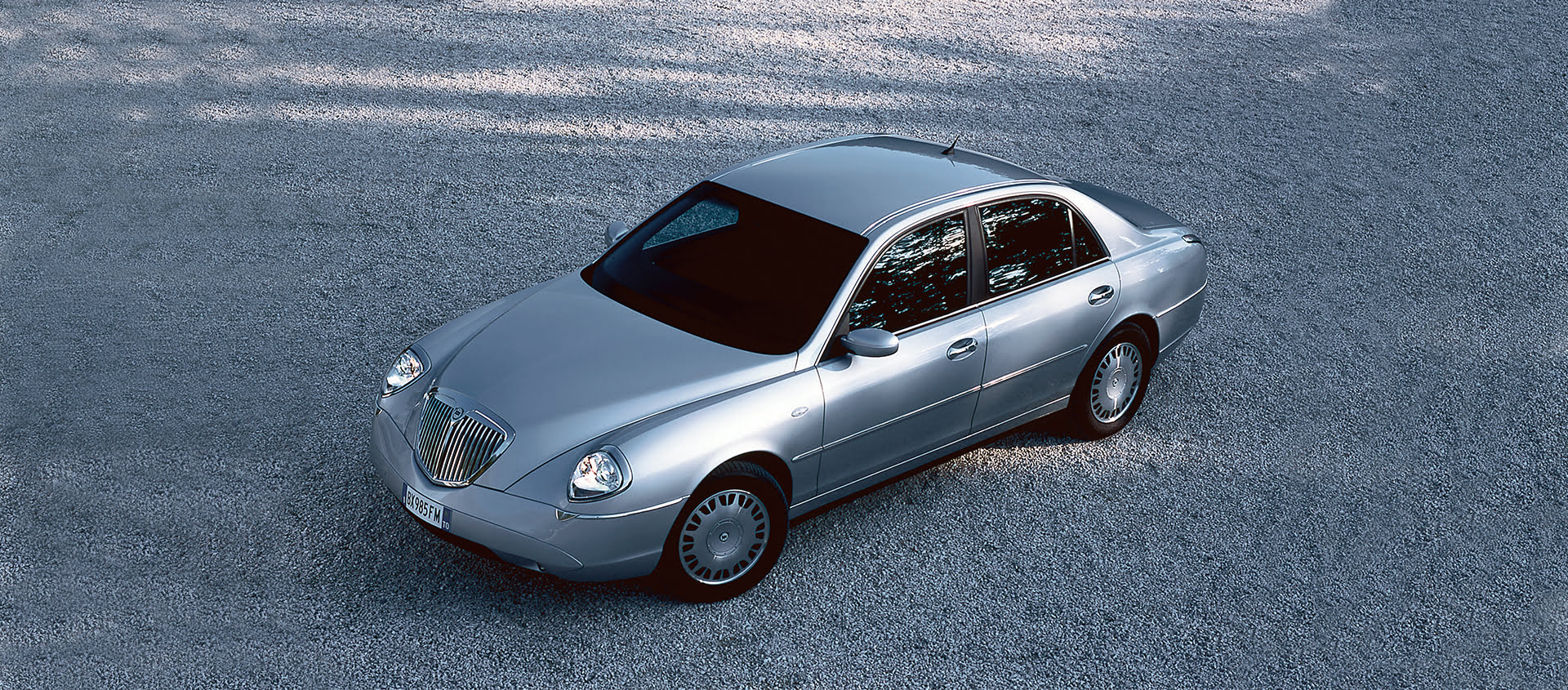
In 2002 with the Thesis, Lancia launched a valid attempt to return once again to the place it rightly deserved in the annuals of the automobile. The endeavour was inaugurated through a new flagship concept that offered a brave and very astute mix of the past and present and encompassed the celebrated legacy of the Turin brand.
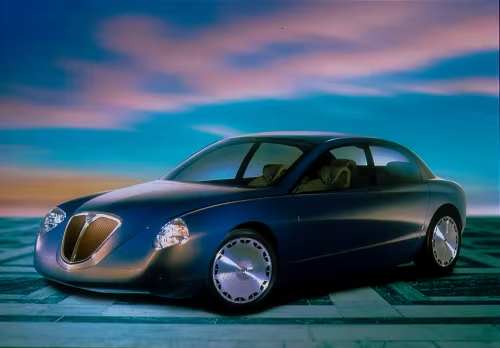
The idea first came to light in 1998 at the Turin Motor Show where a concept called Dialogos was revealed, a semi-final prototype of a three-volume sedan with suicide doors and advanced technological components. The Dialogos was warmly received and a large investment was approved to put it into production. Surprisingly, in 2000, a version appeared for Pope John Paul II, which was given the name “Giubileo” (Jubilee).
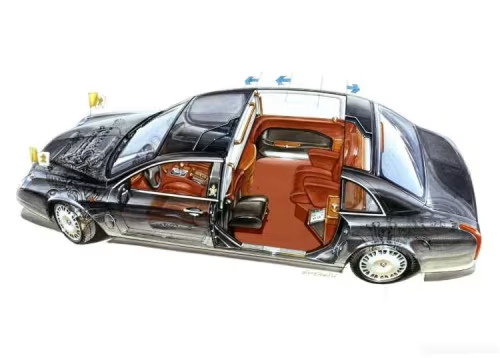
At its presentation, in 2002, it was clear how Mike Robinson, chief designer at Lancia, wished to combine the stylistic features of the past with more decisive, contemporary touches; the nose that featured a large Lancia radiator grille, the diamond-shaped headlights and the soft fenders were reminiscent of the Aurelia, while at the rear those characteristically thin and innovative LED lights that look like slender fins, recall the Flaminia. The Thesis heralded a new stylistic language that was balanced by the opulent classicism of the interior. A language that was difficult to understand as history would sadly go on to confirm. The Thesis had the difficult task of repositioning the brand and bringing it back to international markets where Lancia had been absent since the early nineties after the Lancia K debacle.
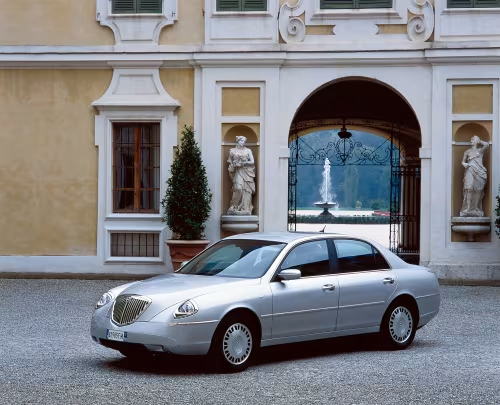
A promise it was unable to fulfil as only 16,000 examples were produced. The rarity that followed, especially for the top-of-the-range versions powered by a 215bhp 3.0 V6 or the 230bhp 3.2 V6, both petrol engines sourced from Alfa Romeo and designed by Giuseppe Busso, makes it a somewhat inexpensive future classic worth betting on.
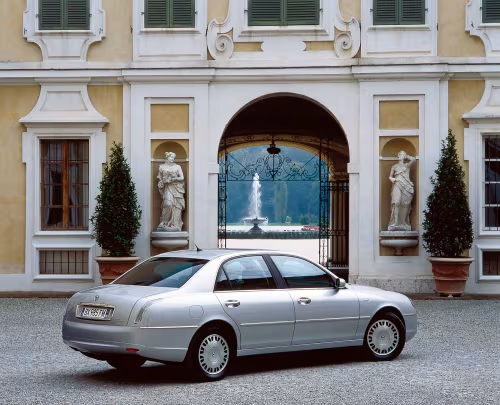
Is that a fish?
Related stories.

Apr 1, 2020
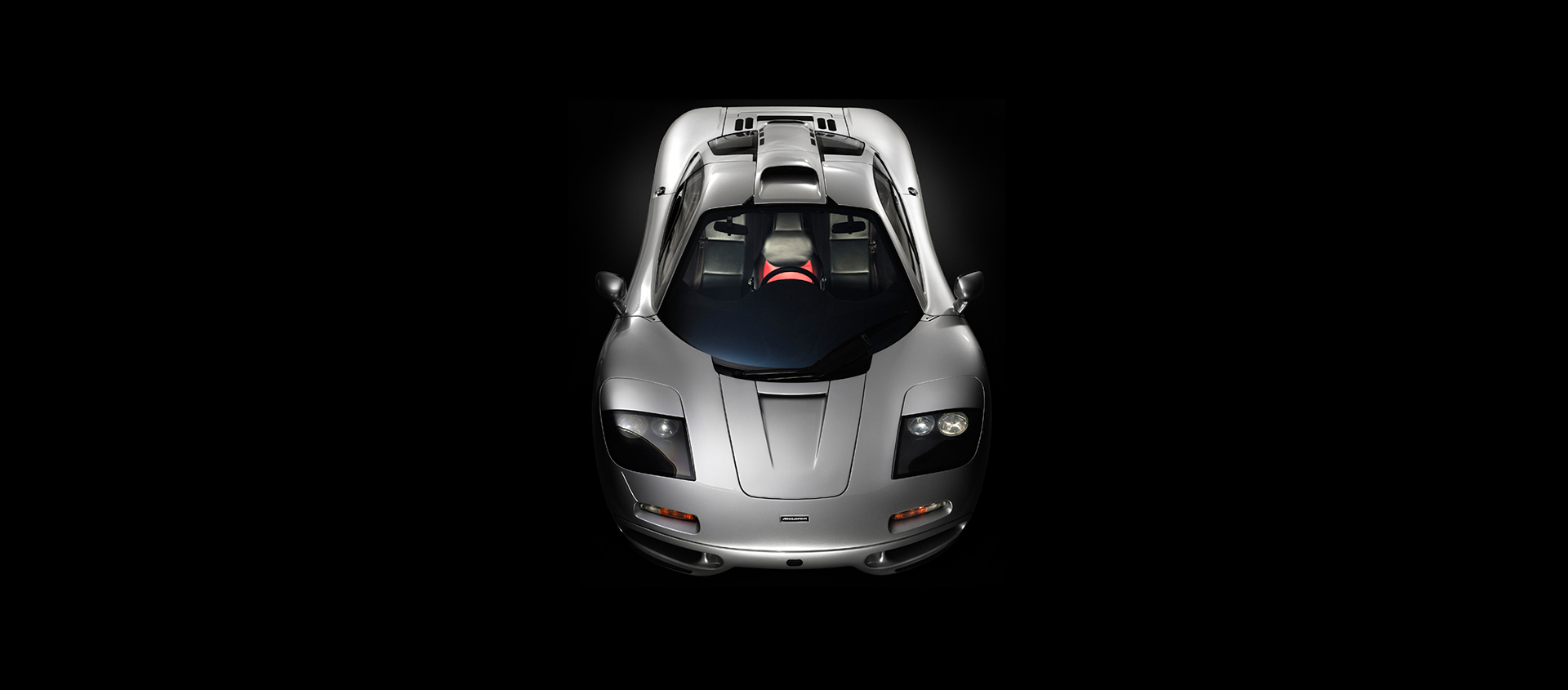
Mar 18, 2020
1992 mclaren f1.
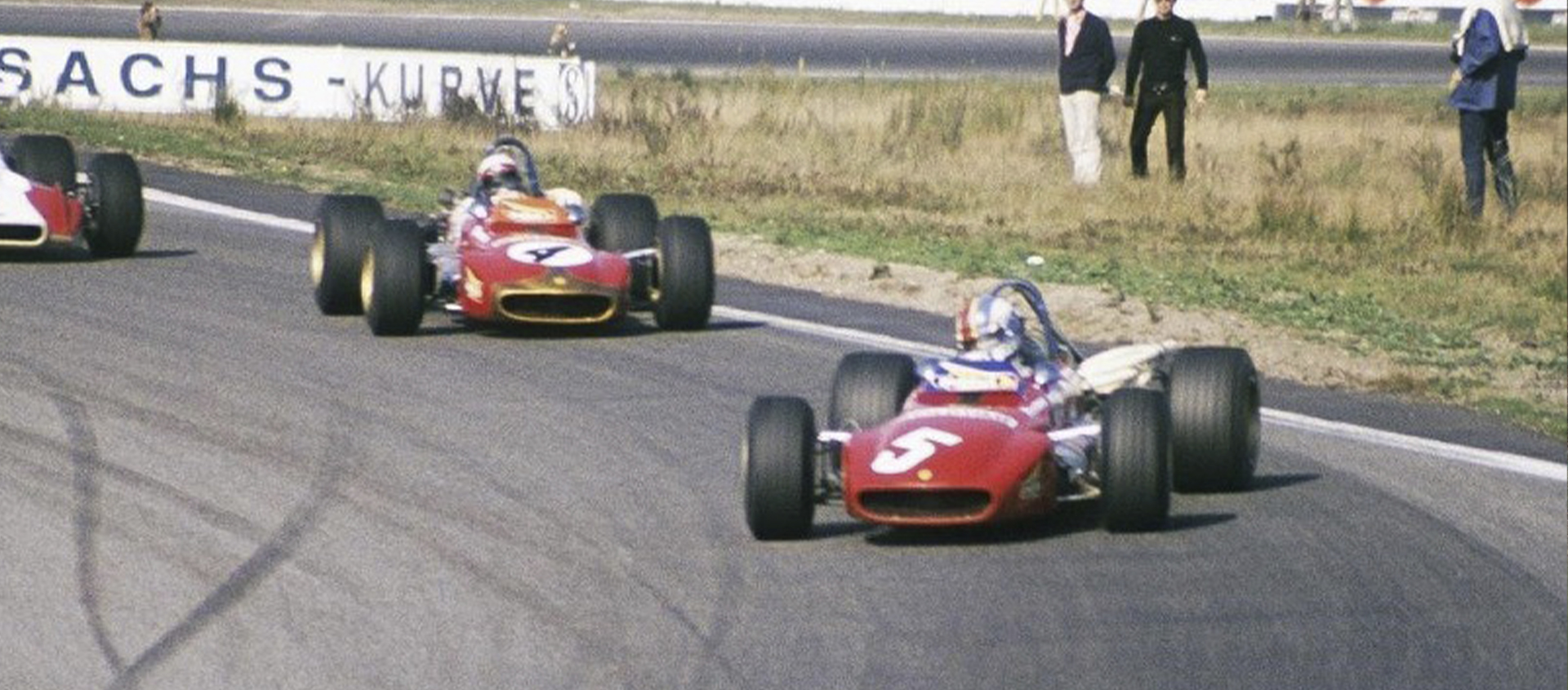
Nov 12, 2022
Forgotten legends tecno, related manufacturers.

SUPERMIND TRIVIA

- return to home home
- class schedule
- why #bhlingual about
- keep in touch contact
- sign up for class
About #BHLingual | Blog
T: (323) 651-5000
Why #BHLingual
Learn More About the Beverly Hills Lingual Institute
Choose From More than 35 Languages
Class Schedule
Get started
Steps to Registration
Sign Up for Class
Read the Blog

chinese (mandarin)

filipino/ tagalog

greek (modern)

persian/ farsi

serbo/ croatian

Lancia's Thesis was its Requiem
Return to blog index.
It has been conjectured that Fiat's attempt to take its storied Lancia charge from rallying legend to a somewhat effeminate near-luxury brand, overtly geared to women, was doomed to begin with.
_001.jpg)
However, today - perhaps, particularly this year - it's worth remembering the brand's last flagship, the Thesis, for a memorable ad in which Italian actress Maria Grazia Cucinotta appeared, riding a bike along a tree-lined avenue.
A number of large cars whizz past her, causing her hair to fly uncontrollably, and even her skirt to lift. She stops, annoyed. When a Lancia Thesis approaches at high speed, Maria prepares for yet another buffeting; yet her skirt barely flutters, as the breeze caresses her hair. The car overtakes her gently, quietly, and smoothly.
As the film ends, the cyclist and the driver exchange glances, in mutual recognition of this sophisticated demonstration of power, one which has left room for courtesy and sensitivity.
Lancia is - perhaps soon, was - one of the world's oldest automakers. Founded in 1906, it became known for technological innovation and craftsman-like attention to detail.
.jpg)
In the Twenties, the Lancia Lambda was the first car in the world with stress-bearing bodywork, eschewing the frame to which American automakers would remain true for the better part of the twentieth century. The Lambda was also first with independent front suspension.
.jpg)
France's Citroën would become famous for its obsession with wind tunnels and aerodynamics, but Lancia's Aprilia of the Thirties boasted a wind-cheating body before Citroën had ever mentioned coefficients of drag; and registering a C d of 0.47 back when the average value among the competition was a bluff 0.60.
.jpg)
And in the Fifties, under the Aurelia's hood was the first V-6 ever fitted to a roadgoing vehicle.
From the 1970s onward, under Fiat ownership, Lancia wrestled with reliability and rust prevention, while also struggling to retain its identity. Fiat became increasingly intent on integrating Lancia into its engineering and purchasing systems, which saved cost but also hurt competitiveness - particularly in the upper echelon, where being authentically distinctive is important.
_001.jpg)
The '80s rallying success of the legendary Lancia Delta Integrale - six consecutive world championship titles - gave Lancia something truly unique to talk about again. More recently, its Ypsilon city car proved very popular.
But the soft, sinuous lines for which many remember Lancia need a large canvas to really work.
-V6_001.jpg)
Lancia's last commercially successful flagship was the 1985 Thema. The Thema's successor, the Kappa, had not done quite as well, despite plaudits for its refinement, packaging, and capable chassis. Some said that Kappa's use of an Alfa Romeo platform had condemned it to also-ran status.
Determined to regain its stature, Lancia decided to pull out all the stops. In 1995, it launched itself into researching what the typical Lancia customer - the "enlightened bourgeois of the 1950s and 1960s," as Fiat Auto managing director Roberto Testore put it - would want at the turn of the Millennium.
-concept_001.jpg)
The answer came in the form of Mike Vernon Robinson's stunning "Diàlogos" concept of the 1998 Turin Motor Show. The high front, long bonnet, and profile resembling an upside-down wedge marked a new formal language, one which refuted the school of rational forms in favor of emotional elegance. Its large, vertical grille was flanked by diamond-shaped headlamps; its sculpted, shapely fenders broke away from the hood line in a manner similar to cars of the Thirties and Forties. All of this bucked the trend for over-rational, visually spare shapes.
-concept_004.jpg)
"Exciting elegance goes far beyond rational utility to leave space for the imagination," Lancia enthused. Though controversial, the look successfully averted the customary protruding bumper and consequent front overhang of front-wheel-drive cars.
Neither Fiat nor Alfa Romeo had anything rear-wheel drive. The new Lancia flagship - unlike the Mercedes-Benzes and BMWs with which it would compete - would thus be front-drive. That apart, however, Lancia promised that the Thesis platform would not be shared with any other cars in the Fiat group. Fiat had virtually invented platform sharing, but was now developing spaceframe technology which allowed the basic chassis to be tailored to different cars, with flexible dimensions and flexible mountings.
-dashboard.jpg)
Inside, innovative telematics technology would prove that the Italians had, finally, mastered multiplexing; with the added bonus of providing intriguing contrast to the retro exterior. There would be a seven-inch TFT color display in the dashboard, with navigation, voice recognition, a hands-free phone, and an optional television. Other options of note would include radar cruise-control, a sunroof with solar cells to power the air conditioning when the vehicle was parked in the sun, dual climate zones for the rear passengers, power assistance when opening the doors, tri-fan ventilated and massaging seats, an electronic parking brake, and an eleven-speaker Bose audio system.
-interior.jpg)
Each Thesis would get eight air bags as standard, and electronic stability control.
The doors would close as soundly as those of a Mercedes E-Class, and the materials employed in the cabin would be used not merely for appearance, for also for the tactile and acoustic reactions they aroused.
"People will be looking for excuses not to buy this car. So, we wanted to be damn sure we didn't give them anything to hook onto," Robinson told CAR magazine.
Underlining the technology within were bi-xenon headlights and thirty LEDs per taillight.
The Italians were particularly proud of their telematics system which, they promised, was the easiest to use around. This, remember, was just as BMW's iDrive launched in the E65 7 series, confounding journalists and owners alike.
However, like the French , the Italians had never been particularly good at electronic gadgetry. The car suffered several delays.
"Trimmed as it is in acres of (real) wood, leather, and alcantara, it's sure to become a favorite among Europe's executive class," wrote Frank Markus for Car and Driver in February 2001 upon seeing the finished result at Geneva.
"The cabin is truly rich, and walks the right side of that line in Italian style dividing the perfectly proportioned minimalism from their bling-bling rap-star Versace vulgarity," said Paul Horrell for CAR. Horrell was particularly impressed with the lightly-varnished wood trim and cast magnesium in the center console. "I can't tell you how much more satisfying it is to use a cupholder or ashtray that glides out of solid metal than some clacky plastic lid."
The car would be named "Thesis" which, like Thema, recalled a letter from classical Greek. This, said Lancia, conjured up the image of culture, while also conveying the idea of advanced scientific research and state-of-the-art technology.
_005.jpg)
Originally planned to launch in 2000, the Thesis in April 2002 finally became the largest and most luxurious sedan in the Fiat Group portfolio.
To Lancia's credit, the challenging front and rear fasciae of the concept had been retained for production. Yet something had been lost in translation; mostly, perhaps, in the flanks. Something about those door frames seemed more plebian than the rest of the car, and that bulging waistline, much though (as design critic Stephen Bayley has suggested ) it might have recalled the 1965 Flaminia, did not quite fit.
_002.jpg)
Rumor had it that some degree of inflexibility in Fiat's early spaceframe strategy had forced the change in proportions.
Whatever the reason, the Thesis tended to photograph as though three cars: front, sides, and rear. Not for nothing was it frequently described as simultaneously pleasantly controversial yet frustratingly mellow.
_003.jpg)
On the road, where the human eye tends to focus on one aspect, the Thesis' lines worked better. Front and rear, from a dead-on perspective, it looked at least as rich as the German competition, and certainly exhibited more character.
To drive, Thesis should have been fairly capable. Its aluminum front suspension was a development of the traditional double-wishbone layout, which enthusiasts find preferable to MacPherson struts. Five links controlled the movement of the front wheels, yet kept virtual steering axle as close as possible to the wheel center, to benefit steering accuracy and response. At the rear, various arms in aluminum, steel, and cast iron provided a fair degree of passive rear steer. Grip was decent, particularly for a car which weighed four thousand pounds. Predictably, the nose would eventually run wide under hard cornering, but the lack of feel through the steering was as frustrating as its non-linear response.
_004.jpg)
The odd twitchiness of the chassis could pay off, however, as the Thesis was throttle steerable. Lift off, and balance would be restored.
The silent cabin, with its five-millimeter glazing, met a ride that was very good indeed. For the body control, and superlative smoothness over the most pocked roads, one could thank Maserati, who (together with Mannesmann-Sachs) had engineered those six-sensor, semi-active dampers for its Spyder sports car. More akin to a Jaguar than to the German competition, so good was the suspension's ride quality that it even had a name: "Skyhook." Buick would unofficially borrow that name to describe the ride of its own cars.
Predictably, the Thesis' most popular engine was the torquey yet economical 2.4-liter JTD diesel. Surprisingly in thrifty and displacement-taxed Europe, gasoline buyers bypassed the two-liter turbocharged and 2.4-liter five-cylinder models in favor of the sonorous, Alfa-derived three-liter 24-valve V-6.
Lancia had invented the V-6, and this particular engine revved happily to its 6,300-rpm power peak, and 7,000-rpm red-line, producing 215 horsepower and 194 foot-pounds of torque. That made for a top speed of one hundred and forty-six mph; but the Thesis’ sheer heft ultimately conspired against it, resulting in a rather relaxed, 9.2-second 0-60 mph time.
A 3.2-liter V-6 was also available. Plans were made to offer Cadillac's Northstar V-8 and a three-liter Isuzu V-6 diesel was offered as well (to be shared with the Saab 9-5 and Renault Vel Satis), but Fiat's messy divorce from General Motors in 2002 put paid to that.
Thesis was supposed to support an effort to push Lancia sales from just one hundred and fifty thousand in 2001, to three hundred thousand by 2008.
However, Thesis failed to hit even the modest sales goals Lancia had set for it: a mere thirteen thousand and two hundred units in 2002, and hopes for twenty-five thousand in 2003. Mind you, in true Italian fashion, they could never quite agree on a target. Juan Jose Diaz Ruiz, executive vice-president for marketing and sales, was more ambitious. He foresaw annual sales of thirty-five thousand cars.
In the end, they sold just sixteen thousand over seven years. Sales ran through 2009, but the Mercedes-Benz, BMW, and Audi triumvirate was never threatened. More to the point, the Thesis couldn't nearly match the sales of its Kappa predecessor; and the Kappa, in turn, had not done as well as the Thema before it.

Lancia took the failure on the chin, having invested four hundred and five million euros in the project (one hundred and eighty-five million for R&D, and two hundred and twenty-one for tooling).
Following 2010’s Fiat/ Chrysler tie-up, Lancia CEO Olivier François took on the additional role of Chrysler CEO. He saw a parallel between the two brands. For the past ten years, he noted, both had strived to offer, to varying degrees, a quietly elegant, near-luxury experience. Both were positioned as style-conscious brands for upwardly mobile, trend-setting customers.
François was widely regarded to have done a good job at Lancia with limited resources. Despite the long-running Ypsilon and Musa both being based on the floorpan of the last-generation Fiat Punto, and though the Lancia Delta was constrained in its proportions by the Fiat Bravo platform, Fiat’s near-luxury brand had ridden out the effects of the economic downturn remarkably effectively. In a down market which had battered the auto industry, Lancia’s sales in 2009 had remained flat.
But François would sound Lancia's death knoll when he rebadged various Chryslers - including a minivan - as Lancias.
Today, Lancia sells cars only in Italy - and its only car is the little Ypsilon hatchback. The brand is not expected to last much longer.
What a pity. Thesis was a colorful car in a conservative segment - a dignified expression of what Lancia thought its brand could be in the modern era. However, after several years of lackluster cars, for one model to muster the distinction to support a hefty price tag was always going to be a tall order. And the relevance of Lancia's somewhat muddled brand values, post-Millennium, was at best debatable.
Writing for CAR, Paul Horrell saw this clearly at the time. "Imagine a Rover 95 (a theoretical step-up from the British brand's retro 75, which debuted at roughly the same time as the Thesis and which also proved to be its maker's swansong) and you would be spookily close.
"It's a scary thought: two brands that refuse to be youthful or sporty (are the) two brands that have underperformed."
Further reading
Lovely and wrong: Richard Herriott assesses Lancia's former flagship Driven To Write
Thu 14 Dec 17
- Communication
Contracts and Cultures
Not every culture sees contracts as indispensable. And once a contract has been signed, different cultures may view its purpose in different ways...
ABBA are back
Half a century since ABBA's debut, there is a certain comfort in hearing, in uncertain times, new music which sounds fresh in 2021 but could—almost impossibly—seamlessly have featured on some of the best loved pop albums of 40 and more years ago...
Happy Dragon Boat Festival
Many legends are associated with the 2,000-year-old Dragon Boat Festival. The most famous tells the story of Qu Yuan, a poet from the State of Chu during the Warring States Period (475 - 221 BC)...
70 Years of Volkswagen in America
In 1949, the first Volkswagen Beetle was shipped to the United States. Since then, VW's road in America has been full of twists and turns. Now, the company is preparing for electrification...
4 Characteristics of Culture every Global Business Should Recognize
Companies' operations, chiefly marketing and management, need to adjust to the cultural environment existing in the countries the global company serves. The ability to do so often means success in international markets...
I Look Up As I Walk
Ue o Muite Arukō (the Sukiyaki song). From Japan, here's an evergreen tune about smiling through the tears...
The Values of Volvo
Portrayed as a thoughtful purchase that will reward its owner for years to come, Volvo has always had a strong, unique (and Nordic) identity...
What Are You Doing for Chinese New Year?
Follow a dancing dragon down the street. Listen to the popping firecrackers. Scatter your home with Jí Xiáng Huàauspicious gold couplets of good luck across a red scroll...
German on Both Sides of The Wall
The conscious use of East German words suggests Ostalgie - the tendency to reminisce about the former GDR in post-euphoric regret that its positive features were not preserved...
Cartier. Louis Vuitton. Chanel. And Avantime.
Cartier. Louis Vuitton. Chanel. And Avantime. That was the association Renault wanted you to make when it launched its latest segment buster more than fifteen years ago...
Today is Macaron Day
March 20th is World Macaron Day. With their bright colors, crispy exterior and delicious filling, macarons are fun, fanciful, and decadent in true French fashion...
My Mother's Persian Stories
My Mother's Persian Stories is a collection of thirty bedtime stories as told by Saeid Shammass' mother as the family was growing up in Shiraz, Iran...
Tribute to the Balkan King of Folk
The Balkans is in widespread shock over the recent death of singer and songwriter Šaban Šaulić. For many across the former Yugoslavia and Bulgaria, he was the undisputed 'King of Folk.'..
The Prettiest Car of the Year is French
The latest example of Gallic cool is the new Peugeot 508, recently elected the prettiest car of 2018. It's the latest recognition of design head Gilles Vidal's attempts to turn the brand around...
Africa - More Languages than any other Continent
Africa is as complex a linguistic area as it is vast. It has at least 10 times as many languages as Europe, with fewer than twice the number of people...
What Can Language Not Do?
Language is fairly good at conveying simple pieces of factual information. It's also given to persuasion. Spatial information and feelings, however, are another matter...
Accord - Honda's French-named Heartland Car
Clearly designed, from the outset, around feedback from the global market - and America in particular - the family-sized Accord helped Honda more than double its sales by the close of the '70s. No Honda more embodied the company's giant-killing power and thoughtfulness in design...
A Star is Born
By now, you've probably seen the film everyone is talking about. Did you know that Bradley Cooper speaks French?..
Time for a Saab Story
Perhaps you've owned a Saab. The research would indicate that you were among the most educated group of drivers on the road...
Andalucia, en Ocho Joyas
The Eight Most-Visited Monuments in this Southern Spanish Province's Eight Capitals...
Live @ the 80th Belgrade Auto Show
From the other side of the world, we've got a report from the Belgrade Auto Show, first held eighty years ago, in March 1938. It's something of a Bluffer's Guide to the European car market...
Ten Points for Your Next PowerPoint Presentation
In addition to completing text-based content in 'Outline' view before succumbing to the temptations of templates, clip art, and animations, here are ten points you may wish to consider before your next PowerPoint presentation...
For Better or Worse, the Quintessential Alfa
Many an Alfa owner can tell painful tales. Yet, if you're a card-carrying 'Alfista,' all is forgiven. For nothing can make the hairs on the back of your neck stand on end like the joyful cry of an Alfa at full song...
Bavaria's Fuggerei Social Housing Complex
Known for beer and BMW, Bavaria is also home to the only Mazda museum outside Japan - and to the Fuggerei, one of the oldest social housing complexes in the world...
Idioms from Around the World
Knowing idioms in other languages is the difference between mechanically parroting a series of words in a grammatically correct fashion, and beginning to 'think' in that language...
Who Misses Skeuomorphism?
Steve Jobs used to say that the details mattered. Emulating the aesthetic of physical objects on a two-dimensional screen was time consuming, but the effort required fit Jobs' design philosophy perfectly...
Kenya's Mobius, Designed for Africa
If asked to design a budget SUV for Africa, what would you engineer? A space frame, for durability? Long-travel coil springs, for better absorption? Or leaf springs, for better articulation? Aluminum panels, for sturdiness?..
There's Curry and There's Kari
While the curries which we eat today are a product of India's long history, that history has involved many cultural influences - from the indigenous Ayurvedic, through Portuguese, Mughal, and British...
Se Habla De La Paella Como Un Dogma
Like Seinfeld restauranteur Poppie's opinions on what a pizza is and isn't, many will have strong feelings about paella...
Cultural Context in Communication
We find that native-speaking teachers are best placed to communicate not only language, but the subtleties of the cultures in which that language is spoken...
Determined to regain its stature at the turn of the Millennium, Italy's Lancia pulled out all the stops with the colorful Thesis. It was, they said, a flagship for the enlightened bourgeois...
Dining in Denmark (Smorrebrød/ Smörgåsbord)
It is essential to be punctual for appointments in Denmark. If you are invited to a Danish home for a meal, you are expected to bring the host or hostess flowers or a bottle of wine...
Sushi - Arranging for Long Life
A delight to the eye as well as a revelation to the tongue, sushi is an engrossing culinary happening that those who have tasted will not soon forget...
Renault Goes Big, then Goes Home
American Motors needed a front-drive compact. Renault needed a serious dealer network in America. The result was one of the first transatlantic deals in the automotive industry...
The Wrong Way to Learn a Language
Language learning is not a set of easy steps that can be programmed in a quick do-it-yourself kit. That's part of why we strongly suggest you learn by immersion. The alternative is not pretty...
The Hungarian Language
Hungary is a fascinating country, with a captivating culture - and a beguiling language which has a reputation for being among the most challenging to grasp...
Mazda's Special Relationship with Germany
You might imagine that the land of the Autobahn would appreciate every attempt to inspire confidence at speed. Mazda's relationship with Germany goes back much further, however...
Black Friday Around the World
What began in America to mark the start of the festive season in the 1950s is quickly turning into a global phenomenon...
Happy Fortieth, Peugeot 305
It's the second time this year that we're writing about a French car with a milestone birthday. Endearingly, it's also the second time that Peugeot is celebrating a joyeux anniversaire on Twitter...
Uh-Oh The Glottal Stop
We've found that our Danish students can have trouble imitating the glottal stop used in that language...
The Languages of Doctors
Spanish and Hindi are reportedly the two most widely spoken non-English languages among American physicians...
How to Establish a Brand
Our students here at the Beverly Hills Lingual Institute are some of the most interesting and accomplished people you could hope to meet. One reminded us of Saab the other day...
The Luxury Experience
As with so many things worth contemplating, there's a delicious irony to luxury - a concept which has wide appeal, but which is out of the reach of the majority. Luxury has always been somewhat ethereal and difficult to pin down...
How Much Do You Know About Hungary?
Franz Liszt. Béla Bartók. The Austro-Hungarian empire. Paprika. Goulash. Esterházy cake. All of these things are part of the heritage of Hungary, a small central European country with a dramatic, 1,100-year history...
What Did Helvetica Tell You Today?
We are surrounded by type and typography. There's every chance that the typeface you see most is Helvetica. It has been dubbed the 'perfume of the city' - you don't notice it much, but you'd miss it if it went away...
Spanish Shark, Korean Coup
The 1997 Tiburon signaled a change in Hyundai's goals and image. At its debut twenty years ago, it became the first Hyundai to turn heads on the freeway...
Filibustering, Gerrymandering Lame Ducks
Why do we call a politician's verbal delaying tactics a 'filibuster?' Why is redistricting to gain political advantage called 'gerrymandering?'..
Learning Language is Child's Play
Imagine that you have decided to learn German abroad. Upon your arrival in Hamburg, you begin by memorizing a German grammar book and a table of the two hundred and forty-eight irregular German verbs...
Nostalgic for a Friendlier Future
Honda has surprised journalists and enthusiasts alike at the ongoing Frankfurt auto show, with the electrifying Urban EV, a modern take on the original Civic...
Language as Jazz
Language will become your guide to the ways in which different cultures express not only ideas, but emotions...
It's All Polish To Me
If you know any other Slavic language, you'll find more than a few cognates in Polish. If Polish is your first Slavic language, it makes a great gateway to the others...
Boas Noticias - You Know 40 Portuguese Words
Good news! You already know at least forty words in Portuguese...
Farsi is Sugar
Farsi shekar ast. This is how Farsi speakers refer to the Persian language. They believe that speaking Farsi is a sweet treat to the tongue...
76 Common Verbs for Dutch Learners
As we recently wrote, vocabulary is the most difficult aspect of learning a language. Here are seventy-six common verbs for Dutch learners...
Which Are the 'Easy' and 'Hard' Languages?
Any language has three distinct components: pronunciation, grammar, and vocabulary. Contrary to what many believe, pronunciation is not the hardest feature of a language to master...
So You Want to Learn Hindi?
When you learn the Hindi language, you will find the beauty, the simplicity, and the joy that lies therein...
Ingrid Bergman on Language
Swedish actress Ingrid Bergman, who knew five languages, was once asked which she preferred...
The Origin of Lean Production
We tend to associate the concept of 'lean production' with the Japanese; and with Toyota, in particular...
The Secret to Reading Japanese
Japanese characters may look mysterious and impenetrable to the uninitiated - but we'll show in a few examples that they are not at all difficult to understand...
Losing the War One Slide at a Time
Audiences are difficult to capture and harder to retain. Knowing what to leave out - what detracts from the basic message - is just as important as knowing what to put in...
British car, Japanese origins, French fans, unsure Germans
To look at the Rover 600, you'd be hard pressed to tell that it had come from a Honda Accord. A French poll - and they say the French know about these things - even saw it voted the world's most beautiful car...
Blowin' in the Wind
Although Bob Dylan's 'Blowin' in the Wind' was a discussion of social change, he might just as easily have been referring to Dutch energy policy fifty-five years later. All Dutch trains now run on renewable wind energy...
Getting Around
How did people get around before GPS receivers? Nomadic tribes used the sun and stars to navigate. There is evidence that these rudimentary navigation systems were developed independently by very diverse cultures...
Alpha, Bravo, Charlie
We all share the skies. In 1927, the standardized ICAO phonetic alphabet was created to help aircrews around the world communicate their names and locations...
Choosing a Language to Learn
We've all heard that there are benefits to being bilingual. However, picking a language to learn can be a daunting task...
Are You a Dog or Cat Person?
The difference in the paths to domestication of dogs and cats could explain the difference in their behavior. Dogs tend to be dependent on their owner, whereas cats are often described as having a mind of their own...
The First Volvo
The first Volvo - the ÖV4 - was not quite the vehicle the company founders had hoped for. However, its failings no doubt set Volvo on a path to developing the durability which would become a cornerstone of the marque...
Improve Your Public Speaking
The more comprehensively a speaker understands a language, the better they are able to use it to deliver their message accurately and memorably...
Where Did I Come From?
Many of us develop a keen interest in our origins - as evidenced by the number of our students who begin learning a language to better understand a culture that is part of their family heritage...
Happy Emoji Day
Believe it or not, there is an Unofficial International Emoji Day - and it is today, July 17th!..
Czech Out the First Robots
The word 'robot' comes from a 1921 Czech play, 'Rossum's Universal Robots' (Rossumovi Univerzální Roboti)...
Local Tastes, Global Image
Success in the food export industry is probably best described as a combination of the flavor of the product (with some adaptation for local markets), satisfying expectations in preparation and packaging, and the product's image...
Mind Your Grammar
Let's take a look at grammar from the point of view of the linguist. To do that, we need to consider three distinct types of grammar for every language: Mental, Descriptive, and Prescriptive...
Lipstick is Always a Good Idea
Unlike many a beauty trend, red lipstick has stood the test of time. Egypt is where the manufacturing of lipstick became what it is today...
Is this a BMW?
You won't see BMW's 2 series 'Active Tourer' on the streets of Los Angeles. It's a Europe-only model, launched in 2015. And it is perhaps the most ill-advised move the Bavarians have ever made in modern history...

Whose Pasta is it, Anyway?
When you think of Italian cuisine, pasta is probably the first thing that comes to mind. But while we think of pasta as a culturally Italian food, it is likely the descendant of Asian noodles...
Learn French - The Language of Diplomacy
It has often been said that there isn't much love lost between the French voter and their chosen politician. Perhaps it is ironic, then, that French is widely known as the language of diplomacy...
How Many German Words Do You Know?
Let's not forget - The words for America's favorite foods are German... hamburger, frankfurter, and wiener...
East Germany's Trabant People's Car - a Reprieve
The East German Sachsenring Trabant has long been a symbol for the failure of communism. That's a pity, really, because it's an interesting car in its own right...
Como agua para chocolate
Tita de la Garza is a young girl who lusts for Pedro. He feels the same way. Unfortunately, a family tradition forbids Tita from marriage...
Traveling Tips
Traveling this summer? We've got you covered...
You Know More Spanish Than You Might Think
In many places across the United States, Spanish is encountered at every turn - on street signs, on buses, at banks, at restaurants... even in your junk mail...
Happy Birthday, Peugeot 405
Peugeot is very proud of the 405; so proud, in fact, that the Peugeot Museum at Sochaux is holding a 30th birthday party for the car tomorrow (Saturday, June 17th)...
I Love Daddy
Most babies speak their first words between their first birthday and eighteen months of age. In the very early stages of learning, there is a difference between what a child hears, and what they can say...
You Know at least 78 Words in French
About thirty-five percent of English vocabulary is of French origin. Tou might be surprised by how much French you already know...
The Challenges of International Marketing Research
If you want to know what consumers think, ask them. It sounds simple enough. But when marketing research goes international, the problems multiply quickly...
Volvo wants Engineers, and they want Volvo
Swedish engineering students have selected Volvo Cars as the most attractive employer in the country. The company is looking for hundreds of new software engineers to strengthen the development of next-generation technologies in safety, autonomous driving, and electrification...
Reasons Our Students Choose Italian
Among the foremost reasons so many of our students give for picking Italian is that, for English speakers, Italian is among the simplest foreign languages to grasp quickly...
We'll Bring the Coffee
For many, that first cup of coffee can make or break the start of the day. For our language students, a stop at the coffee pot before class is an important ritual. Coffee is rarely just a stiff shot of caffeine...
All Things French: Fashion Capital of the World
Since the 16th century, France has been the center of design and haute-couture, exuding grandeur and refinement. Today, French fashion continues to maintain its olde-worlde tastes of elegance and glamor, while assimilating modern styles through original design approaches...
Why is Having a Bilingual Brain a Benefit?
Being fluent in different languages has been shown to improve an individual's concentration, while warding off the onset of dementia, Alzheimer's, and other diseases that cause deterioration...
Spain's Youthful SEAT Car Brand
SEAT's customers are eight to ten years younger than those competing brands. It's not just about Latin flair; SEAT focuses mainly on small cars...
A Guide to Summer Shopping in Italy
As July approaches, so does Italy's traditional summer sale; and my favorite sport - window shopping...
The Challenges of Learning Arabic
The Arabic alphabet is not difficult to learn, and some aspects of Arabic grammar have been compared to algebra. However, plural nouns, verb conjugation, and vocabulary can be challenging to master...
Pick-ups Over Here, Hatchbacks Over There
The American and European car markets are roughly the same size. However, there are several differences between vehicles popular in, and made for, the United States, and Europe...
Tulips are known as the flower of springtime in the Netherlands. Tourists and locals alike flock to visit the country's many beautiful flower gardens. Yet this iconic flower is not Dutch!..
Saving Hebrew
Hebrew was virtually dead as a spoken language - until a father and son persuaded their community that all could have a hand in restoring Hebrew, and modernizing it, word by word...
The First Modern Hatchback
French motoring journalists had long been muttering over their Gauloises about the need for a new mid-market Renault. The R16 of 1965 was the first modern hatchback, versatile and comfortable...
Keeper of the Bridge
'Most,' in Serbo/ Croatian, means bridge. 'Stari' means old. 'Mostar' could be - and has been – loosely interpreted to mean 'Keeper of the bridge.'..
The Anti-Pensioner Volvo
Ask most people when Volvo began to change its frumpy image, and many will have forgotten the dramatically wedge-shaped 480 ES hatchback of 1986, a curiosity in the herewith staid Swedish automaker's offerings...
Introduction to the Philippines
Filipinos are quick to point out that their colonial past has seen them spend three hundred years in a Spanish convent, and fifty more years in Hollywood. This has given Filipino culture the opportunity to selectively adopt religious and cultural influences...
Where Women Brew the Village Beer
Some Zulu have opened up their homes and villages to tourists who want to learn about traditional Zulu culture. The villagers offer unusual vacation packages...
Bewitchingly Flawed
As CAR magazine once put it of the Ferrari 348 - the final V8 mid-engined model to be developed by Enzo Ferrari himself - 'A Ferrari – even a flawed Ferrari – is simply too bewitching.'..
Just the Happy Country Songs, Please. We're Japanese
Enka music is very Japanese - the tear-stained crystallization of the long-suffering Japanese heart. And country music, being quintessentially American, is by definition the exact opposite...
Japan's Caprice
Toyota had made its name on reliable small cars. Now, Toyota wanted to increase its profitability – and that meant Cressida: a larger, more prestigious car...
The First Martians
The problems that arise when something is mistranslated can be comical – indeed, dangerous – and can have far-reaching consequences. NASA reminds us of an unusual instance which dates back to the late 19th century...
Dolma or Tolma?
There's no point arguing. Any dish that evokes the spirit of a particular Armenian community, any dish that makes them feel that it is Armenian, is Armenian...
Jetta: Hip to be Square
The Jetta and its irreverent advertising led legions of Gen Y drivers to Volkswagen, lured by the fun image the company projected...
Speisen wie Gott in Frankreich: Wiener Schnitzel
These thinly pounded cutlets that are first breaded and then fried are so beloved that they've even made it on the menus of such elite restaurants as Wolfgang Puck's Spago in Beverly Hills...
The Big-Hearted Will Take Away the Bride
Dilwale Dulhania Le Jayenge recently celebrated its 20th anniversary. This evergreen story of a young man in love with a girl whose father does not approve, celebrates the best of Bollywood...
Dutch in Paradise
A Dutch physician once claimed that his mother tongue was the best and oldest language in the world. According to him, Adam and Eve spoke Dutch in paradise...
The World Envies Us for One Thing
The best Lancias have been faintly mad, evincing the uneven dollops of brilliance that played a role in their conception. The 1976 Lancia Gamma, particularly in coupé form, certainly fit that description...
Nyusu Flash: You Know 26 Words in Korean
English comprises over ninety percent of the 20,000 loanwords currently used in Korean, and new words are being added on a daily basis...
La Tour Eiffel: Ça, c'est Paris!
At its inception, a chorus of opposing voices rose to protest France's Eiffel Tower, attacking it as a meaningless gesture, devoid of function and too reminiscent of an industrial smokestack...
When I See an Alfa Romeo go by, I Tip my Hat
After a twenty-one-year absence from America, Italian Alfa Romeo is back. Will initial attraction translate into a long-term partnership?..
How Does the Bilingual Brain Work?
Reasons to learn italian, reasons to learn french, 3 unbelievable spanish-speaking travel hotspots, 10 of the weirdest international slang phrases, how bilingualism improves your health, why you should learn a language today, truth in advertising, why adults are better language learners than children, how the brain benefits from being bilingual - infographic, a proven approach to language lessons, top quality spanish teachers, affordable french lessons of the highest quality.

- About the LMC
- Member Benefits
- Viva Lancia
- Lancia Clubs Around the World
- Meetings & Events
- Lancia History
- Lancia in Motorsport
- Lancia Commercial Vehicles
- Lancia Alfa
- Lancia Appia
- Lancia Artena
- Lancia Astura
- Lancia Augusta
- Lancia Dilambda
- Lancia Epsilon
- Lancia Esagamma
- Lancia Lambda
- Lancia Jota
- Lancia Theta
- Lancia Aprilia
- Lancia Ardea
- Lancia Aurelia
- Lancia Flaminia
- Lancia Flavia
- Lancia Fulvia
- Lancia Beta
- Lancia Dedra
- Lancia Delta
- Lancia Delta Integrale
- Lancia Gamma
- Lancia Kappa
- Lancia Urban Bike
- Lancia Lybra
- Lancia Musa
- Lancia Prisma
- Lancia Rally 037
- Lancia Stratos
- Lancia Thema
- Lancia Thema 8.32
Lancia Thesis
- Lancia Ypsilon
- LMC Members Log In
- Lancia Forum
- Club Library
- LMC Members Log Out
- View Classified Ads
- Create New Classified Ad
- View My Classified Listings
- View My Classified Settings
The Lancia Thesis (Type 841) is a full-size car produced by Italian automaker Lancia between 2001 and 2009. It was available with naturally aspirated and turbocharged engines ranging between 2.0 and 3.2 litres in both straight-5 or V6 configurations.

Production 2001–2009
Engines Petrol 2.0 L turbo 20V I5 2.4 L 20V 3.0 L Alfa Romeo 24V V6 3.2 L Alfa Romeo 24V V6 Diesel 2.4 L JTD 20V I5
Designers Centro Stile Lancia: Michael Robinson[2] Flavio Manzoni[3] (interiors)
Body styles 4-door saloon

Lancia Thesis History
Its appearance was based on the 1998 Lancia Diàlogos concept car. The production car premiered at the 2001 Geneva Motor Show and its interior was displayed for the first time at the Frankfurt Motor Show that same year. Sales started in June 2002 in Italy, with export markets following shortly after.
The earliest prototype of Thesis, called Lancia Giubileo,[6] was used in the Great Jubilee, presented to Pope John Paul II, bearing very similar body yet modified as a landaulet. Concerning the design, Lancia’s chief designer said: “People will be looking for excuses not to buy this car. So, we wanted to be damn sure we didn’t give them anything to hook onto.”[7] To that end, the car was intended to match the substance of the Audi A6 and Mercedes-Benz E-Class. It was fitted with more technology and style.
To convince buyers, it was priced to be 15% cheaper than the competition. In the view of motoring writer Paul Horrell of the United Kingdom’s magazine Car, the shape was “controversial, but certainly regenerates an authentic Italian alternative to the po-faced approach” of the competition. He added: “Look at that extravagant front end, like a row of chrome-decorated sand dunes. The whole form is plump and carries telling details of bi-xenon headlights and multi-LED blades of tail-lamp – a comfortably fed and well-jewelled car like the folk who’ll drive it.”
Discussing the interior, Horrell went on to say: “The effect is redoubled within. The cabin is truly rich, and walks the right side of that line in Italian style dividing the perfectly proportioned minimalism from their bling-bling rap-star Versace vulgarity.”[7] A notable feature of the interior was the use of high-quality, lightly varnished wood trim and cast magnesium for the centre console. Horrell wrote: “I can’t tell you how much more satisfying it is to use a cupholder or ashtray that glides out of solid metal than some clacky plastic lid.” After describing the engraved glassware of the instruments, which were notable for what he called their needles “floating at depth”, Horrell concluded that “it felt expensive”
Lancia invested heavily in the Thesis. Unlike the predecessor, the Lancia Kappa, which shared an automobile platform with the Alfa Romeo 166, the Thesis was designed with its own chassis. In the words of Horrell, the car was fitted with a “complicated multi-arm aluminium-intensive suspension at both ends, augmented by Mannesmann Sachs ‘Skyhook’ adaptive dampers”, which were used on the Maserati Spyder. It was the first Lancia with radar adaptive cruise control, which was made by Bosch.
Describing the driving quality, Horrell wrote: “You can tell it’s a heavy car, but there’s no distress in letting this [test car with the V6 engine] build up a gentle sweat. Its autobox is attentive and smooth. The engine, though quieter than in any Alfa, is all you hear because road and wind noise have been quashed. Ditto rattles. This is a tight ship.”[7] He added: “The Thesis’ ride is just terrific. It swallows big lumps, whatever your speed. Yet there’s no heaving in distress; the adjustable dampers keep body motion in check. They’re even better when the stress is lateral; considering the pillowy straight-line character, cornering roll is amazingly well-controlled.”
The main criticism was the steering, which was considered by Horrell to be too light, and the slight tendency to understeer leading to intrusion of the ESP system. In conclusion, Horrell summed up the Thesis as being “far more accurate and even agile than it has any right to be.”[7] Horrell’s view was that the Thesis was a dignified expression of Lancia’s brand values. He added: “Imagine a Rover 95 and you would be spookily close. It’s a scary thought: two brands that refuse to be youthful or sporty, two brands that have underperformed.”[7] Other suggestions were that the car was a good product in the wrong market place. In this view, it would have been better to offer a vehicle in the Ford Mondeo price range rather than the more conservative sector contested by the BMW 5 Series and Mercedes E-Class.
The Thesis is equipped with 6-speed manual or 5-speed automatic Comfortronic, which is available for all but 2.0 gearboxes. The interior was trimmed with leather or the suede-like Alcantara material long favoured by Lancia. The verdict of Car stated: “If Lancia can be turned around this is the car for the job.” Despite its very comprehensive equipment level and the improved fit and finish, sales remained well behind its predecessor, the Kappa, quite far behind the competition; when the model was discontinued at the beginning of 2009, only 16,000 units were built.[10] The Thesis was replaced in 2011 by a new flagship sedan, based on the Chrysler 300, rebranded in continental Europe as the Lancia Thema.
Already have an account? Sign In
Reset Password
Please enter your username or email address, you will receive a link to create a new password via email.
Lancia Thesis Continuing the relaunch of the Lancia brand and taking up position at the pinnacle of the Fiat Groups automotive portfolio, the new Thesis (internally, Project 841) was officially released at the Geneva Motorshow at the beginning of March 2001. The interior was first seen at the Frankfurt show later that year, although sales did not start until much later. A large (4888mm long) four door luxury saloon, it is aimed to emphasise the brand as the luxury arm of the Fiat Group, a move already started with the Lybra. As such it features a substantial 'high-tech' content, a trend shown in the Nea concept car. This is based around the CONNECT system and a 7 inch TFT colour dispay in the dashboard and includes voice recognition, hands-free phone, a navigation system, a stereo, an optional TV and access to the contact centre. Other 'high-tech' systems include an optional radar cruise control, an optional sunroof with solar cells (which power the aircon fan when the vehicle is parked in the sun), a multizone climate control system which on some models has a separate zone for the rear passengers, front and rear parking sensor, a rain sensor, an automatic windscreen wiper system, automatic headlamps, LED tail-lights (with 30 LEDs per unit), optional variable power steering, bi-xenon headlights (with an automatic ride corrector which functions with both static and dynamic pitch changes) and more. To emphasise the comfort factor there is also power assistance when opening the doors, the seat and steering wheel move back and up to aid entrance when the door is opened, and the entire process of opening and starting the car is keyless, using a transponder in the drivers pocket. Some interior details can be seen here . An automatic handbrake (EPB or Electronic Parking Brake) is applied whenever the car is stopped and also features a button on the centre console for manual operation. As with all modern cars, passive safety is an area emphasised in the press release, the Thesis featuring eight airbags, comprising two multistage front bags, four sidebags and two window-bags, seatbelts with pre-tensioners, adjustable headrests, ISOFIX attachment points, a fire protection system and a carefully designed structure including crumple zones and reinforced doors. Active safety includes an ESP (Electronic Stability program) which monitors various parameters to determine the yaw and corrects any excessive motion by braking individual wheels or reducing engine power. Traction control (ASR) reacts to both wheels spinning or just one wheel spinning (in the latter case the result is similar to a limited-slip differential), ABS and EBD (Electronic Brake Distribution) which controls the amount of braking to the rear wheels all reduce the possibility of the driver losing control of the car. The suspension utilises multilink layouts both front and rear . The front suspension is a development of the traditional double-wishbone layout, using five links to control the movement of the wheel, whilst at the rear various arms in aluminium, steel and cast iron also provides a small level of passive rear wheel steering. The damping features a semi-active system known as 'Skyhook' which significantly improves the ride quality. Developed by Mannesmann-Sachs it uses numerous sensors to monitor the relative motion between the wheels and the body then controlling the level of damping provided by each individual damper. The design follows closely that of the Dialogos Concept car, and even moreso the example presented to the Pope. It is currently available as a four door saloon, a five door station wagon is expected to be released later. The official press release describes it as "hallmarked - in terms of styling - by exciting elegance going far beyond rational utility to leave space for the imagination, the Lancia Thesis matches retro sensations - such as the high front, the long bonnet and the profile resembling an upside-down wedge - with an entirely new stylistic language." It replaces the Kappa in production, but Fiat hopes that its success will follow that of the Thema rather than the Kappa.... Powerplants start with two versions of the well know 20 valve 5 cylinder in-line unit, a 2.0-litre turbocharged example (185bhp), and a 2.4-litre aspirated model (170bhp). The latter also features variable valve timing and a variable length induction system. A V6 derived from the Alfa Romeo 3-litre unit tops the range (215bhp), whilst a 2.4JTD (the 5-cylinder in-line family again, 150bhp) complete with variable geometry turbocharger and intercooler provides the oil-burning option. Rumours suggest that the latter will be joined later by a larger capacity GM sourced V6 diesel unit. The five cylinder engines use a six-speed manual gearbox, whilst the V6 gets a five speed automatic unit (with a sequential shift mode). CarsfromItaly was at the Geneva Motorshow, see our Lancia page for pictures of the Thesis launch. CarsfromItaly was at the Frankfurt Motorshow, see our Lancia page for more pictures of the Thesis. Back to the top Screensavers of the Lancia Thesis available to download (free). Technical Details Driveline transverse engine at front with front wheel drive Engines 1998cc (82x75.65mm) 5 cylinder 20V turbo with 185bhp 2446cc (83x90.4mm) 5 cylinder 20V with 170bhp 2959cc (93x72.6mm) 24V V6 with 215bhp 2387cc (82x90.4mm) 5 cylinder JTD diesel with 150bhp Suspension front : Multilink with telescopic dampers and coil springs plus anti-roll bar rear : Multilink with telescopic dampers and coil springs plus anti-roll bar semi-active 'Skyhook' system wheelbase : 2803mm track (front/rear) : 1569mm/1541mm Brakes front : discs, ventilated, diameter 305mm rear : discs, ventilated, diameter 281mm ABS EBD (electronic brake-force distribution) Gearbox 6 speed manual (cable operated) 5 speed automatic (with sequential shift mode) Steering Rack and pinion with power assistance Kerb weight 2.0 20V turbo : 1695kg 2.4 20V : 1680bhp 3.0 24V V6 : 1750kg 2.4 JTD : 1715kg Click here for a cutaway of the Lancia Thesis Back to the top Performance model max speed 0-100km/h standing km 2.0 20V turbo 224 km/h 8.9 sec 28.9 sec 2.4 20V 217 km/h 9.5 sec 30.2 sec 3.0 24V V6 234 km/h 9.2 sec 29.8 sec 2.4 JTD 206 km/h 10.1 sec 31.4 sec Back to the top Desktop wallpapers Click on the correct screen resolution for you computer and the picture will open in the window. You can then right click and set as desktop. If you require a different size of picture for your monitor please E-mail us and we will send you the correct size. 800x600 pixels 1024x768 pixels 800x600 pixels 1024x768 pixels 800x600 pixels 1024x768 pixels See also our wallpapers/desktop backgrounds page. Thesis comment form Please send your comments on the Thesis, these will be added to this page for future visitors to read. Please include your name (or a nickname) and your country. Thanks. Your Comments Wonderful! True Lancia's tradition in contemporary design terms.(PAB) Wonderfull car, returning to the old Italian style. Thema obviously can't be replaced with a car with that will have the same carisma.I had hard times accepting Kappa but this is to much.(Srdan,Croatia) I have been waiting this car for a lot of time. Not because I will buy it (at the moment I have a Lancia Ypsilon 1.2), but because it can represent the definitive recovery of a mythical brand in the world of automobile. The shape is excessively classic, (I miss the Gamma), maybe they want to assure the sales, although the front is powerful and beautiful. If the interior is such as they had promised, I don't believe that the new Thesis has rival in this aspect. I hope the engines and the chassis will be at the level of what is expected from a Lancia, mainly in this category. I wish the Lancia Thesis has long life, a lot of sales, and meanwhile I will wait for the new Delta... (Juan, a lancista from Spain) This will be the absolute best car Lancia has ever made.I thought the Lybra was great, but this is awesome. What do those headlamps look like. Lancia should be looking into the future instead of back at their past, we need a car that is advanced, not retro. I think we need another Beta or Gamma. The Thesis is a very beautiful car but the only thing I saw is that the Thesis does not have a V8 engine version like other luxury cars (Lexus, BMW, Mercedes and Audi). Being a two Lancia owner, Thema Turbo 16V LX and Y 1.2 16V, I welcome this new Lancia, absolutely wonderful in its design and technology. I just wish it was a little sportier. Caio. (Miguel M, Portugal) Quite a nice car, the design is quite good, although in my opinion the rear could've been more like the Dialogos concept car. What I would like to know is WHY Lancia put an American as the director of the Centro Stile when Italy has some of the best designers in the world? We are giving our best designers to the competition!! (ex. Walter De' Silva, the genius behind the Alfa 156 and 147, is now at Seat). I also hope the Thesis will have some more competitive engines than those rumoured/ announced. The photos of the interiors look promising though, this car seems a step in the right direction as far as quality is concerned. Let's hope that the guys at FIAT/Lancia do a good job this time, otherwise in my opinion the Thesis will be yet another missed opportunity of seriously threatening the competition from Germany. I hope that Lancia Thesis will live up to expectations Hey this design is absolutely fabulous, PLEASE PLEASE right hand drive versions for the rest of the world (Dave T, Australia) Finally, a real Lancia again. I hope Fiat will work hard with Thesis and there will be a real atractive range with engines good enough to struggle against German manufacturers, instead of having only the limited offer of the Lybra, which best engine outputs just 155 hp. Design is great, and everybody will know they are looking at an Italian car. Thesis make the rest old fashioned and styleless at the same time. If you really like stilish cars, there will only be an option for you: LANCIA THESIS. (David, Spain) For books on Lancia see our Online Bookstore There is also a list of all our picture galleries (including museums, motorshows and various events). See also our Lancia advertisements gallery , where several old adverts can be seen. Screensavers of the Lancia Thesis available to download (free). Use the buttons at the top to navigate further, or Select another model Delta & Prisma HF 4WD & integrale Y10 Beta Dedra Thema Lybra Phedra Delta 1993 new Delta 2008 Kappa Zeta Ypsilon New Ypsilon Musa 037/Rally Delta S4 Gamma ECV1 & 2 Stratos Interwar cars Aprilia Aurelia Ardea Appia Flaminia Flavia Fulvia Back to the top Copyright © 2000 to 2008 CarsfromItaly
- Account Settings
Top stories

Rare Rides: The 2003 Lancia Thesis - Questionable Styling and Legality Comes Standard

Rare Rides occasionally features vehicles that have somehow slipped through the 25-year importation net and exist in this country as illegal immigrants. First up was a little Citroën Picasso hatchback from Arizona, and more recently we featured a bright orange Fiat Barchetta from Florida.
Today we venture into illegality once more, with the luxurious and beautiful Lancia Thesis from 2003.

The Thesis was Lancia’s executive luxury sedan offering for most of the 2000s. Introduced in 2001, it was a replacement for the outgoing Kappa; Lancia’s version of the Alfa Romeo 166. The Kappa was originally introduced as successor to the Thema sedan, which was Lancia’s version of the Saab 9000. Already featured here in 8.32 guise, Thema was notable for its status as a front-drive sedan powered by a Ferrari V8.

Lancia previewed its Thesis styling in 1998, in the form of the Diàlogos concept car. The production version stayed true to the exterior cues of the concept, designed in-house by Lancia’s American-born lead designer, Michael Robinson.

Lancia pulled out all the stops for its new luxury car. The company intended to take on established contenders like the Mercedes-Benz E-Class and Audi A6. Lancia felt there was room in the marketplace for a more stylish alternative offering the same quality and substance as found in the Germanic offerings.
The automaker also intended to incorporate more advanced technology and creature comforts, and do it all at a significantly lower price. When Thesis went on sale in 2001, it cost 15 percent less, on average, than the E-Class or A6.

Unlike prior large Lancia sedans, which were all a rework of someone else’s car, the Thesis was on its own bespoke platform. While it was front-drive, as expected, it utilized a unique and complicated suspension that was largely made of aluminum. There were also adjustable dampers at both ends, shared with the contemporary Maserati Spyder. Inside, Lancia spared no expense on the materials: High quality leather, real wood trim, and a center console covered in milled magnesium were among the highlights.

Underneath the hood were engines of inline-five or V6 configurations, sourced from Fiat and Alfa Romeo. The smallest engine was a 2.0-liter turbo; the largest was the well-regarded 3.2-liter Alfa V6. A single diesel was also available, a 2.4-liter mill sourced from Fiat. All Thesis shifted through either a five-speed automatic or six-speed manual.
Unfortunately, the battle in which Lancia entered the Thesis was a losing one. Customers continually and reliably chose the established German players instead of the Thesis. By the time it went out of production in 2009, it was long overdue for replacement — and the brass at FCA had just the ticket! 2011 brought an all-new Thema, courtesy of a lightly reworked Chrysler 300.
Today’s Rare Ride is on sale in Wisconsin, of all places. With an automatic transmission and no mention of the engine under hood, it asks $19,995 in good condition. At least it’s very rare, and likely the only one in the United States. Good luck with titling and insurance.
[Images: seller]

Interested in lots of cars and their various historical contexts. Started writing articles for TTAC in late 2016, when my first posts were QOTDs. From there I started a few new series like Rare Rides, Buy/Drive/Burn, Abandoned History, and most recently Rare Rides Icons. Operating from a home base in Cincinnati, Ohio, a relative auto journalist dead zone. Many of my articles are prompted by something I'll see on social media that sparks my interest and causes me to research. Finding articles and information from the early days of the internet and beyond that covers the little details lost to time: trim packages, color and wheel choices, interior fabrics. Beyond those, I'm fascinated by automotive industry experiments, both failures and successes. Lately I've taken an interest in AI, and generating "what if" type images for car models long dead. Reincarnating a modern Toyota Paseo, Lincoln Mark IX, or Isuzu Trooper through a text prompt is fun. Fun to post them on Twitter too, and watch people overreact. To that end, the social media I use most is Twitter, @CoreyLewis86. I also contribute pieces for Forbes Wheels and Forbes Home.
More by Corey Lewis
Join the conversation
Beautiful interior. Just look at that plush leather upholstery! Not like the paper thin garbage one finds in today's vehicles.
Maybach-esque rear styling?
Latest Car Reviews

Drive Notes: 2024 Toyota Land Cruiser 1958

Drive Notes: 2024 Fiat 500e Inspired By Beauty

Drive Notes: 2024 Land Rover Defender 110 County Pack

2025 Mazda CX-70 Review – Adding By Subtraction

Drive Notes: 2024 Kia EV9 GT-Line

2023 Toyota Crown Platinum Review – Eating (Some) Crow

Drive Notes: 2024 BMW 750e xDrive
Latest product reviews.

Best Amazon Prime Day Deals for TTAC Readers

TTAC Video of the Week: Looking Back on NASCAR Invading LeMans

Here’s How To Get the Best Deal on Winter Tires Right Now

Best Power Inverters for Your Car: Plugging Away

Best Sunshades for the Car: Where the Sun Don't Shine
Recent comments.
- DungBeetle62 Ask Red Lobster what cutting loose suppliers can do for you.
- Ajla I'll be a bit smug about this not because I go to New York, but because I get to be correct on the internet.Implementation of congestion charges (and other punitive traffic controls) in the US is not an electorally popular position. Things that are unpopular don't tend to last very long.
- 1995 SC Love these. I prefer the earlier not for any particular styling reason but because as pointed out, you can get headlight bulbs for it and they have normal tail lights as well. I believe this is when the Neon tail light made its appearance. The fixed air ride is a plus, but you'd want to know what brand was used...some of ther kits are not good quality at all. I really miss these domestic coupes (at least when mine is on jackstands as it is now). Great driving cars when sorted though.
- Mike Beranek The last of the PLCs, along with the Riv and the Eldo/ETS. An automotive form that outsold everything else for 25 years, then faded into obscurity.
- Akear Both the Trump and Biden administrations have been irked that Apple has been so reliant on China for their manufacturing. In fact, Biden has weaponized the DOJ against Apple. Apple should be careful.
You may also be interested in

Gas War: U.S. Oil Companies Accused of Price Fixing With OPEC, Increasing Inflation

Gas War: Biden Administration Releasing One Million Barrels of Gasoline from Northeast Reserves
Rare Rides Icons: The Cadillac Eldorado, Distinctly Luxurious (Part XXVI)

2024 Chicago Auto Show: Here's the 2025 Kia K5

Toyota Gazoo Racing Exec: GR SUVs Likely to Come in the Future

Autonomous F-150s May Be On Battlefields of the Future

The New Audi A3 Comes with Subscription Fees in Europe

Natural Gas is Behind the Nation's Largest Heavy-Duty Electric Truck Charging Station

Honda is Releasing a Hydrogen Fuel Cell Plug-In Hybrid CR-V for 2025

QOTD: 10 and 2 or 9 and 3?

Lancia Continues Teasing Returning to Rally

How to Improve Your Crossover/SUV's Efficiency with the Right Tires

Hyundai Motor Group Previews Integrated Snow Chain Tech

The Chevrolet Silverado EV RST is Now in Production

2024 New York Auto Show: Hyundai Doubles Up

Junkyard Find: 1980 Fiat X1/9

Junkyard Find: 1983 Volvo DL Sedan With 327k Miles

The Volkswagen Golf Through the Years
Car reviews by make.
- Mercedes-Benz

2003 Lancia Thesis 3.2 i V6 24V (230 Hp)
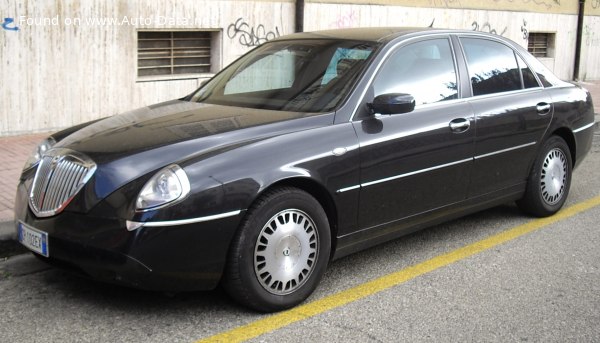
- 3.2 i V6 24V (230 Hp)
- 3.0 V6 (215 Hp)
- 2.4 Multijet 20v (185 Hp) Comfortronic
- 2.4 JTD (175 Hp) Automatic
- 2.4 JTD (175 Hp)
- 2.4 JTD (150 Hp)
- 2.4 20V (170 Hp) Automatic
- 2.4 20V (170 Hp)
- 2.0 20V Turbo (185 Hp)


The story of the mysterious Lancia Thesis
Posted: 9 April 2024 | Last updated: 9 April 2024
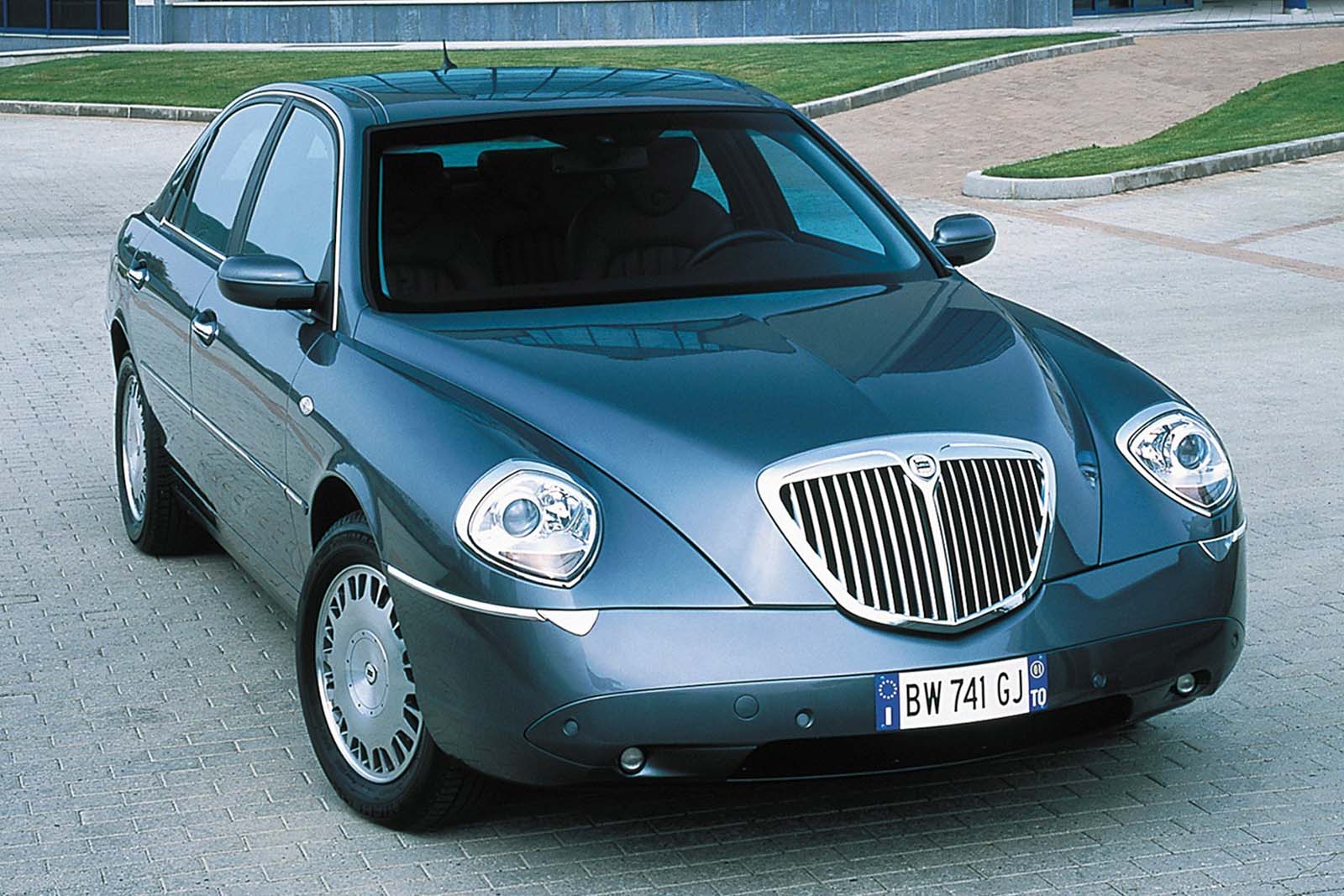
Lancia Thesis
Compared with the Thesis, few cars from Lancia had so much time and money invested in them.
A a car of slightly mysterious allure but plenty of technology, it was developed on its own bespoke chassis and the same sort of suspension used in the Maserati Spyder, Granturismo and Quattroporte . It even had radar-guided cruise control - the first Lancia to do so.
Despite the effort and attention lavished on it to make it a true rival for the BMW 5 Series and Mercedes E-Class , it was dropped from the price list after eight years with less than 20,000 produced.
We therefore thought it best to find out why, partly because it has never been sold in the UK, partly because it’s a relatively rare sight even in its native Italy, and partly because it looks a little weird.
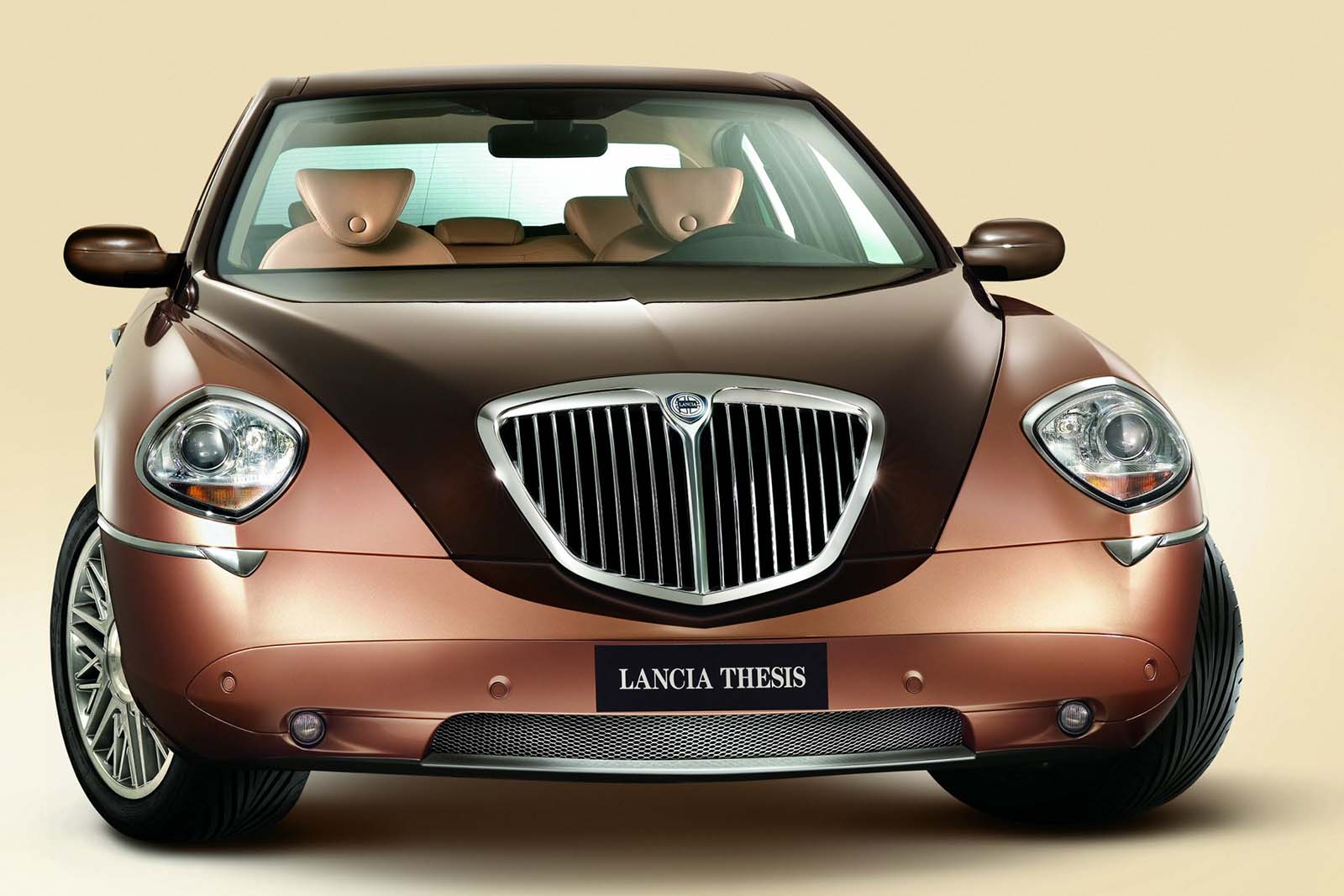
Front end design
From the front i ts chrome Lancia grille resembles a medieval shield, and from the rear, where the translucent glow of some rather gothic tail-lights give it a look like no other car on the road.
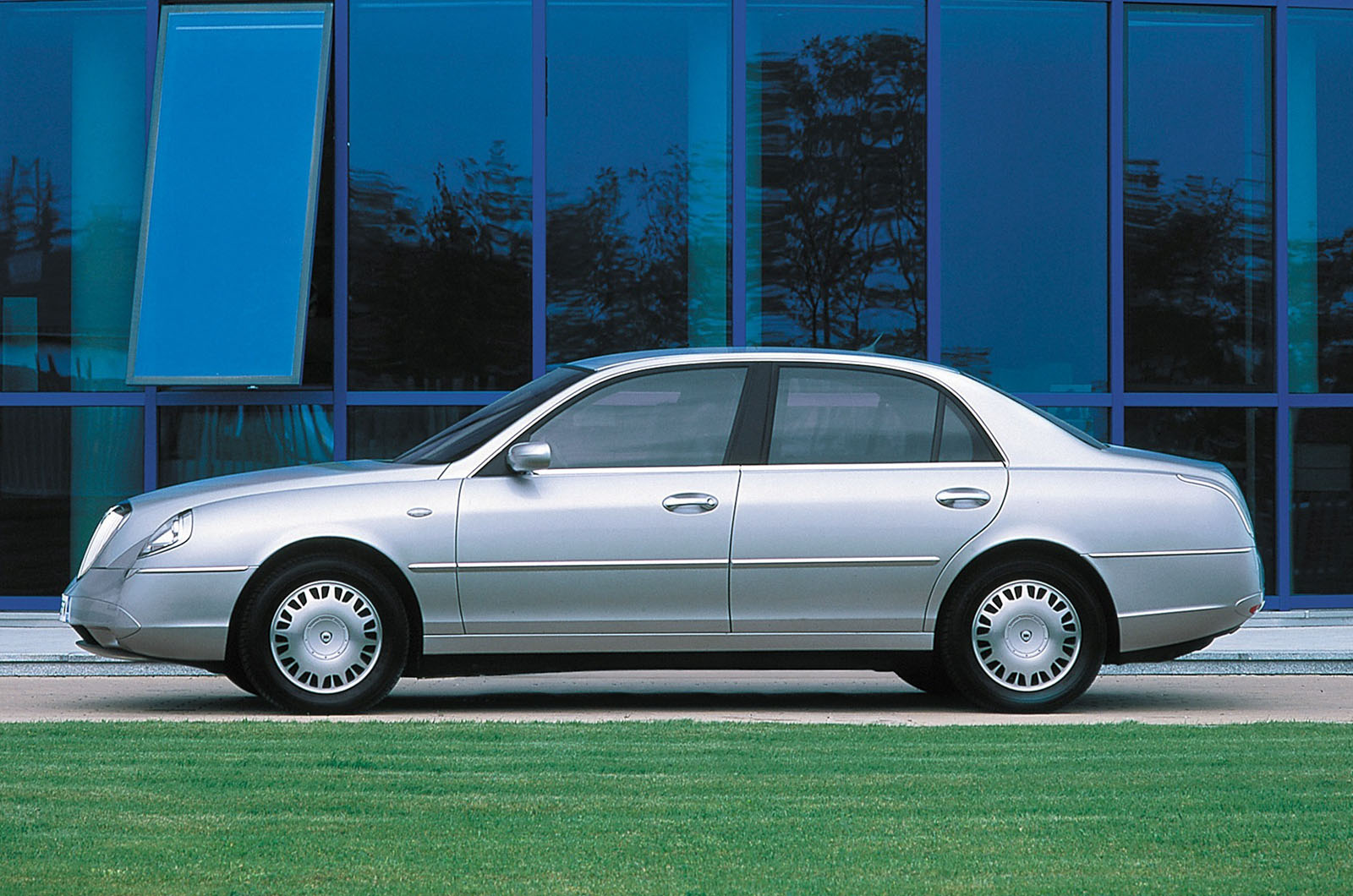
Piggy in the middle
From the side, however, the Thesis is a car of three parts, its distinctive nose and tail sandwiching one of the dullest centre sections of any executive car on the road. Which is a pity.
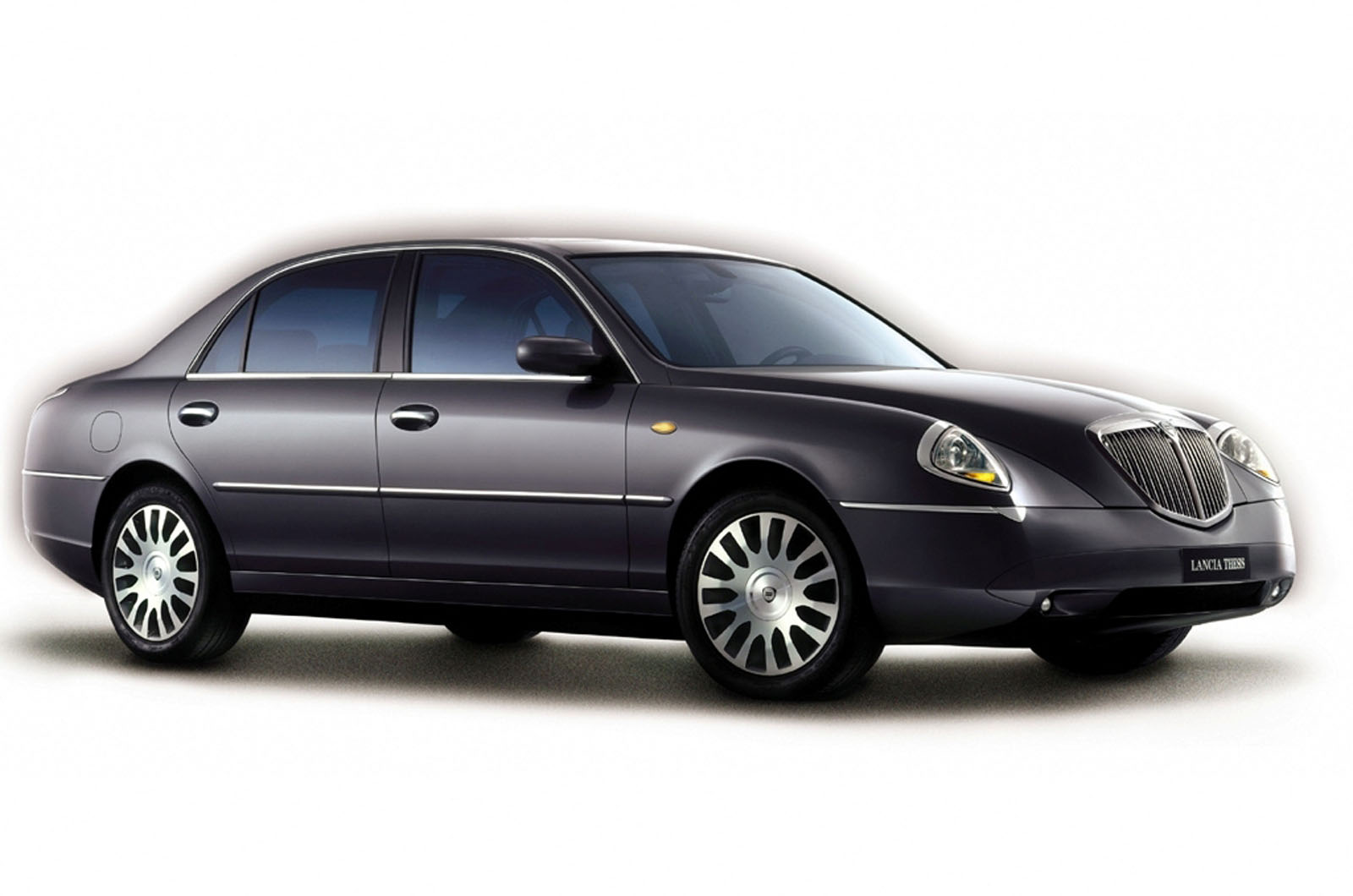
Such dullness is all the more disappointing given the design origins of the Thesis – pronounced ‘tay-sis’, rather than as per the lengthy academic tract - which stemmed from a striking 1998 concept called Dialogos.
This car’s clean flanks, wooden floor, subtly sculpted dashboard and suicide-rear-doors promised something refreshing, but Lancia’s nerve faltered, the production version trading the subtle curviness of the original vision for banality instead.
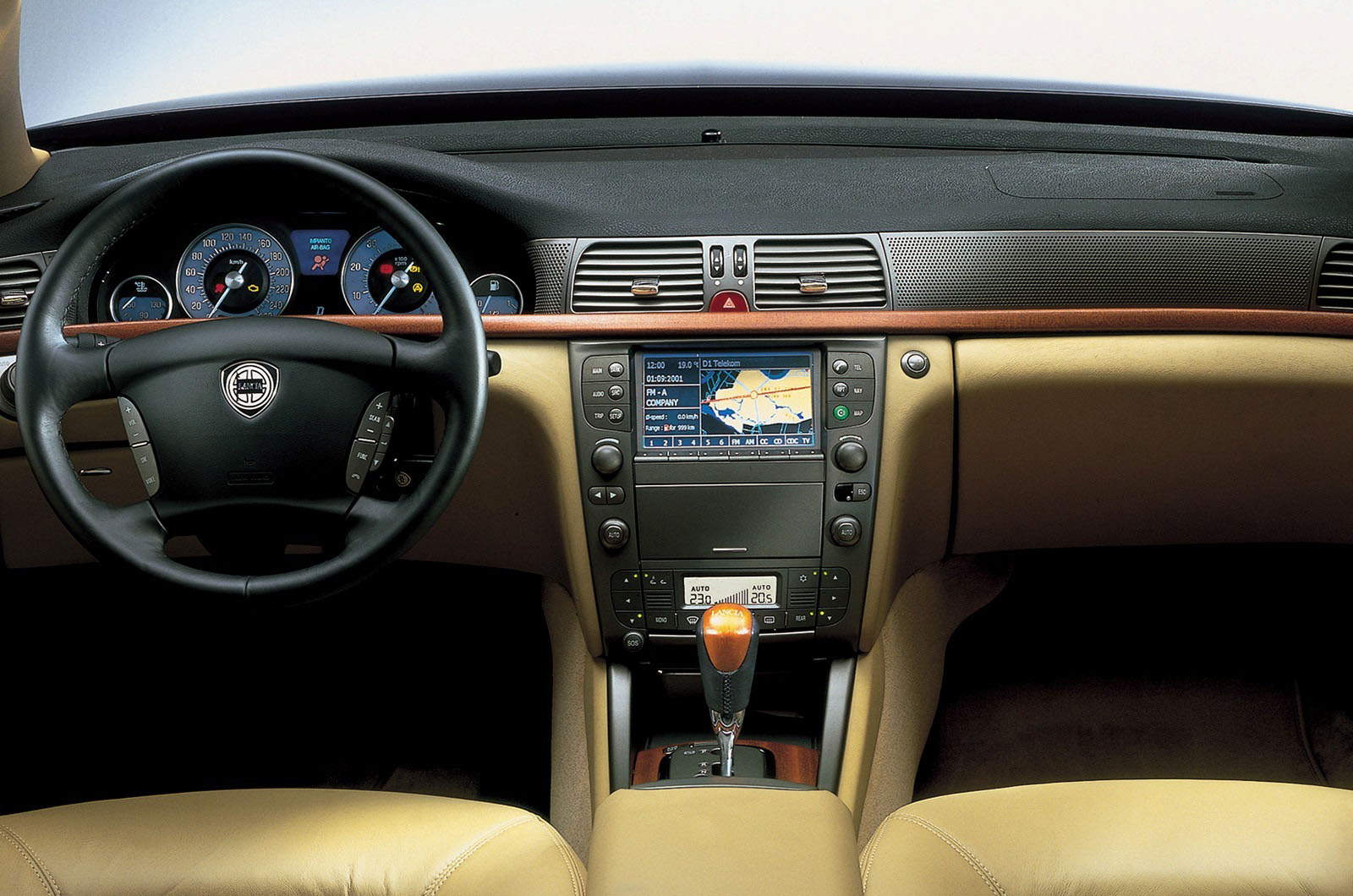
Beauty on the inside
Given that Lancia’s biggest barely registers on any sales graph featuring the 5 Series, E Class and A6 , it might just as well have gone the whole way and produced something really different.
Especially as the Thesis feels pretty special inside, despite the loss of the concept’s (admittedly impractical) wooden floor and smooth-contoured seating.
Sparely deployed wood, cream-faced instruments and richly upholstered seats make this Lancia a car you want to get in as do the heated and cooled massage seats that can be optionally installed front and rear.
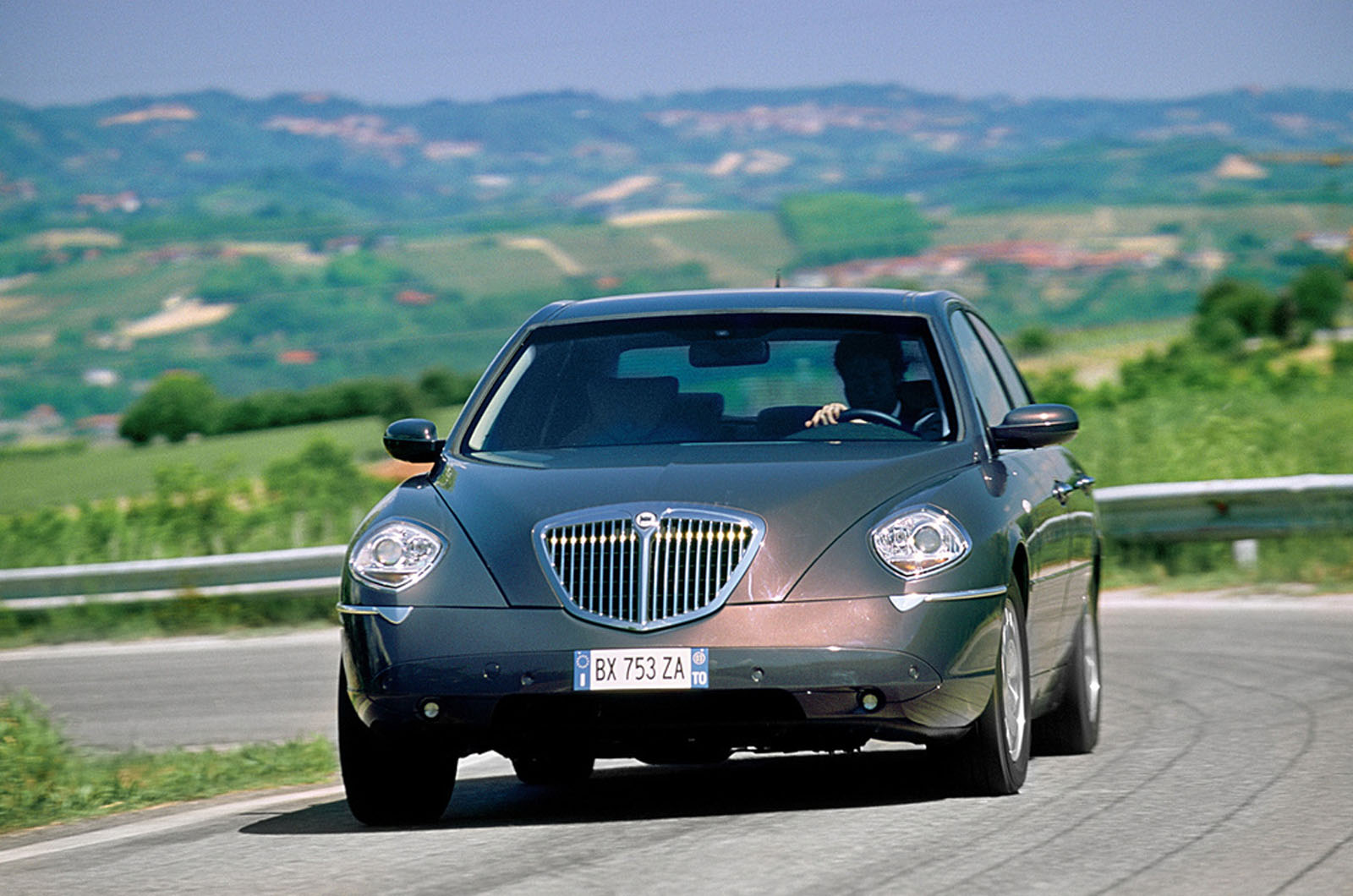
Forbidden fruit
The Thesis’s non-availability in the UK meant that I had a long wait, after its 2001 launch, before sampling its charms, and then only as a passenger. But that was enough to discover whether it was burdened with a problem afflicting almost every Fiat Auto product of the day, which was an inability to absorb sharp, transverse ridges like motorway expansion strips without firing a creaky judder through the dashboard.
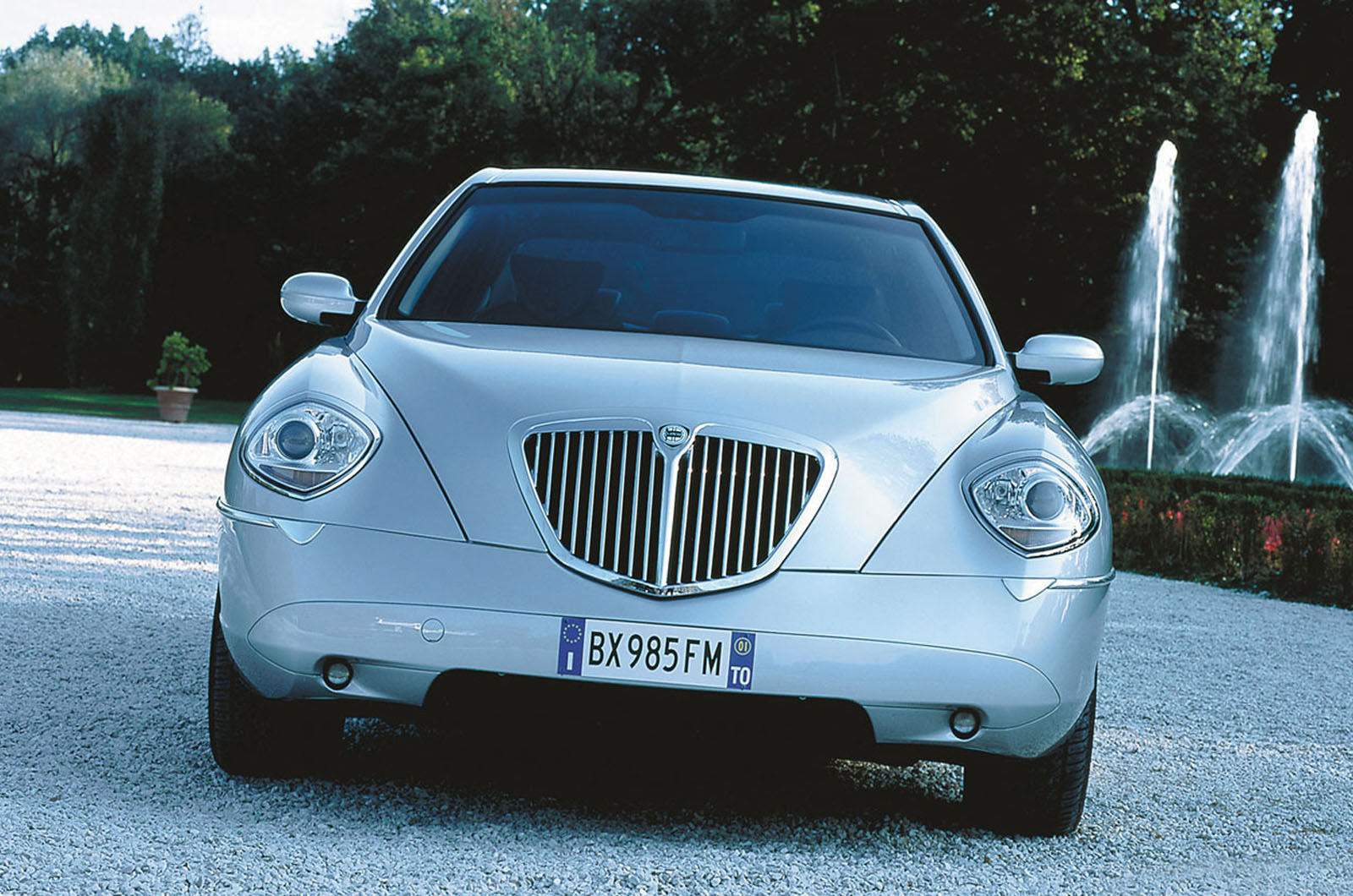
Disappointment
That might sound a ludicrously arcane basis on which to judge a car, but the aura of mild flimsiness provoked by this flaw was one I hoped this more substantially assembled Lancia would be free of. Within minutes of climbing aboard a Thesis at Turin airport I had my answer – it soon hit an autostrada expansion strip, and I heard the faint plastic crack of a dashboard quivering with a tremor that the suspension had failed to suppress. Oh, the disappointment.
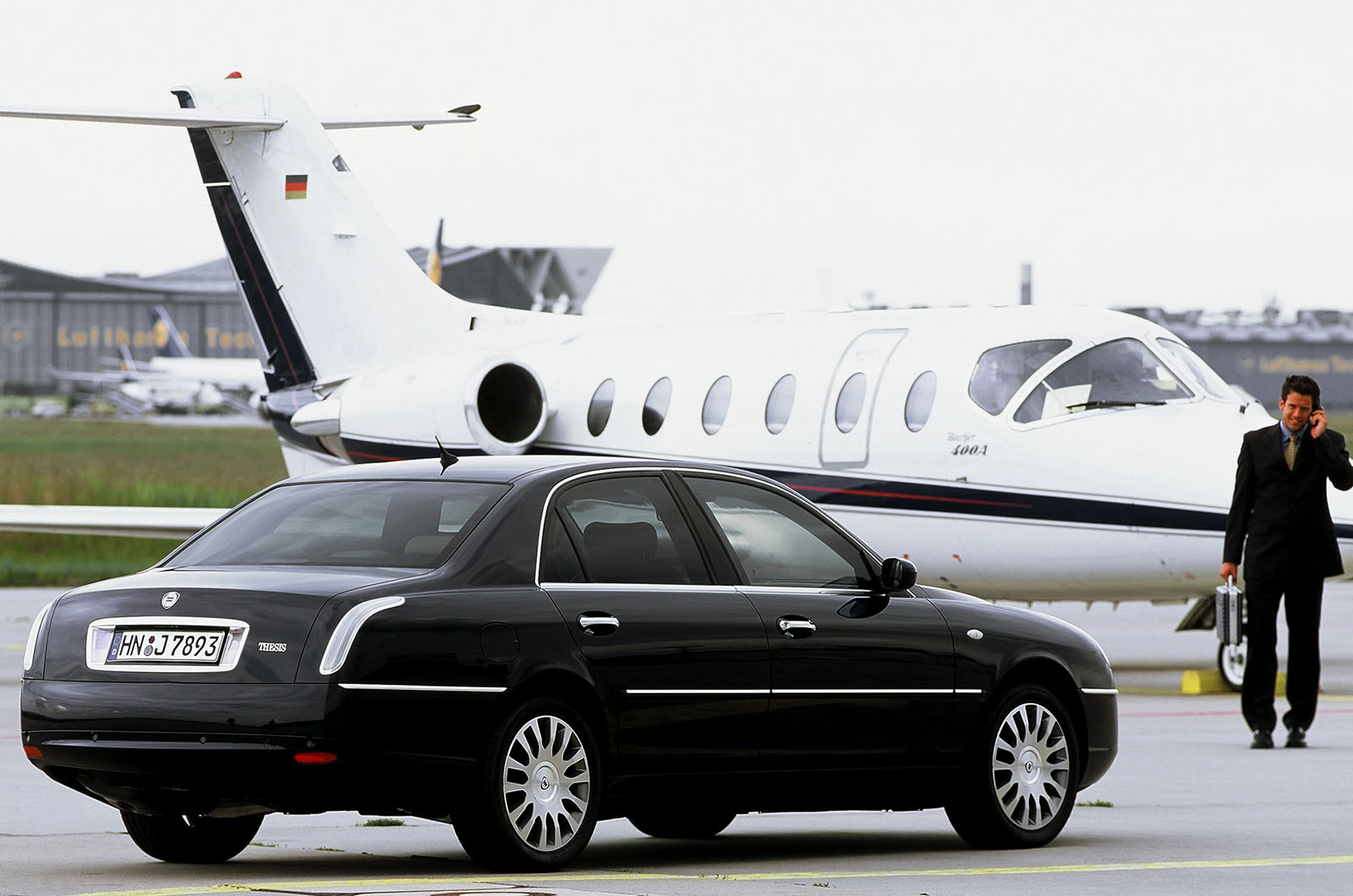
Mild yearning
A couple of years later I got to actually drive a Thesis, and discovered a car not much more able in the bend-bashing department. But those beguiling tail-lights and that classy Italian cabin make this a saloon that I have a mild yearning for - especially as they're so rare.
Consequently we couldn't find any Thesis' for sale in the UK today. But in Italy cars are available at less than €10,000 for a clean example. Tempted?
More for You
TV doctor Michael Mosley goes missing while on holiday in Greece
Your car may be spying on you – and can expose what you did in a crash
'Nationally distributed' food item believed to be behind UK-wide E. coli outbreak
Senior Tories demand action on inheritance tax as record 190,000 families face bills
Carlos Sainz and Red Bull plot twist emerges with Christian Horner ‘clear winner’
Giant structure found in deep space throws our understanding of the universe into doubt
Why is Britain’s mental health so incredibly poor? It’s because our society is spiralling backwards
I tried charging an EV at home and it was a shock I wasn't expecting
48 small backyard ideas that will transform even the tiniest of spaces
Traffic lights could be getting a new colour
F1 unveils new ‘nimble’ car for 2026 in FIA announcement
The healthiest convenience foods and the ones to avoid – from baked beans to supermarket bread
Michael Gove's landlord evicts him from his house
Prince Harry wins right to challenge UK police protection ruling
Most Dutch people cycle every week. How did the low country make it a national pastime?
Why Manchester City are suing the Premier League explained
Carlos Sainz and Red Bull plot twist uncovered and Williams’ ‘major coup’ – F1 news round-up
One Tech Tip: Protecting your car from the growing risk of keyless vehicle thefts
Which Clubs To Use For Different Chipping Techniques On The Golf Green
Cupra Tavascan review: the electric car that aims to spice up the family SUV market
202206 - AUTOMATIC TRANSMISSION
Specifications of the 55-50 sn automatic transmission, five speed compact automatic transmission with front wheel drive.

Addition of new functions
Adoption of built in oil cooling device.
- Reduction in the number of parts on the vehicle (thanks to the simplification of the cooling circuit).
- Stabilization of the fluid level by adopting a differential unit supplied together with the automatic transmission fluid.
- Possibility of controlling the temperature of the automatic transmission fluid.
- Improved reliability, in terms of fluid leaks, thanks to the automatic transmission having no fluid circuit.
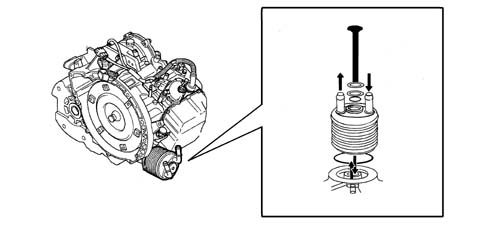
ELECTRONIC CONTROL SYSTEM (CONTROL MODULE FOR TRANSMISSION AND ELECTRONIC COMPONENTS)
Specifications.
- Up hill: when driving uphill, the control unit compares the actual acceleration of the vehicle with the theoretical acceleration on a flat road, thereby determining the gradient of the road. It selects the change law and the most suitable ratio according to the gradient.
- Down hill: when the control unit detects that the vehicle is accelerating with the throttle closed (descent) and is capable of estimating that by changing down a gear the vehicle will no longer be accelerating, it changes down a gear the first time the brake is operated.
- the sensors/actuators fitted on the gearbox for acquiring the operating conditions and the operation of the clutches and brakes;
- the injection/ignition control unit for the exchange of information relating to the engine;
- the instrument panel for displaying the operating conditions.
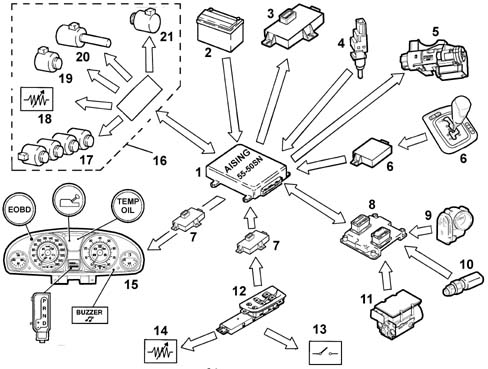
ELECTRONIC COMPONENTS
Switch for starting in neutral (nsw).

Gearbox solenoids 1, 2, 3, 4, 5 (S1, S2, S3, S4, S5)
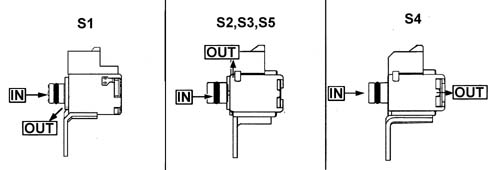
Input and output speed sensor (active sensors)

Differences between active sensor and impulse sensor
- this sensor has an integrated Hall circuit that manages the rectangular wave signal producing energy and transmitting the signal to the automatic transmission control unit exploiting the Hall effect. The automatic transmission control unit recognizes the signal in relation to the speed of the vehicle. The specifications of the output signal are fixed and do not therefore depend on the number of revs.
- strong signal for noise
- there may also be a low number of revs (10 rpm).
- as a result of the rotation of the gear, a sinusoidal wave with an induction electro-motive force is produced, in relation to the speed of the vehicle, which is then sent to the automatic transmission control unit. The control unit converts the wave signal into an impulse signal and recognizes it in relation to the speed of the vehicle. The specifications of the output signal depend on the number of revs.
- the minimum number of revs that can be detected is 50 rpm.
Oil temperature sensor

Linear pressure control solenoid (SLT)

Lock-up clutch control solenoid (SLU)
- Engine brake: Brake B3
- Control of neutral (N): Brake B2.
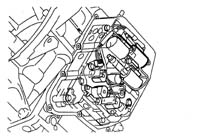
Gearbox pressure control solenoid (SLS)
- control of 2nd, 3rd, 4th speeds and neutral (N): brake B1
- control of 5th speed and reverse gear: clutch C2
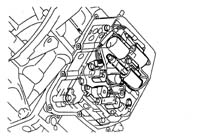
Transmission drive gear

Automatic transmission control unit control functions
Adaptive control of gear change by the driver (economy, regular and sports modes), uphill modes 1, 2, downhill mode.
Skip to content
- Home Board index Lancia forums in English 40 Thesis
- Topics Replies Views Last post
- Dual Mass Flywheel" for a Thesis Turbo 2.0 * 2003 by Space » Tue Apr 18, 2023 11:26 pm 2 Replies 1037 Views Last post by kandreoamreo Sat Feb 10, 2024 7:20 am
- Mirror glass removal by dnapekko » Thu Dec 29, 2022 11:40 am 2 Replies 887 Views Last post by MerleFord Fri Aug 11, 2023 4:39 am
- Thesis Executive Poltrona Frau tobacco 18 inch Centenario 2.4 20V automatic by ScuderiaLancia » Fri Jan 06, 2023 9:21 am 0 Replies 955 Views Last post by ScuderiaLancia Fri Jan 06, 2023 9:21 am
- New Loudlink Bluetooth car kit firmware for Lancia Thesis V3.0.4.2 by arnoldf » Wed Dec 14, 2022 12:09 pm 0 Replies 830 Views Last post by arnoldf Wed Dec 14, 2022 12:09 pm
- EPB broken (again) by BartW » Wed Sep 28, 2022 8:08 pm 0 Replies 1075 Views Last post by BartW Wed Sep 28, 2022 8:08 pm
- Looking for software update of the infotainment by cmvrgr » Sun Feb 20, 2022 2:35 pm 3 Replies 1761 Views Last post by daniel_l Sat Sep 03, 2022 10:13 am
- Dusk and rain sensor problem solved by Isola » Wed May 11, 2022 6:21 pm 0 Replies 1287 Views Last post by Isola Wed May 11, 2022 6:21 pm
- Loudlink Bluetooth car kit new firmware for Lancia Thesis - version: V3.0.4.0 by arnoldf » Fri Jun 25, 2021 10:52 am 0 Replies 1278 Views Last post by arnoldf Fri Jun 25, 2021 10:52 am
- Lancia Thesis 2.4jtd common problems by vtr » Wed Jun 09, 2021 3:21 pm 0 Replies 1351 Views Last post by vtr Wed Jun 09, 2021 3:21 pm
- Lancia Thesis 2,4 JTD, r.v 2003, how to open car?? by PanMacho » Fri Jan 29, 2021 2:32 pm 2 Replies 2373 Views Last post by hartzler Fri Mar 12, 2021 11:59 am
- Lancia thesis 2.4 ECU needed by Baissou82 » Tue Aug 04, 2020 9:08 pm 1 Replies 3449 Views Last post by 1608cc Sun Sep 13, 2020 4:59 pm
- aisin 55-50 volvo renault thesis opel? by agusthesis » Tue Mar 17, 2015 8:50 pm 7 Replies 8571 Views Last post by cavaradossi Mon Apr 20, 2020 7:43 am
- Thesis 2.4 mjtd gearbox support options by alaala » Sun Apr 19, 2020 7:59 pm 0 Replies 3686 Views Last post by alaala Sun Apr 19, 2020 7:59 pm
- Clutch Master Cylinder by Chops130 » Wed Mar 18, 2020 10:35 pm 0 Replies 4870 Views Last post by Chops130 Wed Mar 18, 2020 10:35 pm
- lancia thesis rear boot (trunk) problem by Tono92 » Thu Nov 14, 2019 11:00 pm 0 Replies 4287 Views Last post by Tono92 Thu Nov 14, 2019 11:00 pm
- Turbo pressure by alfaulf » Wed Aug 07, 2019 10:30 am 2 Replies 4915 Views Last post by alfaulf Mon Aug 12, 2019 6:41 am
- Fensterheber und servoleitung by Klaus Kurve » Mon Mar 25, 2019 4:01 pm 1 Replies 4481 Views Last post by Koen Mon Mar 25, 2019 7:27 pm
- Fensterheber und servoleitung by Klaus Kurve » Mon Mar 25, 2019 3:59 pm 0 Replies 4340 Views Last post by Klaus Kurve Mon Mar 25, 2019 3:59 pm
- Parts from centenario by vlad47 » Fri Mar 08, 2019 4:14 pm 0 Replies 4550 Views Last post by vlad47 Fri Mar 08, 2019 4:14 pm
- Looking for ACC Radar sensor by 1608cc » Sun Jan 27, 2019 12:56 pm 0 Replies 4536 Views Last post by 1608cc Sun Jan 27, 2019 12:56 pm
- Air Conditioning - Rear Button Problem by Teza » Wed Apr 11, 2018 11:24 pm 6 Replies 5964 Views Last post by Teza Mon Oct 29, 2018 11:38 pm
- ABS error on MES C1085 by kicbe » Fri Aug 17, 2018 9:11 pm 0 Replies 4543 Views Last post by kicbe Fri Aug 17, 2018 9:11 pm
- Seat adjustments not working by Isola » Sat Jun 03, 2017 6:10 pm 2 Replies 6020 Views Last post by Isola Fri May 18, 2018 7:16 am
- Source for suspension parts by Isola » Fri May 18, 2018 7:07 am 0 Replies 4936 Views Last post by Isola Fri May 18, 2018 7:07 am
Return to Board Index
- Forum Viva-Lancia Italia
- ↳ Regolamento e Staff
- ↳ Modelli Lancia (dal 1906 ad oggi)
- ↳ Modelli dal 1906 all'Ardea
- ↳ Aurelia, D20/D23/D24/D50
- ↳ Appia
- ↳ Flaminia
- ↳ Flavia e "2000"
- ↳ Fulvia
- ↳ Beta
- ↳ Stratos
- ↳ Beta Montecarlo
- ↳ Gamma
- ↳ Delta e Prisma
- ↳ Rally 037
- ↳ Thema
- ↳ Y10, Y, Ypsilon
- ↳ Delta Integrali/S4
- ↳ Dedra e Delta "2"
- ↳ Z e Phedra
- ↳ K
- ↳ Lybra
- ↳ Thesis
- ↳ Musa
- ↳ Delta "3"
- ↳ Ypsilon 5p "2011"
- ↳ Chrysler-Lancia
- ↳ Veicoli Industriali Lancia (1912-1970)
- ↳ Veicoli Industriali
- ↳ Jolly e SuperJolly
- ↳ Argomenti generali sulla Lancia
- ↳ Lancia Cafè
- ↳ Raduni, Gare, Fiere, Musei e Convegni
- ↳ Editoria, Modellismo, Automobilia
- ↳ Burocrazia e dintorni
- ↳ Scuderia Lancia corse
- ↳ Lancia-Avvistamenti
- ↳ Museo virtuale Lancia
- ↳ Lambda
- ↳ Astura
- ↳ Artena
- ↳ Aprilia
- ↳ Aurelia
- ↳ Richieste e commenti.
- ↳ Theta
- ↳ Alpha
- ↳ Flavia
- ↳ Esatau
- ↳ Ardea
- ↳ Archivio storico-fotografico
- ↳ Augusta
- ↳ Delta
- ↳ Superjolly
- ↳ 3 Ro
- ↳ Kappa
- ↳ Dilambda
- ↳ Trikappa
- ↳ Altri Marchi
- ↳ MERCATINI
- ↳ Flavia e "2000" : il Mercatino
- ↳ Delta Integrali/S4 : il Mercatino
- ↳ Fulvia : il Mercatino
- ↳ Beta : il Mercatino
- ↳ Altri Marchi : il Mercatino
- ↳ Lybra : il Mercatino
- ↳ Thema : il Mercatino
- ↳ K : il Mercatino
- ↳ Thesis : il Mercatino
- ↳ Z e Phedra: il mercatino
- ↳ Musa: il mercatino
- ↳ Ypsilon: il mercatino
- ↳ GALLERIES
- ↳ Lybra Gallery
- ↳ Thema Gallery
- ↳ Beta e Beta Montecarlo Gallery
- ↳ Thesis Gallery
- ↳ Fulvia Gallery
- ↳ Z e Phedra Gallery
- ↳ Delta Integrali/S4 Gallery
- ↳ Delta "3" Gallery
- ↳ Dal 1906 alle Appia Gallery
- ↳ K Gallery
- ↳ Altri Marchi Gallery
- ↳ Flaminia Gallery
- ↳ Gamma Gallery
- ↳ Y10, Y, Ypsilon, Ypsilon 5p Gallery
- ↳ Musa Gallery
- ↳ Dedra e Delta "2" Gallery
- ↳ Flavia e "2000" Gallery
- ↳ Delta e Prisma Gallery
- ↳ ALTRI ARGOMENTI
- ↳ Fulvia : meccanica e imp.elettrico
- ↳ Fulvia : carrozzeria ed interni
- Lancia Foren auf Deutsch
- ↳ D01 Allgemeiner Gedankenaustausch über Lancia
- ↳ D02 Lancia Café
- ↳ D04 Quiz
- ↳ D07 Events, Treffen
- ↳ D09 Literatur, Automobilia
- ↳ D10 Kompatible E-Teile
- ↳ D12 Flavia "2012"
- ↳ D14 Voyager
- ↳ D16 Thema "2011"
- ↳ D18 Ypsilon 5p "2011"
- ↳ D20 Delta 3. Serie (2008)
- ↳ D25 Musa
- ↳ D30 Thesis
- ↳ D35 Phedra, Zeta
- ↳ D40 Lybra
- ↳ D45 Kappa
- ↳ D50 Thema, Dedra
- ↳ D55 Ypsilon, Y10, A112
- ↳ D60 Delta, Integrale, Prisma
- ↳ D65 Beta, Gamma, Beta Montecarlo
- ↳ D70 Fulvia, Flavia, Flaminia, Stratos
- ↳ D90 Die A-Lancia's und alter
- Lancia fora in het Nederlands
- ↳ NL02 Algemene discussie over Lancia
- ↳ NL05 Lancia in Nederland
- ↳ NL10 Lancia in Belgie
- ↳ NL11 Lancia Café
- ↳ NL12 Historische Rallies op Lancia
- ↳ NL25 Delta 3 (vanaf 2008)
- ↳ NL30 Musa
- ↳ NL35 Thesis
- ↳ NL40 Phedra, Zeta
- ↳ NL45 Lybra
- ↳ NL50 Kappa. Technische zaken.
- ↳ NL51 Kappa. Wetenswaardigheden en meetings.
- ↳ NL52 Kappa. Te koop / gevraagd.
- ↳ NL60 Thema, Dedra
- ↳ NL65 Ypsilon, Y10, A112
- ↳ NL70 Delta, Integrale, Prisma
- ↳ NL80 Beta, Gamma, Monte Carlo
- ↳ NL85 Fulvia, Flavia, Flaminia, Stratos
- ↳ NL86 Fulvia, Flavia, Flaminia te koop / gevraagd
- ↳ NL90 De A- Lancia's en ouder
- Phedra 's Piazza
- ↳ Phedra 's Piazza
- Lancia forums in English
- ↳ 01 General Lancia discussions and forum messages
- ↳ 20 Historic Rallies on Lancia
- ↳ 40 Thesis
- ↳ 43 Phedra
- ↳ 45 Lybra
- ↳ 47 Kappa
- ↳ 49 Ypsilon, Y10
- ↳ 51 Thema
- ↳ 53 Gamma
- ↳ 55 Dedra
- ↳ 57 Delta, Prisma, Delta Integrale
- ↳ 59 Montecarlo, Scorpion
- ↳ 61 Beta, Beta spider, Beta Zagato, Trevi
- ↳ 63 Stratos
- ↳ 65 Fulvia
- ↳ 68 Flavia, Lancia 2000
- ↳ 70 Flaminia
- ↳ 75 Early Cars
- ↳ 80 Other Lancia passenger, rally and F1 cars
- ↳ 85 Lancia trucks and busses
- ↳ 90 Books / Pictures / Video's on Lancia
- Forum Lancia en Français
- ↳ F01 Discussion générale sur Lancia
- ↳ F05 Rallyes historiques en Lancia
- ↳ F40 Thesis
- ↳ F45 Phedra
- ↳ F50 Lybra - >elta 3 - Musa
- ↳ F55 Kappa
- ↳ F65 Thema, Dedra
- ↳ F70 Ypsilon, Y10, A112
- ↳ F75 Delta, Integrale, Prisma
- ↳ F80 Beta, Gamma, Monte Carlo
- ↳ F85 Fulvia, Flavia, Flaminia, Stratos
- ↳ F90 A- Lancia's et avant

Forum permissions
You cannot post new topics in this forum You cannot reply to topics in this forum You cannot edit your posts in this forum You cannot delete your posts in this forum You cannot post attachments in this forum
- Home Board index
- All times are UTC
Powered by phpBB ® Forum Software © phpBB Limited
Privacy | Terms

IMAGES
VIDEO
COMMENTS
The Thesis is equipped with 6-speed manual or 5-speed automatic Comfortronic, which is available for all but 2.0 gearboxes. The interior was trimmed with leather or the suede-like Alcantara material long favoured by Lancia. The verdict of Car stated: "If Lancia can be turned around this is the car for the job."
Faced by the collective might of the 5 Series, E-Class and A6, the elegant Lancia would have been lost beneath a deluge of faeces-related quips. "The time is ripe for Thesis," said Lancia in 2001, in a statement unrelated to faecal matter. The Thesis was borne out of the Dialogos concept of 1998, a car with swivelling armchairs rather than ...
In the year 2000, even before the launch of the Thesis, Lancia made a Thesis-based special for the Vatican. The Lancia Giubileo, a 5.5m long armoured landaulet, reminded most observers of the Dialogos, but this one obviously had an engine (an Alfa 3-litre V6) and generally looked a bit different - the grille was a bit less imposing, the rear ...
Compared with the Thesis, few cars from Lancia had so much time and money invested in them. ... The Thesis's non-availability in the UK meant that I had a long wait, after its 2001 launch ...
Lancia's reasoning was probably the same as Rover's: most people are indifferent as to which axle is receiving the power. A 2 litre soft turbo, a 2.4 litre 20 valver and a 3.0 V6 24 valve engine made up the petrol burning range. A 2.4 JTD diesel was also available. The suspension design was a mix of the ordinary and the clever.
2001-2009 Lancia Thesis Designed by: Michael Vernon Robinson at Centro Stile Lancia. Interior design Flavio Manzoni. Tipo 841 Number made: 16,718 approx. First VIN ... it takes its inspiration from tradition yet points to the future. The result is a big, five-metre long deluxe car with retro hints: high front, long bonnet, upturned wedge-shaped ...
Thesis, the last true Lancia. 14 April 2020. 2 min read. 4 images. In 2002 with the Thesis, Lancia launched a valid attempt to return once again to the place it rightly deserved in the annuals of the automobile. The endeavour was inaugurated through a new flagship concept that offered a brave and very astute mix of the past and present and ...
Thesis was supposed to support an effort to push Lancia sales from just one hundred and fifty thousand in 2001, to three hundred thousand by 2008. However, Thesis failed to hit even the modest sales goals Lancia had set for it: a mere thirteen thousand and two hundred units in 2002, and hopes for twenty-five thousand in 2003.
The Thesis is equipped with 6-speed manual or 5-speed automatic Comfortronic, which is available for all but 2.0 gearboxes. The interior was trimmed with leather or the suede-like Alcantara material long favoured by Lancia. The verdict of Car stated: "If Lancia can be turned around this is the car for the job."
Lancia Thesis. Continuing the relaunch of the Lancia brand and taking up position at the pinnacle of the Fiat Groups automotive portfolio, the new Thesis (internally, Project 841) was officially released at the Geneva Motorshow at the beginning of March 2001. ... I wish the Lancia Thesis has long life, a lot of sales, and meanwhile I will wait ...
Unfortunately, the battle in which Lancia entered the Thesis was a losing one. Customers continually and reliably chose the established German players instead of the Thesis. By the time it went out of production in 2009, it was long overdue for replacement — and the brass at FCA had just the ticket! 2011 brought an all-new Thema, courtesy of ...
Fiat wants this Lancia to swim with the likes of the Mercedes-Benz E- and S-Class, BMW 5 and 7 Series, and Audi A6 and A8. The full-year sales goal is a modest 25,000 in a sector doing about a ...
The Lancia Thesis was produced by the Italian manufacturer Lancia between 2001 - 2009. It's a front engined front-wheel drive Saloon. There are many power levels available, ranging from a 148 BHP 2.4 L Inline 5 Turbo diesel engine to a 227 BHP 3.2 L V6 petrol engine. It has double wishbone suspension front and rear.
Technical specs and performance data for the Lancia Thesis 3.2 V6 24v (2003-2007) Technical specifications for the 2003-2007 Lancia Thesis 3.2 V6 24v 4 door saloon. Find & compare performance, practicality, chassis, brakes, top speed, acceleration, suspension, engine, weights, luggage & more.
Lancia Thesis. 2002 - 2009 Sedan. Power: from 150 to 230 Hp | Dimensions: 4890 x 1830 x 1470 mm.
Lancia Thesis For Sale. Save search Popular searches List All • Lancia Parts . 037 • 2000 • appia • aprilia • ardea • aurelia • aurelia b20 gt • beta • beta coupe • convertible • coupe • delta • delta evo • delta integrale • dilambda • evo • flaminia • flavia ...
What is the drivetrain, Lancia Thesis Sedan 2003 3.2 i V6 24V (230 Hp)? Front wheel drive. Internal Combustion engine. The Internal combustion engine (ICE) drives the front wheels of the vehicle. How long is this vehicle, 2003 Lancia Thesis Sedan? 4890 mm 192.52 in. How wide is the vehicle, 2003 Lancia Thesis Sedan? 1830 mm 72.05 in.
SPECIFICATIONS. This is a multilink suspension improved and compacted for the rear suspension used on the Alfa Romeo 166 and the first example of modular suspension. The diagram below illustrates how the suspension closes completely on the crossmember which forms a connection with the bodyshell The construction design consists of: Interface ...
The mysterious Lancia Thesis. Richard Bremner. ... The Thesis's non-availability in the UK meant that I had a long wait, after its 2001 launch, before sampling its charms, and then only as a ...
The 55-50 SN automatic transmission has a five speed gearbox with a new epicyclic gear train added to the four speed automatic gearbox, maintaining the same overall length and the same distance between the axles. It is also more compact and has a greater capacity compared with the transmission fitted on conventional vehicles.
Lancia ThesisYear: 2004Price: 14 000$Engine: 2.4TD 175 hp, 380 Nm of torqueTransmission: 5 - speed Automatic, Front wheel drive0-100 km/h : 10.200:00 Exterio...
Lancia Thesis 2.4 jtd Multijet 20v Executive Comfortronic 129 kW (175 PS) bei 4000 U/min 215/60R16 95W (5-Loch Felge) Fg.-Nr. 00009390 Motor-Nr. 3642911 Organisations-Nr. 00007796 Aussenfarbe 657 Innenfarbe 615 Datum erste Zuweisung 31.05.2003 Datum letzte Zuweisung 31.05.2003 CCF-Datum 14.05.2004
Thesis strange electronic troubles. by Pierre VALLADE » Thu Oct 01, 2009 1:43 pm. 1. 2. 15 Replies. 19500 Views. Last post by peterb123. Sun Jan 09, 2022 4:46 pm.
Voyager Therapeutics is focusing on gene-based therapies for neurological conditions and shows strong potential for long-term investors. ... TAU01) Strengthens Investment Thesis. Jun. 05, 2024 11: ...